Paul van Yperen's Blog, page 154
July 19, 2021
Quo vadis?
EFSP is back in Bologna, Italy, for Cinema Ritrovato 2021. Finally! Till the end of the festival, our blog posts will be connected to the festival programme. Within 'The Century of Cinema: 1901', Cinema Ritrovato presents Ferdinand Zecca’s silent short Quo vadis? (1901) produced by Pathé Frères. On this occasion, Ivo Blom selected a series of postcards and additional materials on stage and screen adaptations of Henryk Sienkiewicz’s famous novel 'Quo vadis?', as well as some early 20th century illustrated postcards. Another early adaptation is the silent Italian epic Quo vadis? (Enrico Guazzoni, 1913) produced by the Cines. Worldwide, the film was the biggest box-office hit of the year. The film had many relaunches, all through the silent era.

Italian postcard. Photo: Cines. Publicity still for Quo vadis? (Enrico Guazzoni, 1913). Caption: The death of the gladiator. This image cites Jean-Léon Gérôme's famous painting 'Pollice verso' (Thumbs down, 1872) and was often used in the publicity for the film. In the back, the emperor Nero (Carlo Cattaneo) makes the sign of thumbs down, a sign for the conqueror to kill his adversary. Flanking Nero are left Tigellinus (Cesare Moltroni) and right Petronius ( Gustavo Serena ). Left of the imperial box the Vestal Virgins are seated.

German postcard by Ross-Verlag, Berlin, no. 699/6, 1919-1924. Photo: Filmhaus Bruckmann. Rina de Liguoro in Quo vadis? (Gabriellino D'Annunzio, Georg Jacoby, 1924).
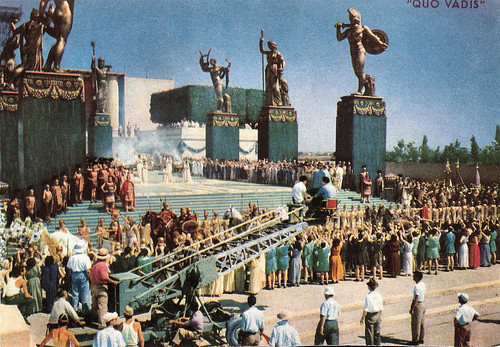
Italian postcard by A. Mondadori, Verona. Photo: MGM. Publicity still for Quo Vadis (Mervyn LeRoy, Anthony Mann, 1951). Caption: In Rome, Italy, Technicolor cameras film a scene for M.G.M.'s Quo Vadis. Roman soldiers parade before Nero's palace here.
Meanwhile, the city of Rome starts to burn…
The French translation of the novel 'Quo vadis?' appeared in 1900, and the following year Pathé produced the first cinematographic adaptation, Quo vadis? (Ferdinand Zecca, 1901).
From a Pathé catalogue (March 1902): "'Quo vadis?' is certainly one of the greatest literary successes of our time. This work has been translated into every language and printed in millions of copies. It is a novelty, so to speak, which we cannot allow to escape us. To try and adapt the whole book would be pretentious and impossible; so we have selected the most interesting scenes and arranged them in one film."
Actually, the director Ferdinand Zecca compressed the first part of the novel into one single take depicting two major scenes: the feast of Nero and the burning of Rome. Considered lost for many years, an almost complete print was rediscovered and preserved by CNC Archives Françaises du Film, and first shown in 2016 at Cinema Ritrovato within the framework of the Antiquity and Early Cinema workshop which Ivo Blom, Maria Wyke, and others organised.
The visitors of the imperial banquet are treated to a gladiator fight, in which the popular 1872 painting 'Pollice Verso' by Jean-Léon Gérôme is partly re-enacted. The same painting was explicitly cited in the 1913 version of Quo Vadis? as well as two other paintings by Gérôme: 'The Christian Martyrs’ Last Prayer' and 'Ave Caesar'.
'Pollice verso' would also be the starting point for Ridley Scott’s epic Gladiator (2000). Then, when in the 1901 version Vinicius becomes too pushy towards Lygia, the strongman Ursus enters and abducts her. Meanwhile, the city of Rome starts to burn… Despite the rash reduction of the novel, Zecca’s film version was shown for a few years around the globe.

German-Polish postcard by Verlag A. Raczynski, Krakow, 1906 / Farbenlichtdruck Martin Rommel, Stuttgart, no. 6. Artwork: Piotr Stachiewicz, 'The banquet at Nero's'. The first illustrations of Stachiewicz's work appeared in magazines from 1896 onward, while postcards were reissued many times between 1900 and 1930. He was the favourite illustrator of the novelist Henryk Sienkiewicz.
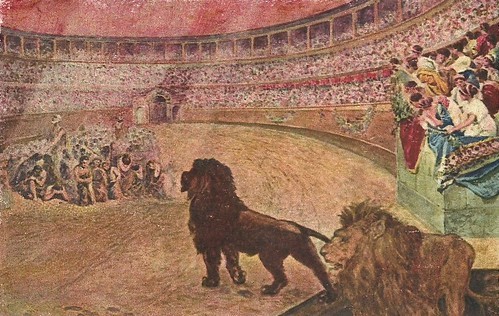
Italian postcard Ed. E. Sborgi, Firenze. Artwork: A. Del Senno, 'Cristiani al martirio'. The composition is a mirrored version of Jean-Léon Gérôme's painting 'The Christian Martyrs' Last Prayer'.
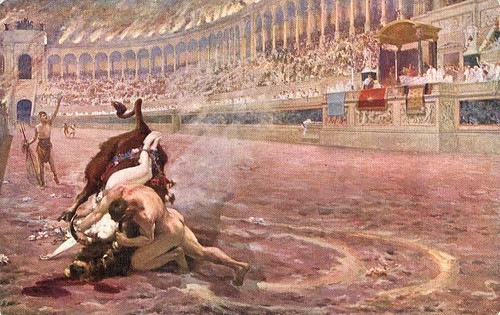
French postcard by J. Lapina & Cie, Paris, no. 25. 311. Artwork: Jan Styka, 'Quo vadis? (Ursus' battle with the bull)'. The French editor Flammmarion commissioned Jan Styka to design 150 etchings for a three-part deluxe edition (1901-1903) of the novel 'Quo vadis?'. A large postcard series was derived from this.

Polish postcard by ed. Krakow 1903. Publicity still of a Polish stage version of 'Quo vadis?'. Lygia pleas Ursus not to kill Vinicius. On the left, the dead gladiator Croton, who was supposed to kill Ursus, while Vinicius would abduct then Lygia. On the right, the treacherous Chilon observes the scene.
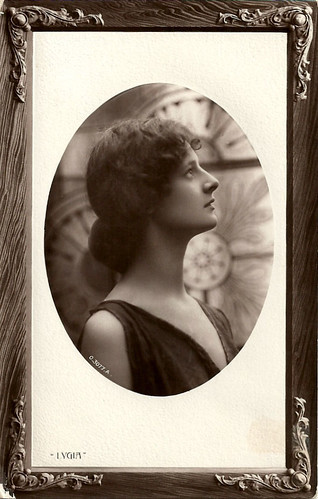
British postcard in the Opalette Series by Rotary Photo E.C., no. O.3077.A. Australian actress Mab Paul as Lygia in a British stage play version of 'Quo vadis?' based on the novel by Henryk Sienkiewicz. As Paul left the UK in 1910 to head back to Australia, this might be a pre-1910 card.
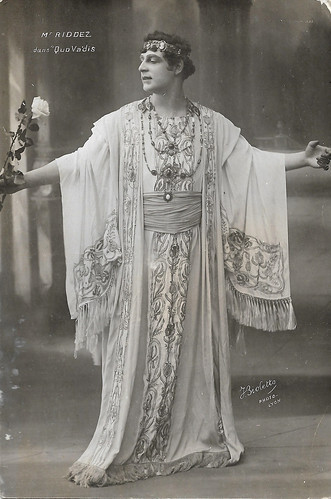
French postcard. Photo: J. Bioletto, Lyon. Jean Riddez as Vinicius in the opera 'Quo vadis?' (1909) by Jean Nouguès, libretto by Henri Cain.
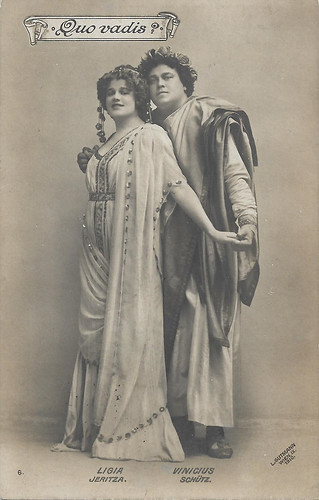
Austrian postcard, no. 6. Photo: Ludwig Gutmann, Vienna, Sept. 1910. Maria Jeritza as Lygia and Theodor Schütz as Vinicius in the opera 'Quo vadis?' at the Wiener Volksoper 1910.
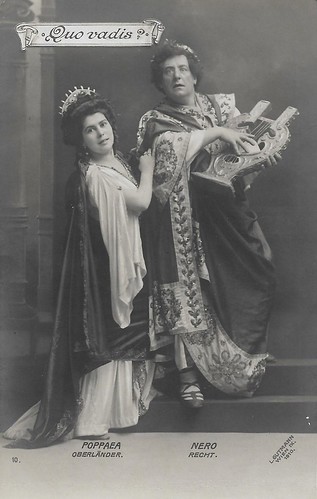
Austrian postcard, no. 10. Photo: Ludwig Gutmann, Vienna, Sept. 1910. Mr. Recht as Nero and Helene Oberländer as Poppaea in the opera 'Quo vadis?' at the Wiener Volksoper 1910.
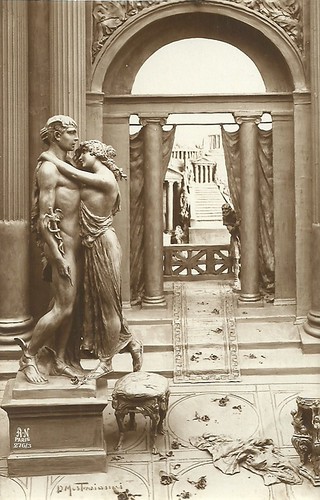
French postcard by A.N. (Armand Noyer), Paris, no. 276/3. Sculptography: Domenico Mastroianni, 1913.
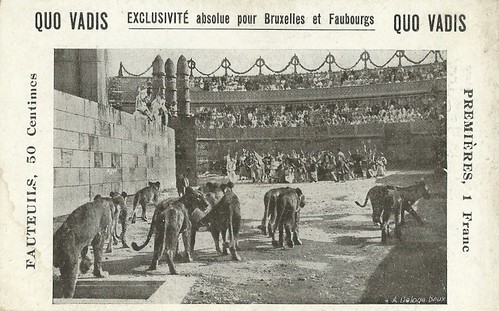
Belgian postcard by Ed. A. Deloga, Bruxelles. Photo: Cines. Publicity still for Quo vadis? (Enrico Guazzoni, 1913). On 18 July (year unknown) the Brussels cinema Majestic, 62, Boulevard du Nord (now Boulevard Adolphe Max), re-released the Italian silent epic Quo vadis? (Enrico Guazzoni, 1913) because, as the postcard says, of general demand. The film took 2 hours, which was quite long for those years, and was shown integrally, with a new musical score. The still depicted is a citation from Jean-Léon Gérôme's well-known painting 'The Christian Martyr's Last Prayers' (1883). It was much recycled in the publicity for the film, on posters, in brochures, and in advertisements in magazines.

Italian postcard. Photo: Cines. Publicity still for Quo vadis? (Enrico Guazzoni, 1913). Caption: "Ave Caesar, those who are about to die, salute you."
This image cites a famous 19th-century painting (1859) by Jean-Léon Gérôme. It was often quoted, also in the Asterix comics, see Asterix the gladiator.
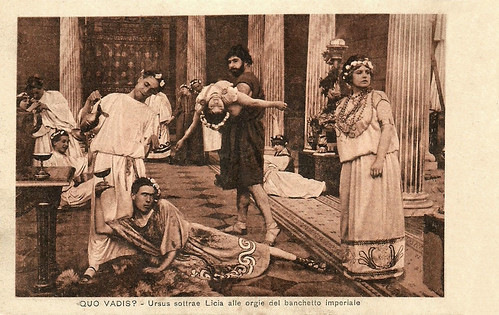
Italian postcard by Uff. Rev. St. Terni. Photo: Cines. Publicity still for Quo vadis? (Enrico Guazzoni, 1913). Helped by Acte, Nero's former mistress, Ursus ( Bruto Castellani ) subtracts Lygia ( Lea Giunchi ) from the orgy of the imperial banquet, where the drunken Roman Vinicius tries to rape her.
The Start of Hollywood on the Tiber
Ferdinand's Zecca’s 1901 film was part of a Quo vadis?-mania. The book itself, which had its original release as a feuilleton in 1895 and as a novel in 1896, was translated into over 50 languages and contributed to Henryk Sienkiewicz's Nobel Prize for literature in 1905.
In 1900 a stage version would be organised by Stanislaus Stange, which soon spread all over the Western world. Moreover, in 1909 an opera version came along, composed by Jean Nouguès with a libretto by Henri Caïn. This was also performed all over Europe, including at the Wiener Volksoper in 1910.
Several illustrated postcard series were issued in the 1900s, 1910s, and 1920s by reputed artists such as Jan Styka, Piotr Stachiewicz, and Domenico Mastroianni. Sometimes these quoted Gérôme again like the Italian Del Senno did with 'The Christian Martyrs’ Last Prayer'.
Several films have been based on 'Quo vadis?', including two Italian silent films in 1913 and in 1924, a Hollywood production in 1951, a miniseries directed by Franco Rossi in 1985, and a 2001 adaptation by Jerzy Kawalerowicz.
In 1912-1913 Enrico Guazzoni directed an impressive version for the Roman company Cines, which premiered at the Roman Teatro Costanzi, the actual Roman opera house. It also had a prestigious international release with even the British Royals visiting a screening and with screenings in established theatres instead of cinemas like the Astor Theatre in New York. Italian cinema gained much prestige because of this epic and subsequent Antiquity films.
In 1924 the trust Unione Cinematografica Italiana produced a new version with Emil Jannings as Nero and many other European leading actors of the moment such as Lilian Hall-Davis and Alphons Fryland .
In 1951 the first major post-war film production at the Roman Cinecittà studio was the American production Quo Vadis? by Mervyn LeRoy and starring Robert Taylor as Vinicius, Deborah Kerr as Lygia, Leo Genn as Petronius, Marina Berti as Eunice, and Peter Ustinov as Nero. It was the start of what is called ‘Hollywood on the Tiber’, indicating the Golden Age of American cinema being shot in Italy, and actually, a phrase launched during the shooting of this film.

German postcard by Ross Verlag, no. 698/1. Photo: Filmhaus Bruckmann. Emil Jannings as Nero in Quo vadis? (Gabriellino D'Annunzio, Georg Jacoby, 1924).
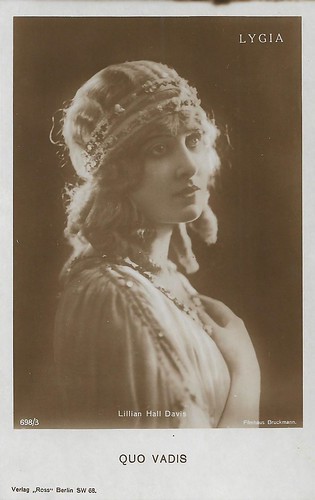
German postcard by Ross Verlag, no. 698/3. Photo: Filmhaus Bruckmann. Lilian Hall-Davis as Lygia in Quo vadis? (Gabriellino D'Annunzio, Georg Jacoby, 1924).
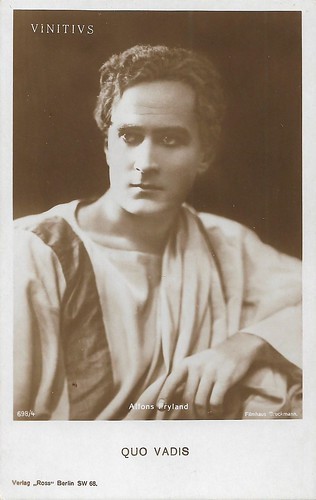
German postcard by Ross Verlag, no. 698/4. Photo: Filmhaus Bruckmann. Alphons Fryland as Vinicius in Quo vadis? (Gabriellino D'Annunzio, Georg Jacoby, 1924).
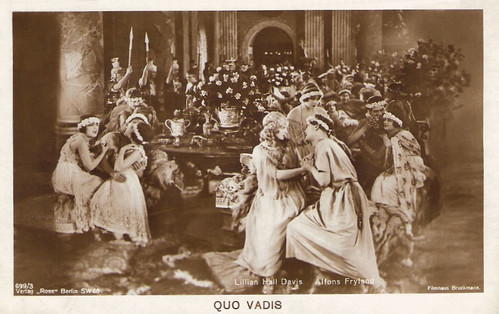
German postcard by Ross Verlag, no. 699/3. Photo: Filmhaus Bruckmann. Alphons Fryland as Vinicius and Lilian Hall-Davis as Lygia in Quo vadis? (Gabriellino D'Annunzio, Georg Jacoby, 1924) . Here Vinicius tries to seduce the chaste Lygia during an orgy at the palace of Nero.
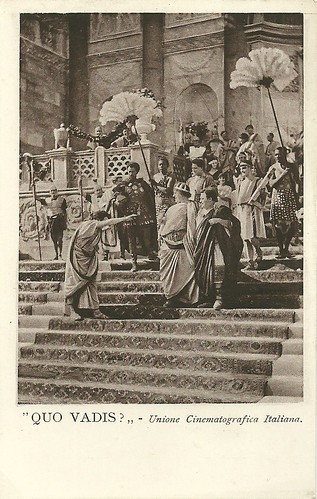
Italian postcard by Edizione L'Argentografica, Torino. Publicity still for the Italo-German epic Quo Vadis? (Gabriellino D'Annunzio, Georg Jacoby, 1924), starring Emil Jannings as Nero, Elena Sangro as Poppea, Alphons Fryland as Vinicius, and Lilian Hall-Davis as Licia (or Lygia).
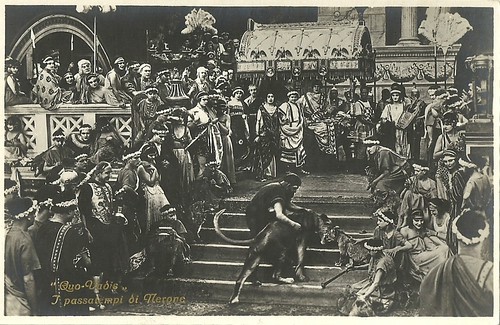
Italian postcard by G.B. Falci, Milano, no. 155. Photo: La Fotominio. Publicity still for Quo vadis? (Gabriellino D'Annunzio, Georg Jacoby, 1924). Caption: Nero's pastimes. Nero ( Emil Jannings ) is seated in the back in the litter.
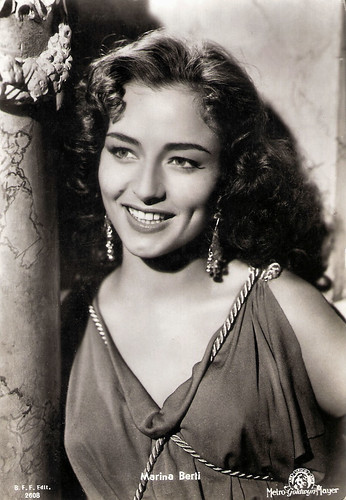
Italian postcard by B.F.F. Edit., no. 2608. Photo: Metro-Goldwyn-Mayer. Marina Berti in Quo Vadis (Mervyn LeRoy, Anthony Mann, 1951).
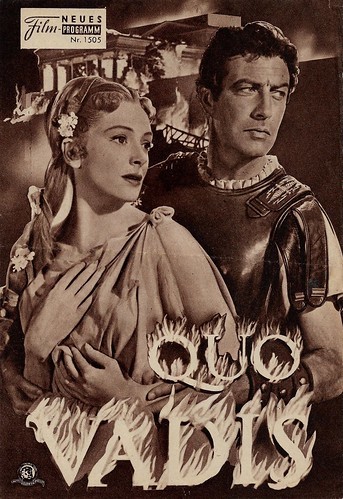
German brochure by Neues Film-Programm, no. 1505. Photo: Metro-Goldwyn-Mayer. Deborah Kerr and Robert Taylor in Quo Vadis (Mervyn LeRoy, 1951).
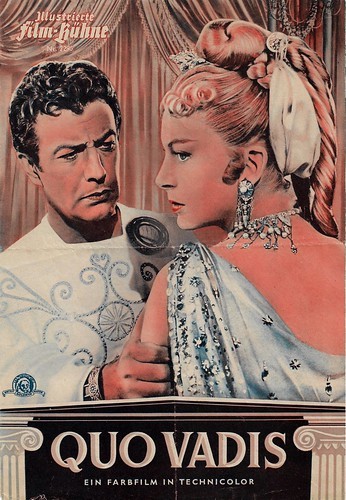
German brochure by Illustrierte Film-Bühne, no. 2295. Deborah Kerr and Robert Taylor in Quo Vadis (Mervyn LeRoy, 1951).
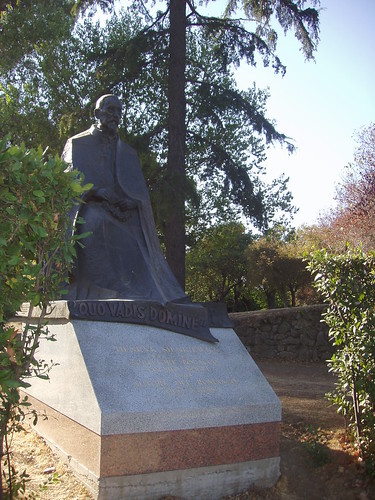
Statue of Henryk Sienkiewicz, Villa Borghese, Rome. Photo: Ivo Blom. For years only a small statue of Sienkiewicz could be found in the same corner in Villa Borghese (Piazzale Ferdousi). Now there is this giant, created by Polish sculptor Czeslaw Dzwigaj.
Text: Ivo Blom. Source: Elisabetta Gagetti & Monica Wozniak, 'Quo vadis - La prima opera transmediale' (Accademia Polacca Roma, 2017).

Italian postcard. Photo: Cines. Publicity still for Quo vadis? (Enrico Guazzoni, 1913). Caption: The death of the gladiator. This image cites Jean-Léon Gérôme's famous painting 'Pollice verso' (Thumbs down, 1872) and was often used in the publicity for the film. In the back, the emperor Nero (Carlo Cattaneo) makes the sign of thumbs down, a sign for the conqueror to kill his adversary. Flanking Nero are left Tigellinus (Cesare Moltroni) and right Petronius ( Gustavo Serena ). Left of the imperial box the Vestal Virgins are seated.

German postcard by Ross-Verlag, Berlin, no. 699/6, 1919-1924. Photo: Filmhaus Bruckmann. Rina de Liguoro in Quo vadis? (Gabriellino D'Annunzio, Georg Jacoby, 1924).

Italian postcard by A. Mondadori, Verona. Photo: MGM. Publicity still for Quo Vadis (Mervyn LeRoy, Anthony Mann, 1951). Caption: In Rome, Italy, Technicolor cameras film a scene for M.G.M.'s Quo Vadis. Roman soldiers parade before Nero's palace here.
Meanwhile, the city of Rome starts to burn…
The French translation of the novel 'Quo vadis?' appeared in 1900, and the following year Pathé produced the first cinematographic adaptation, Quo vadis? (Ferdinand Zecca, 1901).
From a Pathé catalogue (March 1902): "'Quo vadis?' is certainly one of the greatest literary successes of our time. This work has been translated into every language and printed in millions of copies. It is a novelty, so to speak, which we cannot allow to escape us. To try and adapt the whole book would be pretentious and impossible; so we have selected the most interesting scenes and arranged them in one film."
Actually, the director Ferdinand Zecca compressed the first part of the novel into one single take depicting two major scenes: the feast of Nero and the burning of Rome. Considered lost for many years, an almost complete print was rediscovered and preserved by CNC Archives Françaises du Film, and first shown in 2016 at Cinema Ritrovato within the framework of the Antiquity and Early Cinema workshop which Ivo Blom, Maria Wyke, and others organised.
The visitors of the imperial banquet are treated to a gladiator fight, in which the popular 1872 painting 'Pollice Verso' by Jean-Léon Gérôme is partly re-enacted. The same painting was explicitly cited in the 1913 version of Quo Vadis? as well as two other paintings by Gérôme: 'The Christian Martyrs’ Last Prayer' and 'Ave Caesar'.
'Pollice verso' would also be the starting point for Ridley Scott’s epic Gladiator (2000). Then, when in the 1901 version Vinicius becomes too pushy towards Lygia, the strongman Ursus enters and abducts her. Meanwhile, the city of Rome starts to burn… Despite the rash reduction of the novel, Zecca’s film version was shown for a few years around the globe.

German-Polish postcard by Verlag A. Raczynski, Krakow, 1906 / Farbenlichtdruck Martin Rommel, Stuttgart, no. 6. Artwork: Piotr Stachiewicz, 'The banquet at Nero's'. The first illustrations of Stachiewicz's work appeared in magazines from 1896 onward, while postcards were reissued many times between 1900 and 1930. He was the favourite illustrator of the novelist Henryk Sienkiewicz.

Italian postcard Ed. E. Sborgi, Firenze. Artwork: A. Del Senno, 'Cristiani al martirio'. The composition is a mirrored version of Jean-Léon Gérôme's painting 'The Christian Martyrs' Last Prayer'.

French postcard by J. Lapina & Cie, Paris, no. 25. 311. Artwork: Jan Styka, 'Quo vadis? (Ursus' battle with the bull)'. The French editor Flammmarion commissioned Jan Styka to design 150 etchings for a three-part deluxe edition (1901-1903) of the novel 'Quo vadis?'. A large postcard series was derived from this.

Polish postcard by ed. Krakow 1903. Publicity still of a Polish stage version of 'Quo vadis?'. Lygia pleas Ursus not to kill Vinicius. On the left, the dead gladiator Croton, who was supposed to kill Ursus, while Vinicius would abduct then Lygia. On the right, the treacherous Chilon observes the scene.

British postcard in the Opalette Series by Rotary Photo E.C., no. O.3077.A. Australian actress Mab Paul as Lygia in a British stage play version of 'Quo vadis?' based on the novel by Henryk Sienkiewicz. As Paul left the UK in 1910 to head back to Australia, this might be a pre-1910 card.

French postcard. Photo: J. Bioletto, Lyon. Jean Riddez as Vinicius in the opera 'Quo vadis?' (1909) by Jean Nouguès, libretto by Henri Cain.

Austrian postcard, no. 6. Photo: Ludwig Gutmann, Vienna, Sept. 1910. Maria Jeritza as Lygia and Theodor Schütz as Vinicius in the opera 'Quo vadis?' at the Wiener Volksoper 1910.

Austrian postcard, no. 10. Photo: Ludwig Gutmann, Vienna, Sept. 1910. Mr. Recht as Nero and Helene Oberländer as Poppaea in the opera 'Quo vadis?' at the Wiener Volksoper 1910.

French postcard by A.N. (Armand Noyer), Paris, no. 276/3. Sculptography: Domenico Mastroianni, 1913.

Belgian postcard by Ed. A. Deloga, Bruxelles. Photo: Cines. Publicity still for Quo vadis? (Enrico Guazzoni, 1913). On 18 July (year unknown) the Brussels cinema Majestic, 62, Boulevard du Nord (now Boulevard Adolphe Max), re-released the Italian silent epic Quo vadis? (Enrico Guazzoni, 1913) because, as the postcard says, of general demand. The film took 2 hours, which was quite long for those years, and was shown integrally, with a new musical score. The still depicted is a citation from Jean-Léon Gérôme's well-known painting 'The Christian Martyr's Last Prayers' (1883). It was much recycled in the publicity for the film, on posters, in brochures, and in advertisements in magazines.

Italian postcard. Photo: Cines. Publicity still for Quo vadis? (Enrico Guazzoni, 1913). Caption: "Ave Caesar, those who are about to die, salute you."
This image cites a famous 19th-century painting (1859) by Jean-Léon Gérôme. It was often quoted, also in the Asterix comics, see Asterix the gladiator.

Italian postcard by Uff. Rev. St. Terni. Photo: Cines. Publicity still for Quo vadis? (Enrico Guazzoni, 1913). Helped by Acte, Nero's former mistress, Ursus ( Bruto Castellani ) subtracts Lygia ( Lea Giunchi ) from the orgy of the imperial banquet, where the drunken Roman Vinicius tries to rape her.
The Start of Hollywood on the Tiber
Ferdinand's Zecca’s 1901 film was part of a Quo vadis?-mania. The book itself, which had its original release as a feuilleton in 1895 and as a novel in 1896, was translated into over 50 languages and contributed to Henryk Sienkiewicz's Nobel Prize for literature in 1905.
In 1900 a stage version would be organised by Stanislaus Stange, which soon spread all over the Western world. Moreover, in 1909 an opera version came along, composed by Jean Nouguès with a libretto by Henri Caïn. This was also performed all over Europe, including at the Wiener Volksoper in 1910.
Several illustrated postcard series were issued in the 1900s, 1910s, and 1920s by reputed artists such as Jan Styka, Piotr Stachiewicz, and Domenico Mastroianni. Sometimes these quoted Gérôme again like the Italian Del Senno did with 'The Christian Martyrs’ Last Prayer'.
Several films have been based on 'Quo vadis?', including two Italian silent films in 1913 and in 1924, a Hollywood production in 1951, a miniseries directed by Franco Rossi in 1985, and a 2001 adaptation by Jerzy Kawalerowicz.
In 1912-1913 Enrico Guazzoni directed an impressive version for the Roman company Cines, which premiered at the Roman Teatro Costanzi, the actual Roman opera house. It also had a prestigious international release with even the British Royals visiting a screening and with screenings in established theatres instead of cinemas like the Astor Theatre in New York. Italian cinema gained much prestige because of this epic and subsequent Antiquity films.
In 1924 the trust Unione Cinematografica Italiana produced a new version with Emil Jannings as Nero and many other European leading actors of the moment such as Lilian Hall-Davis and Alphons Fryland .
In 1951 the first major post-war film production at the Roman Cinecittà studio was the American production Quo Vadis? by Mervyn LeRoy and starring Robert Taylor as Vinicius, Deborah Kerr as Lygia, Leo Genn as Petronius, Marina Berti as Eunice, and Peter Ustinov as Nero. It was the start of what is called ‘Hollywood on the Tiber’, indicating the Golden Age of American cinema being shot in Italy, and actually, a phrase launched during the shooting of this film.

German postcard by Ross Verlag, no. 698/1. Photo: Filmhaus Bruckmann. Emil Jannings as Nero in Quo vadis? (Gabriellino D'Annunzio, Georg Jacoby, 1924).

German postcard by Ross Verlag, no. 698/3. Photo: Filmhaus Bruckmann. Lilian Hall-Davis as Lygia in Quo vadis? (Gabriellino D'Annunzio, Georg Jacoby, 1924).

German postcard by Ross Verlag, no. 698/4. Photo: Filmhaus Bruckmann. Alphons Fryland as Vinicius in Quo vadis? (Gabriellino D'Annunzio, Georg Jacoby, 1924).

German postcard by Ross Verlag, no. 699/3. Photo: Filmhaus Bruckmann. Alphons Fryland as Vinicius and Lilian Hall-Davis as Lygia in Quo vadis? (Gabriellino D'Annunzio, Georg Jacoby, 1924) . Here Vinicius tries to seduce the chaste Lygia during an orgy at the palace of Nero.

Italian postcard by Edizione L'Argentografica, Torino. Publicity still for the Italo-German epic Quo Vadis? (Gabriellino D'Annunzio, Georg Jacoby, 1924), starring Emil Jannings as Nero, Elena Sangro as Poppea, Alphons Fryland as Vinicius, and Lilian Hall-Davis as Licia (or Lygia).

Italian postcard by G.B. Falci, Milano, no. 155. Photo: La Fotominio. Publicity still for Quo vadis? (Gabriellino D'Annunzio, Georg Jacoby, 1924). Caption: Nero's pastimes. Nero ( Emil Jannings ) is seated in the back in the litter.

Italian postcard by B.F.F. Edit., no. 2608. Photo: Metro-Goldwyn-Mayer. Marina Berti in Quo Vadis (Mervyn LeRoy, Anthony Mann, 1951).

German brochure by Neues Film-Programm, no. 1505. Photo: Metro-Goldwyn-Mayer. Deborah Kerr and Robert Taylor in Quo Vadis (Mervyn LeRoy, 1951).

German brochure by Illustrierte Film-Bühne, no. 2295. Deborah Kerr and Robert Taylor in Quo Vadis (Mervyn LeRoy, 1951).

Statue of Henryk Sienkiewicz, Villa Borghese, Rome. Photo: Ivo Blom. For years only a small statue of Sienkiewicz could be found in the same corner in Villa Borghese (Piazzale Ferdousi). Now there is this giant, created by Polish sculptor Czeslaw Dzwigaj.
Text: Ivo Blom. Source: Elisabetta Gagetti & Monica Wozniak, 'Quo vadis - La prima opera transmediale' (Accademia Polacca Roma, 2017).
Published on July 19, 2021 22:00
July 18, 2021
Christoph M. Ohrt
German actor Christoph M. Ohrt (1960) is best known for his roles in popular TV series like HeliCops - Einsatz über Berlin (1998), and Edel & Starck (2002). He also appeared in German and some international films.

German autograph card by SAT. 1, Berlin. Photo: SAT.1 / Trenkel. Christoph M. Ohrt in the TV series HeliCops (1998-2001).
A delicious gender-bender comedy
Christoph Marius Ohrt was born in 1960 in Hamburg, Germany, and also grew up in this city. He attended the Gymnasium Eppendorf, a high school, which he left a few years before his graduation to study acting.
He attended the Schauspielschule Bühnenstudio, a drama school in Hamburg, from 1977 to 1979 and studied acting in New York at the Center for the Acting Process from 1979 to 1983.
The following year, he made his film debut with a lead role in the romantic comedy Kassensturz/Cash drop (Rolf Silber, 1984) with Britta Pohland and Tilo Prückner.
It was followed by such little known, German films as Dann ist nichts mehr wie vorher/Then Nothing Is the Same Anymore (Gerd Roman Frosch, 1987) with Barbara Rudnik and Karin Baal , and Die Richterin/The Judge (Jörg Grünler, 1990).
He also appeared on television in series and TV films. He played the lead in such popular series as the situation comedy Das Nest/The Nest (1989-1992), and in the US he appeared in the NBC series The Fifth Corner (1991-1992). He was one of the stars of the TV series HeliCops (1998-2001), about an elite unit of the Berlin police which fights crime using a high-tech prototype helicopter.
In the cinema, he co-starred with Katja Riemann in the romantic comedy Nur über meine Leiche/Over My Dead Body (Rainer Matsutani, 1995) and starred in the delicious gender-bender comedy Echte Kerle/Regular Guys (Rolf Silber, 1996).
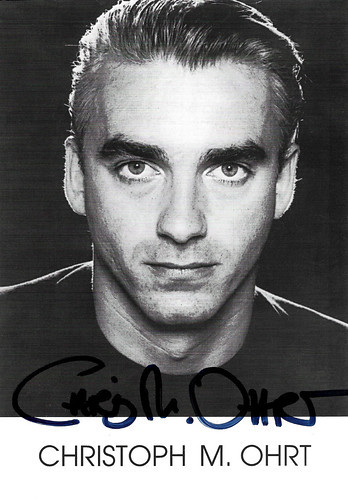
German autograph card.
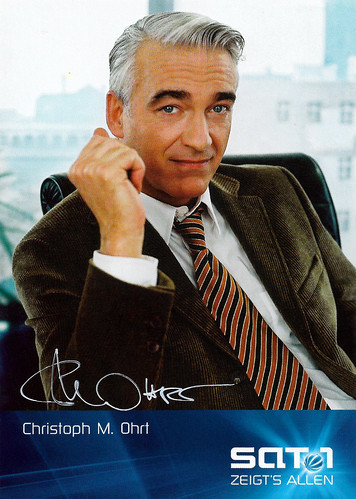
German autograph card by Sat.1. Photo: Sat.1 / Torsten Eichhorst. Christoph M. Ohrt in the TV series Edel & Starck (2002-2005).
A witty screwball comedy situated in a law firm
In the new century, Christoph M. Ort continued to combine TV work with feature films. He had a role in the Swedish thriller Livvakterna/Executive Protection (Anders Nilsson, 2001), starring Jakob Eklund.
Then he co-starred with Rebecca Immanuel in the romantic comedy series Edel & Starck (2002-2005), a witty screwball comedy situated in a law firm. For his role as Felix Edel, he won a German Television Award in 2002 and a Bavarian TV Award in 2003.
Other films included the award-winning comedy Barfuß bis zum Hals/Barefoot to the Neck (Hansjörg Thurn, 2009) in which he starred as a conservative textile manufacturer from Bavaria, who buys a nudist site in Eastern Germany, and the excellent comedy-drama Dieter Not Unhappy (Christian Schäfer, 2017), a student film that got international acclaim.
He also played a supporting part in the American film Reach me/Out of Sight (John Herzfeld, 2014) with Sylvester Stallone , Kyra Sedgwick, and Thomas Jane.
In recent years, he could be seen in several popular German TV series, such as Frühling/Spring (2018-2021), Das Traumschiff/The Dream Boat (2012-2020), and Daheim in den Bergen/At home in the mountains (2018-2021).
Christoph M. Ohrt met his wife Stevee DeNike in Sherman Oaks, a district of Los Angeles. They have two children, daughter Lilly and son Spencer. The couple divorced in 2012. Orth is now in a relationship with actress Dana Golombek.
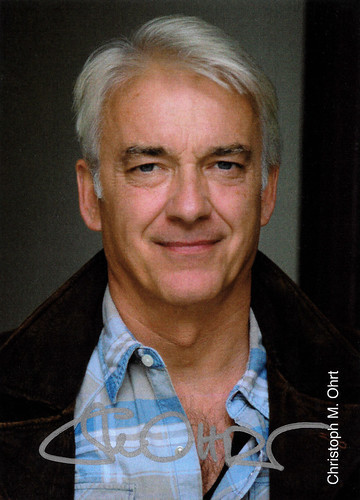
German autograph card.

German autograph card.
Sources: Wikipedia (English and German), and .

German autograph card by SAT. 1, Berlin. Photo: SAT.1 / Trenkel. Christoph M. Ohrt in the TV series HeliCops (1998-2001).
A delicious gender-bender comedy
Christoph Marius Ohrt was born in 1960 in Hamburg, Germany, and also grew up in this city. He attended the Gymnasium Eppendorf, a high school, which he left a few years before his graduation to study acting.
He attended the Schauspielschule Bühnenstudio, a drama school in Hamburg, from 1977 to 1979 and studied acting in New York at the Center for the Acting Process from 1979 to 1983.
The following year, he made his film debut with a lead role in the romantic comedy Kassensturz/Cash drop (Rolf Silber, 1984) with Britta Pohland and Tilo Prückner.
It was followed by such little known, German films as Dann ist nichts mehr wie vorher/Then Nothing Is the Same Anymore (Gerd Roman Frosch, 1987) with Barbara Rudnik and Karin Baal , and Die Richterin/The Judge (Jörg Grünler, 1990).
He also appeared on television in series and TV films. He played the lead in such popular series as the situation comedy Das Nest/The Nest (1989-1992), and in the US he appeared in the NBC series The Fifth Corner (1991-1992). He was one of the stars of the TV series HeliCops (1998-2001), about an elite unit of the Berlin police which fights crime using a high-tech prototype helicopter.
In the cinema, he co-starred with Katja Riemann in the romantic comedy Nur über meine Leiche/Over My Dead Body (Rainer Matsutani, 1995) and starred in the delicious gender-bender comedy Echte Kerle/Regular Guys (Rolf Silber, 1996).

German autograph card.

German autograph card by Sat.1. Photo: Sat.1 / Torsten Eichhorst. Christoph M. Ohrt in the TV series Edel & Starck (2002-2005).
A witty screwball comedy situated in a law firm
In the new century, Christoph M. Ort continued to combine TV work with feature films. He had a role in the Swedish thriller Livvakterna/Executive Protection (Anders Nilsson, 2001), starring Jakob Eklund.
Then he co-starred with Rebecca Immanuel in the romantic comedy series Edel & Starck (2002-2005), a witty screwball comedy situated in a law firm. For his role as Felix Edel, he won a German Television Award in 2002 and a Bavarian TV Award in 2003.
Other films included the award-winning comedy Barfuß bis zum Hals/Barefoot to the Neck (Hansjörg Thurn, 2009) in which he starred as a conservative textile manufacturer from Bavaria, who buys a nudist site in Eastern Germany, and the excellent comedy-drama Dieter Not Unhappy (Christian Schäfer, 2017), a student film that got international acclaim.
He also played a supporting part in the American film Reach me/Out of Sight (John Herzfeld, 2014) with Sylvester Stallone , Kyra Sedgwick, and Thomas Jane.
In recent years, he could be seen in several popular German TV series, such as Frühling/Spring (2018-2021), Das Traumschiff/The Dream Boat (2012-2020), and Daheim in den Bergen/At home in the mountains (2018-2021).
Christoph M. Ohrt met his wife Stevee DeNike in Sherman Oaks, a district of Los Angeles. They have two children, daughter Lilly and son Spencer. The couple divorced in 2012. Orth is now in a relationship with actress Dana Golombek.

German autograph card.

German autograph card.
Sources: Wikipedia (English and German), and .
Published on July 18, 2021 22:00
July 17, 2021
Les Misérables (1934)
The legendary Harry Baur played Jean Valjean in Raymond Bernard’s early sound adaptation of Victor Hugo’s classic novel 'Les Misérables', shot in 1933. For six months, shooting took place in Paris and the South of France. Costars were Charles Vanel as the nasty, relentless Inspector Javert and Josseline Gael as Cosette. Because of its 4½-hour length, Les Misérables (Raymond Bernard, 1934) was released in two parts. It became Baur’s best film performance and some say the best film interpretation of Hugo’s famous character. Because of the European success, Baur received Hollywood offers but declined; he didn’t want to leave Paris.
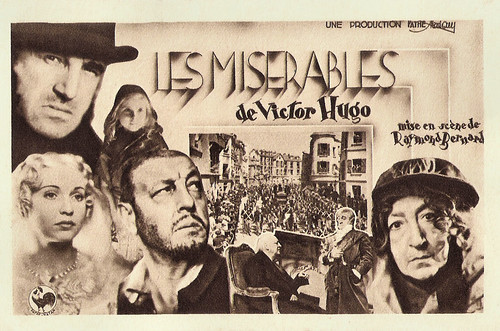
French postcard by A. Breger, Frères, Paris. Photo: Pathé Natan. In the centre: Harry Baur as Jean Valjean in Les Misérables (Raymond Bernard, 1934), based on the novel by Victor Hugo.
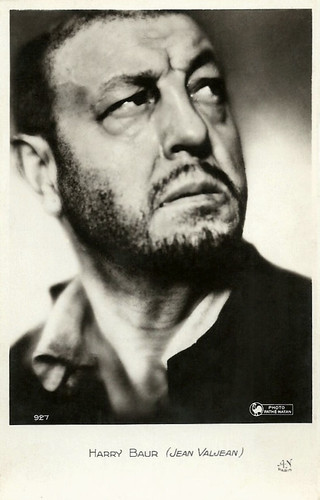
French postcard by A.N., Paris, no. 927. Photo Pathé Natan. Harry Baur as Jean Valjean in Les Misérables (Raymond Bernard, 1934).
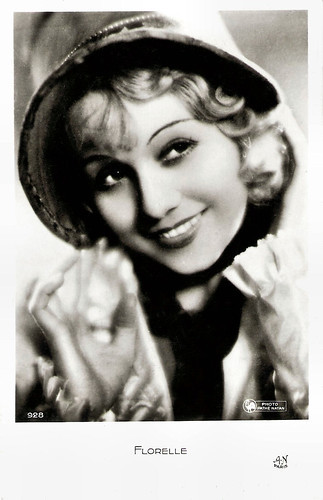
French postcard by A.N., Paris, no. 928. Photo: Pathé-Natan. Florelle as Fantine in Les Miserables (Raymond Bernard, 1934).
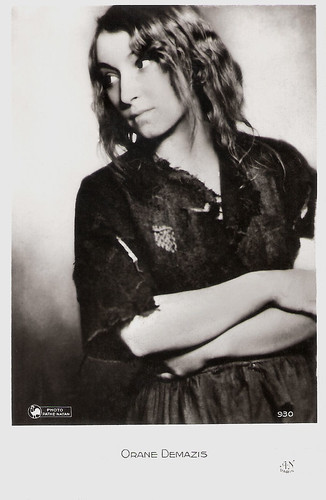
French postcard by A.N., Paris, no. 930. Photo: Pathé Natan. Orane Demazis as Eponine in Les Misérables (Raymond Bernard, 1934).
His only crime was stealing a loaf of bread
In Les Miserables (1934) film director and co-scriptwriter, Raymond Bernard follows the lives of numerous people over the course of 20 years in 19th century France. The plot is weaved together by the story of an ex-convict named Jean Valjean ( Harry Baur ) on the run from an obsessive police inspector.
Jean Valjean struggles to redeem himself, but his attempts are continually ruined by the intrusion of Javert ( Charles Vanel ). Javert is a cruel, ruthless police inspector who has dedicated his life to pursuing Valjean, whose only crime was stealing a loaf of bread, for which he received 5 years in jail. He serves an additional 14 years for escape attempts.
The film, like the novel, features numerous other characters and subplots, such as Fantine ( Florelle ), a woman forced into prostitution to pay two cruel innkeepers, the Thénardiers ( Charles Dullin and Marguerite Moreno ), for looking after her daughter Cosette.
Another subplot is the story of the revolutionaries, including Marius ( Jean Servais ), a young man who falls in love later on in the film with the now-adult Cosette ( Josseline Gaël ).
The film is, for the most part, faithful to the original novel, however, there are some differences: Javert is presented as considerably less sympathetic than in the book, largely portraying him as the pinnacle of the cruelty in 19th century France. Valjean is released after having saved a house from caving in, not because his time is served. Valjean dies shortly after his confession to Marius, the day after the wedding, due to a wound that appeared to have become infected (probably due to the sewer water). He does not describe Fantine to Cosette.
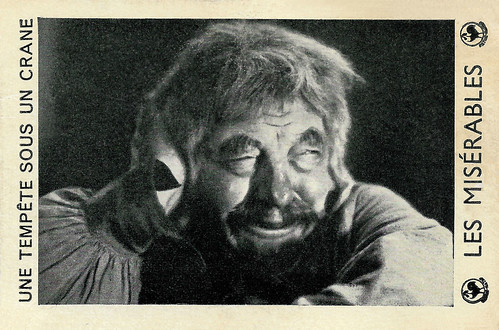
Belgian collectors card, which promotes the screening of the film at Majestic, Gand. Photo: Pathé-Natan. Harry Baur as Jean Valjean in Les Misérables (Raymond Bernard, 1934). Caption: Une tempête sous un crane.
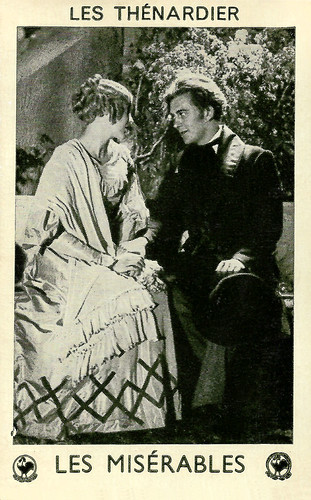
Belgian collectors card, which promotes the screening of the film at Majestic, Gand. Photo: Pathé-Natan. Josseline Gaël as Cosette and Jean Servais as Marius in Les Misérables (Raymond Bernard, 1934). Caption: Les Thénardier.

Belgian collectors card, which promotes the screening of the film at Majestic, Gand. Photo: Pathé-Natan. Orane Demazis as Eponine and Emile Génevois as Gavroche in Les Misérables (Raymond Bernard, 1934). Caption: Les Thénardier.
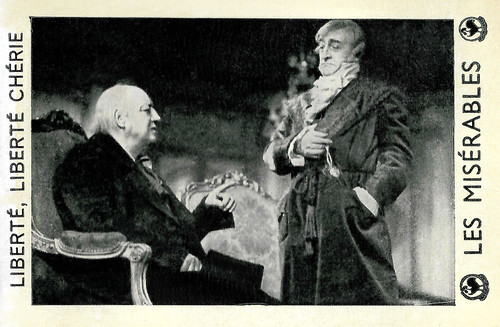
Belgian collectors card, which promotes the screening of the film at Majestic, Gand. Photo: Pathé-Natan. Harry Baur as Jean Valjean and Max Dearly as Les Misérables (Raymond Bernard, 1934). Caption: Liberté, liberté, chérie.
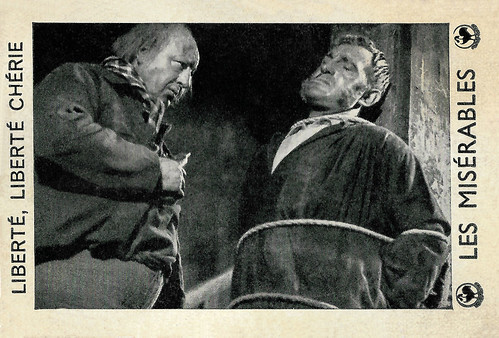
Belgian collectors card, which promotes the screening of the film at Majestic, Gand. Photo: Pathé-Natan. Harry Baur as Jean Valjean and Charles Vanel as Javert in Les Misérables (Raymond Bernard, 1934). Caption: Liberté, liberté, chérie.
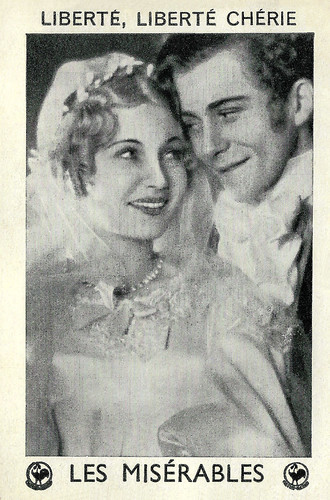
Belgian collectors card, which promotes the screening of the film at Majestic, Gand. Photo: Pathé-Natan. Josseline Gaël as Cosette and Jean Servais as Marius in Les Misérables (Raymond Bernard, 1934). Caption: Liberté, liberté, chérie.
The reasons for the film's success are manifold
Les Miserables (1934) was presented in three parts respectively called: 'Une tempête sous un crâne' (Tempest in a skull), 'Les Thénardier' (The Thenardiers - the names of the couple of villains) and 'Liberté, liberté chérie' (Freedom, dear Freedom).
Reviewer Fernies at IMDb thinks the reasons for the film's success are manifold: "Firstly the detail and therefore the strength of the original are largely retained. Characters are properly fleshed out, and just as in the original we feel we share the characters' lives and get to know and care about them. The depth and number of characters are not sacrificed to considerations of time and commerce."
"Although some of the photography appears dated by modern standards, Raymond Bernard's literate script and direction are stimulating and advance the narrative at a steady pace (despite the impression created by the running time). He is masterful in the creation of atmosphere in both intimate and crowd scenes. For example, the film is quite spectacular in its depiction of the 1832 uprising, yet it is deeply moving in the scenes involving Valjean and the Bishop. The music (by Arthur Honegger) has great dignity and is entirely apt to the tenor of the film and the themes it embraces."
"However, if the real strength of the piece is in the depth and conviction of its characters, their cinematic success is due in no short measure to the quality of the acting. Fantine is perhaps a little melodramatic for modern tastes, and Javert lacks a truly tragic quality, but all told the performances are faithful to the original and convincing, and none more so than Harry Baur as Valjean. His immense physical presence and slow, controlled delivery, combined with his ability to express his inner feelings with little more than a look or a moment's hesitation command our respect and sympathy, making him the perfect incarnation of the tormented but determined Valjean."
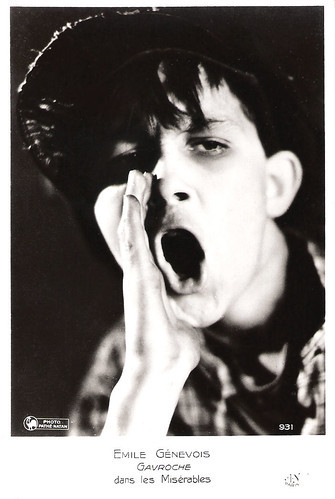
French postcard by A.N., Paris, no. 931. Photo Pathé Natan. Emile Génevois as Gavroche in Les Misérables (Raymond Bernard, 1934).
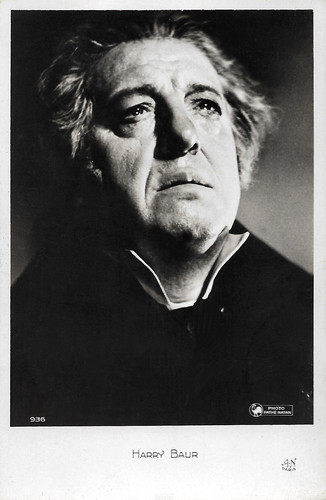
French postcard by A.N., Paris, no. 936. Photo: Pathé Natan. Harry Baur as the older Jean Valjean in Les Misérables (Raymond Bernard, 1934).
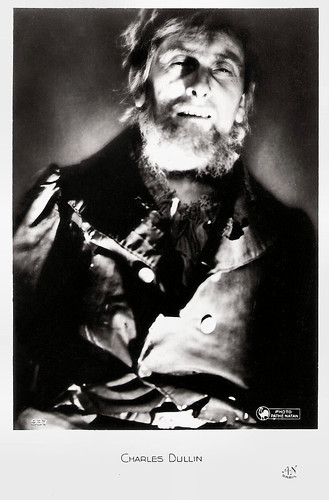
French postcard by A.N., Paris, no. 937. Photo: Pathé Natan. Charles Dullin as the evil Thénardier in Les Misérables (Raymond Bernard, 1934).
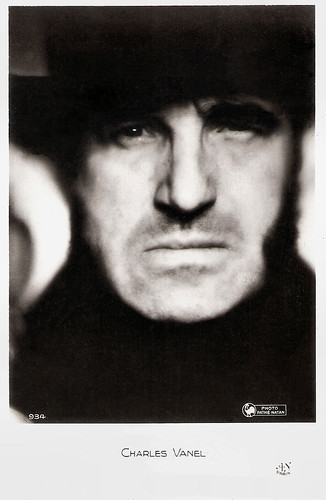
French postcard by A.N. Paris, no. 941. Photo Pathé Natan. Charles Vanel as Javert in Les Misérables (Raymond Bernard, 1934).
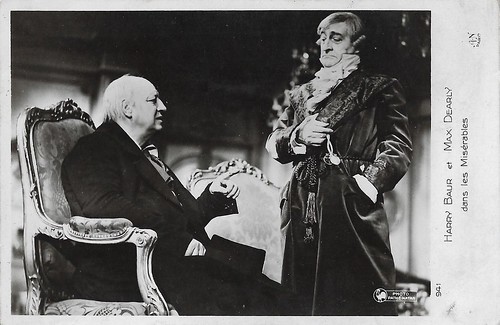
French postcard by A.N. Paris, no. 941. Photo Pathé Natan. Harry Baur as Jean Valjean and Max Dearly as Gillenormand in Les Misérables (Raymond Bernard, 1934).
Sources: Wikipedia and IMDb.

French postcard by A. Breger, Frères, Paris. Photo: Pathé Natan. In the centre: Harry Baur as Jean Valjean in Les Misérables (Raymond Bernard, 1934), based on the novel by Victor Hugo.

French postcard by A.N., Paris, no. 927. Photo Pathé Natan. Harry Baur as Jean Valjean in Les Misérables (Raymond Bernard, 1934).

French postcard by A.N., Paris, no. 928. Photo: Pathé-Natan. Florelle as Fantine in Les Miserables (Raymond Bernard, 1934).

French postcard by A.N., Paris, no. 930. Photo: Pathé Natan. Orane Demazis as Eponine in Les Misérables (Raymond Bernard, 1934).
His only crime was stealing a loaf of bread
In Les Miserables (1934) film director and co-scriptwriter, Raymond Bernard follows the lives of numerous people over the course of 20 years in 19th century France. The plot is weaved together by the story of an ex-convict named Jean Valjean ( Harry Baur ) on the run from an obsessive police inspector.
Jean Valjean struggles to redeem himself, but his attempts are continually ruined by the intrusion of Javert ( Charles Vanel ). Javert is a cruel, ruthless police inspector who has dedicated his life to pursuing Valjean, whose only crime was stealing a loaf of bread, for which he received 5 years in jail. He serves an additional 14 years for escape attempts.
The film, like the novel, features numerous other characters and subplots, such as Fantine ( Florelle ), a woman forced into prostitution to pay two cruel innkeepers, the Thénardiers ( Charles Dullin and Marguerite Moreno ), for looking after her daughter Cosette.
Another subplot is the story of the revolutionaries, including Marius ( Jean Servais ), a young man who falls in love later on in the film with the now-adult Cosette ( Josseline Gaël ).
The film is, for the most part, faithful to the original novel, however, there are some differences: Javert is presented as considerably less sympathetic than in the book, largely portraying him as the pinnacle of the cruelty in 19th century France. Valjean is released after having saved a house from caving in, not because his time is served. Valjean dies shortly after his confession to Marius, the day after the wedding, due to a wound that appeared to have become infected (probably due to the sewer water). He does not describe Fantine to Cosette.

Belgian collectors card, which promotes the screening of the film at Majestic, Gand. Photo: Pathé-Natan. Harry Baur as Jean Valjean in Les Misérables (Raymond Bernard, 1934). Caption: Une tempête sous un crane.

Belgian collectors card, which promotes the screening of the film at Majestic, Gand. Photo: Pathé-Natan. Josseline Gaël as Cosette and Jean Servais as Marius in Les Misérables (Raymond Bernard, 1934). Caption: Les Thénardier.

Belgian collectors card, which promotes the screening of the film at Majestic, Gand. Photo: Pathé-Natan. Orane Demazis as Eponine and Emile Génevois as Gavroche in Les Misérables (Raymond Bernard, 1934). Caption: Les Thénardier.

Belgian collectors card, which promotes the screening of the film at Majestic, Gand. Photo: Pathé-Natan. Harry Baur as Jean Valjean and Max Dearly as Les Misérables (Raymond Bernard, 1934). Caption: Liberté, liberté, chérie.

Belgian collectors card, which promotes the screening of the film at Majestic, Gand. Photo: Pathé-Natan. Harry Baur as Jean Valjean and Charles Vanel as Javert in Les Misérables (Raymond Bernard, 1934). Caption: Liberté, liberté, chérie.

Belgian collectors card, which promotes the screening of the film at Majestic, Gand. Photo: Pathé-Natan. Josseline Gaël as Cosette and Jean Servais as Marius in Les Misérables (Raymond Bernard, 1934). Caption: Liberté, liberté, chérie.
The reasons for the film's success are manifold
Les Miserables (1934) was presented in three parts respectively called: 'Une tempête sous un crâne' (Tempest in a skull), 'Les Thénardier' (The Thenardiers - the names of the couple of villains) and 'Liberté, liberté chérie' (Freedom, dear Freedom).
Reviewer Fernies at IMDb thinks the reasons for the film's success are manifold: "Firstly the detail and therefore the strength of the original are largely retained. Characters are properly fleshed out, and just as in the original we feel we share the characters' lives and get to know and care about them. The depth and number of characters are not sacrificed to considerations of time and commerce."
"Although some of the photography appears dated by modern standards, Raymond Bernard's literate script and direction are stimulating and advance the narrative at a steady pace (despite the impression created by the running time). He is masterful in the creation of atmosphere in both intimate and crowd scenes. For example, the film is quite spectacular in its depiction of the 1832 uprising, yet it is deeply moving in the scenes involving Valjean and the Bishop. The music (by Arthur Honegger) has great dignity and is entirely apt to the tenor of the film and the themes it embraces."
"However, if the real strength of the piece is in the depth and conviction of its characters, their cinematic success is due in no short measure to the quality of the acting. Fantine is perhaps a little melodramatic for modern tastes, and Javert lacks a truly tragic quality, but all told the performances are faithful to the original and convincing, and none more so than Harry Baur as Valjean. His immense physical presence and slow, controlled delivery, combined with his ability to express his inner feelings with little more than a look or a moment's hesitation command our respect and sympathy, making him the perfect incarnation of the tormented but determined Valjean."

French postcard by A.N., Paris, no. 931. Photo Pathé Natan. Emile Génevois as Gavroche in Les Misérables (Raymond Bernard, 1934).

French postcard by A.N., Paris, no. 936. Photo: Pathé Natan. Harry Baur as the older Jean Valjean in Les Misérables (Raymond Bernard, 1934).

French postcard by A.N., Paris, no. 937. Photo: Pathé Natan. Charles Dullin as the evil Thénardier in Les Misérables (Raymond Bernard, 1934).

French postcard by A.N. Paris, no. 941. Photo Pathé Natan. Charles Vanel as Javert in Les Misérables (Raymond Bernard, 1934).

French postcard by A.N. Paris, no. 941. Photo Pathé Natan. Harry Baur as Jean Valjean and Max Dearly as Gillenormand in Les Misérables (Raymond Bernard, 1934).
Sources: Wikipedia and IMDb.
Published on July 17, 2021 22:00
July 16, 2021
Encore! Nos artistes dans leur loge
The French postcard series 'Nos artistes dans leur loge' presents sepia pictures of hundreds of French stage and film stars of the 1910s and 1920s in their dressing rooms. A wonderful candid series, full of mirrors, poses, and extravagant costumes. Nearly all of the postcards were produced by the French journal Comoedia. In 2012, EFSP had the first post about the series. Since then, Ivo Blom collected more and more cards of this series and we did the second post in 2019 and the third one in 2020. So it's time for another, the fourth post. Encore! Here are 28 more fascinating examples of 'Nos artistes dans leur loge', which Ivo acquired recently - and a few of my own cards are also included in the post.

French postcard in the 'Nos artistes dans leur loge' series, no. 2. Photo: Comoedia, Paris.
French actress and singer Mistinguett (1875-1956) captivated Paris with her risqué routines. She went on to become the most popular French entertainer of her time and the highest-paid female entertainer in the world. She appeared more than 60 times in the cinema.
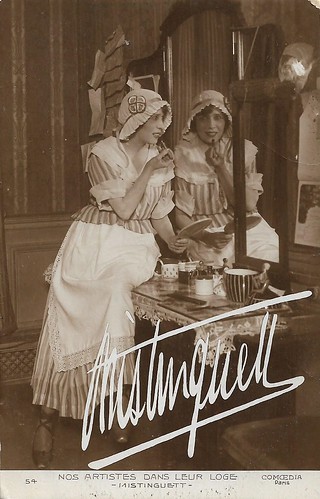
French postcard in the 'Nos artistes dans leur loge' series, no. 54. Photo: Comoedia, Paris. Mistinguett .
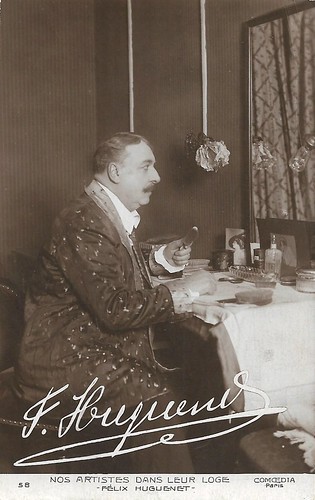
French postcard in the 'Nos artistes dans leur loge' series, no. 58. Photo: Comoedia, Paris.
Félix Huguenet (1858-1926) only stayed two years with the Comédie Française (1906-1908) but had a rich stage career between the 1880s and the 1920s. He played in four films, including Mademoiselle de La Seiglière (André Antoine, 1921).
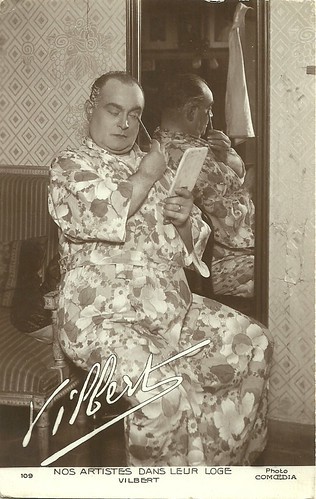
French postcard in the 'Nos artistes dans leur loge' series, no. 109. Photo: Comoedia, Paris.
Henri Vilbert (1870-1926) was a French stage actor and singer. Until the First World War, he was a popular singer at the Paris café-concerts, singing scabrous military songs which the working class liked, thus rivaling popular singers like Polin and Dranem. When the café-concert faded during the war he focused more on theatre and operetta. Vilbert is often confused with his nephew Henri Vilbert (1904-1997) who was a stage and film actor and played with Pagnol, Clouzot, Becker, and others.
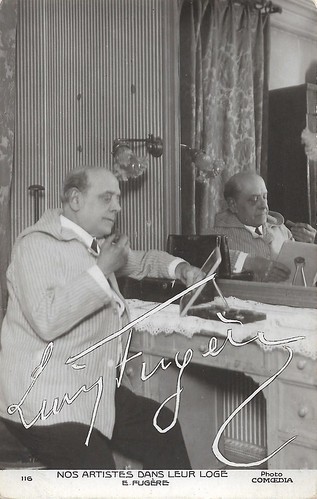
French postcard in the Nos artistes dans leur loge series, no. 116. Photo: Comoedia, Paris.
Probably, this is Lucien Fugère (1848-1935), who was an opera singer, bass voice, associated in particular with the roles of the French repertoire and Mozart. He enjoyed an exceptionally long career and was still singing at 85. His younger brother Paul Fugère(1851-1920) already withdrew from the stage in 1911, so it is rather unlikely this is him. As far as known, none of both brothers acted in a film.
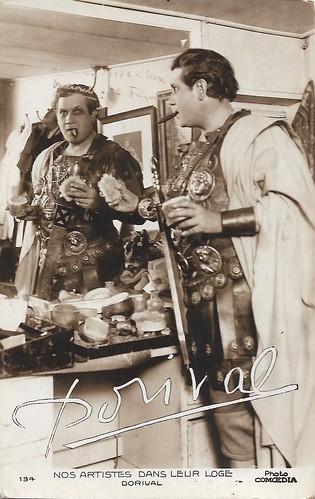
French postcard in the Nos artistes dans leur loge series, no. 134. Photo: Comoedia.
Georges Dorival (1871–1939) was a French stage and screen actor of Norman origin, a painter, and an art collector.
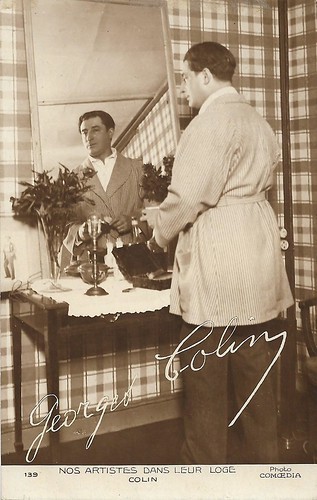
French postcard in the Nos artistes dans leur loge series, no. 139. Photo: Comoedia.
Georges Colin (1880-1945) was a French actor, who appeared in nearly 40 silent and sound films between 1909 and 1945.
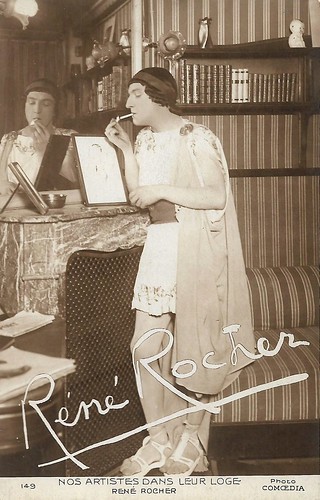
French postcard in the 'Nos artistes dans leur loge' series, no. 149. Photo: Comoedia, Paris.
René Rocher (1890–1970) was a France stage actor and theater director. He was managing director of the Théâtre Antoine from 1928 to 1933, then the Théâtre du Vieux-Colombier from 1935 to 1943, and the Théâtre de l'Odéon from 1940 to 1944. In the 1910s he acted in four films, a.o. Le coupable (André Antoine, 1917) and Blessée au coeur (director unknown, 1917).
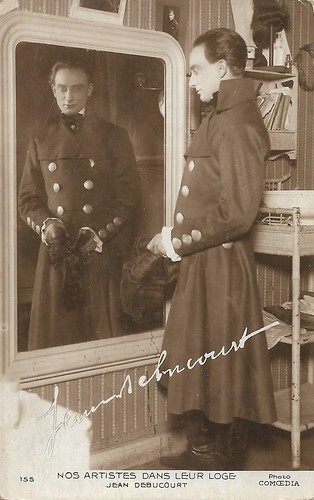
French postcard in the 'Nos artistes dans leur loge' series, no. 155. Photo: Comoedia, Paris.
French actor and director Jean-Étienne Pelisse aka Jean Debucourt (1894-1954) was a member of the Comédie-Française. He also acted in such silent classics as La Chute de la Maison Usher (1928) by Jean Epstein and such sound films as Mayerling (1936) by Anatole Litvak.
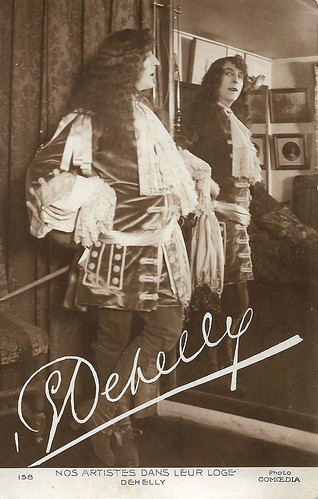
French postcard in the 'Nos artistes dans leur loge' series, no. 158. Photo: Comoedia, Paris.
Émile Dehelly (1871-1969) was a French stage and screen actor, who was a sociétaire of the Comédie française (1903-1928) and had a prolific career at Le Film d’Art between 1909 and 1913. He is the father of film actor Jean Dehelly.
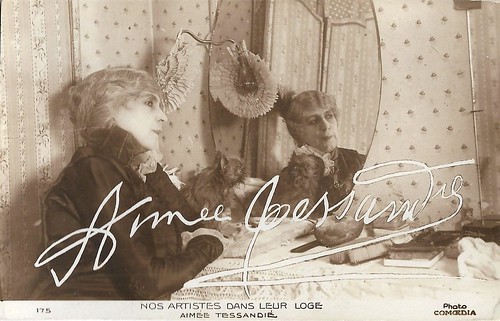
French postcard in the 'Nos artistes dans leur loge' series, no. 175. Photo: Comoedia, Paris.
Aimée Tessandier (1851-1923) was a reputed French stage actress, who from 1908 till 1921 also had a career in French silent cinema.
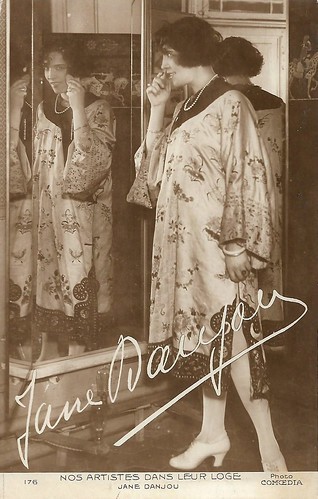
French postcard in the 'Nos artistes dans leur loge' series, no. 176. Photo: Comoedia, Paris.
Pretty performer Jane Danjou is known for a few French silent films. She played small parts in the shorts L'auberge du tohu-bohu/The Inn of Tohu-Bohu (Georges Denola, 1912) and C'est pour les orphelins/For the Children (Louis Feuillade, 1916) with Musidora. She played Suzanne Grandais's friend in Midinettes/ (René Hervil, Louis Mercanton, 1917), and the tile role in Zon (Robert Boudrioz, 1920) opposite Jacques de Féraudy.
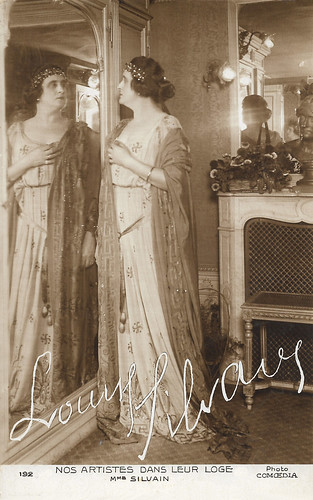
French postcard in the 'Nos artistes dans leur loge' series, no. 192. Photo: Comoedia, Paris.
Louise Silvain (1874-1930) entered the Comédie Française in 1901, became sociétaire in 1910 and sociétaire honoraire in 1925. She was married to Eugène Silvain, aka Sylvain. She acted in the films Une scène d'Andromaque à la Comédie Française (dir. unknown, 1909) and Molière, sa vie, son oeuvre (Jacques de Féraudy, 1922).
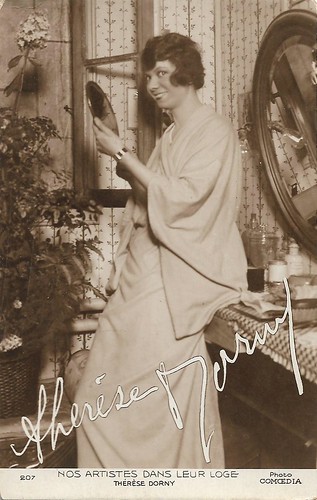
French postcard in the 'Nos artistes dans leur loge' series, no. 207. Photo: Comoedia, Paris.
French actress Thérèse Dorny (1891-1976) got great success with 'L'École des cocottes', which she performed three times in 1918, 1920, and 1923. At the start of sound cinema in France, she had a rich career in film acting, in particular in comedies such as Cognasse (Louis Mercanton, 1932).
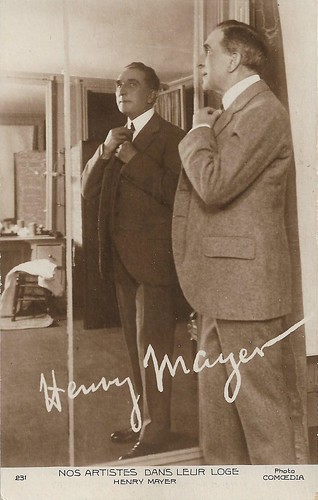
French postcard in the 'Nos artistes dans leur loge' series, no. 231. Photo: Comoedia, Paris.
French actor Henry Mayer ( 1857-1941) was a member of the Comédie-Française. Mayer debuted at Pathé Frères as the cruel Roman emperor Caligula in L'Étoile du génie (Ferdinand Zecca, René Leprince, 1913) starring Gabriel Signoret as a composer and Stacia Napierkowska as his muse. Mayer then had the lead in two SCAGL/ Pathé productions by Georges Monca and several more films followed.
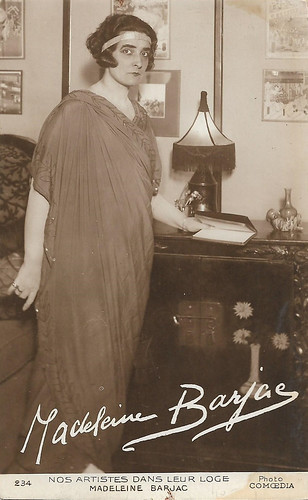
French postcard in the 'Nos artistes dans leur loge' series, no. 234. Photo: Comoedia, Paris. The outfit of Barjac may refer to one of her Racine plays on Antiquity, such as 'Iphigénie' (1920, 1924), 'Phèdre' (1920, 1925), or 'Andromaque' (1922, 1923).
Madeleine Barjac (1883-1974) was a French actress at the beginning of the 20th century. Between 1918 and 1938, she acted at the Comédie-Française, first often in plays by Racine, and from the early 1930s onward also in more modern dramas. Barjac's film career was modest. In 1910 she debuted at Pathé Frères and in the following years, she also played in silent shorts for Eclipse and Gaumont.
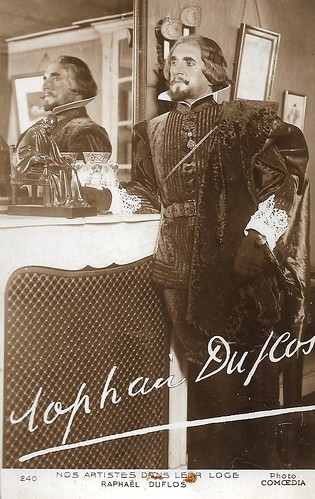
French postcard in the 'Nos artistes dans leur loge' series, no. 240. Photo: Comoedia, Paris.
Raphaël Duflos (1858-1946) was a French famous Comédie-Française stage actor, who also acted in a handful of French silent films.
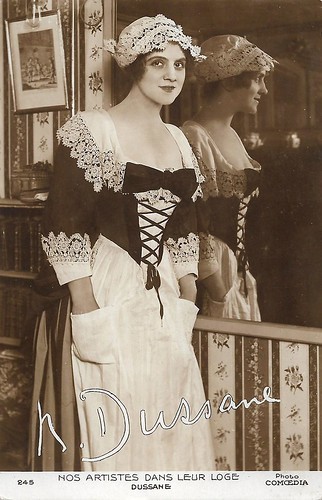
French postcard in the 'Nos artistes dans leur loge' series, no. 245. Photo: Comoedia, Paris.
Béatrix Dussane (1888-1969) was a French stage actress of the Comédie-Française and a teacher at the Conservatoire d'Art dramatique de Paris. She only acted in one film: Le Franciscain de Bourges (Claude Autant-Lara, 1968) in which she had the female lead opposite Hardy Kruger in the title role. Dussane was 80 at the time.
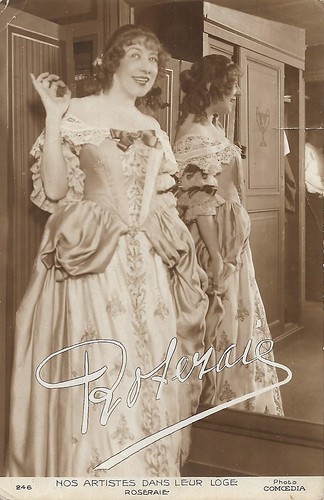
French postcard in the Nos artistes dans leur loge series, no. 246. Photo: Comoedia, Paris.
Roseraie or Mademoiselle Roseraie (?-?) was an actress of the Comédie Française, where she was 'pensionnaire' between 1918 and 1925. There she was Elise in 'Esther' (1919), Zaïre in 'Bajazet' (1920), Europe in 'Vautrin' (1922), etc. On screen, she acted in Molière, sa vie, son oeuvre (Jacques de Féraudy, 1922), in which the whole troupe of the Comédie Française collaborated. Before that, she played a small, uncredited part as a condemned woman in Albert Capellani's period drama Le chevalier de Maison-Rouge (1914), an adaptation of Alexandre Dumas and evolving during the French Terror era. As "Mademoiselle Roseraie", she acted in the Spanish production Boy (Benito Perojo, 1926), playing a countess whose lavish lifestyle ruins the protagonist, played by Juan de Orduña. In the sound era, Roseraie had a minor part in Jacques Feyder's Pension Mimosas (1935), starring Françoise Rosay.
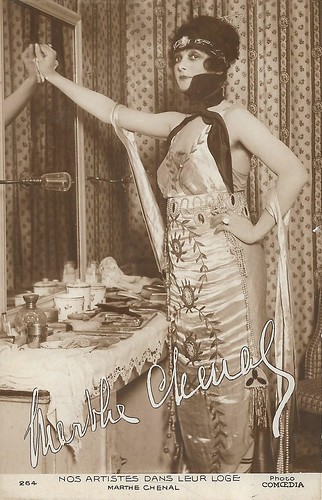
French postcard in the Nos artistes dans leur loge series, no. 264. Photo: Comoedia.
Marthe Chenal (1881-1947) was a French opera soprano active between 1905 and 1923. Although she sang with several opera companies in France and around the world, her career was mainly centered at the Palais Garnier and the Opéra-Comique in Paris. She particularly excelled in works by Jules Massenet and Camille Erlanger. Chenal was admired for her excellent singing but also for her spectacular dramatic prowess, some critics comparing her to the actress Sarah Bernhardt. A remarkable and attractive woman, Chenal was dubbed by the international press as "the most beautiful woman in Paris". She was noted for her interpretation of La Marseillaise. Her voice is preserved on a number of recordings made with Pathé in 1915. As far as known, she never acted in films.
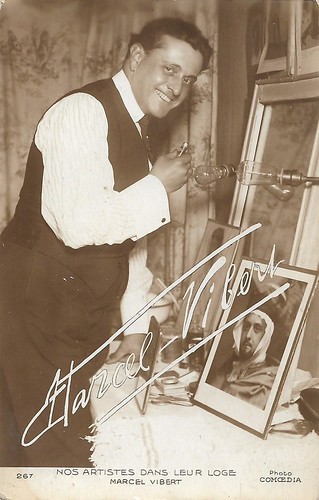
French postcard in the Nos artistes dans leur loge series, no. 267. Photo: Comoedia.
French actor Marcel Vibert (1883-1959) worked primarily in the French film industry, e.g. in Les trois mousquetaires (1912-1913), Les opprimés (1923), Le bossu (1925), Nitchevo (1926), and the first French sound film Les trois masques (1929), but in the late 1920s he also appeared in several British silent films including Moulin Rouge (1928) and Champagne (1928), as well as in Rex Ingram's American film The Garden of Allah (1927).
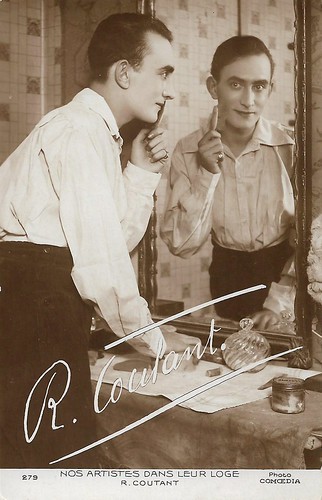
French postcard in the 'Nos artistes dans leur loge' series, no. 279. Photo: Comoedia, Paris.
Roger Coutant (?-?) acted in only three films. In 1919 he played the male lead opposite Renée Sylvaire in L'heureuse vocation (Georges Laîné, 1919). Coutant acted in the early sound film Serments (Henri Fescourt, 1931). Coutant's last film role was a small part in Cartouche (Jacques Daroy, 1934).
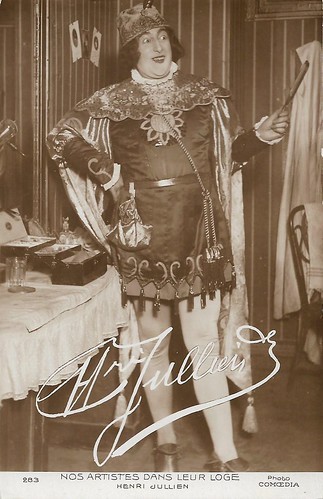
French postcard in the 'Nos artistes dans leur loge' series, no. 283. Photo: Comoedia, Paris.
Henri Jullien (1879-1961) was a French stage and screen actor. In 1912, he started to act in a series of short films at Gaumont. While absent from the sets during the First World War, he acted in three films in the early 1920s, including Pour don Carlos (1920) starring Musidora.
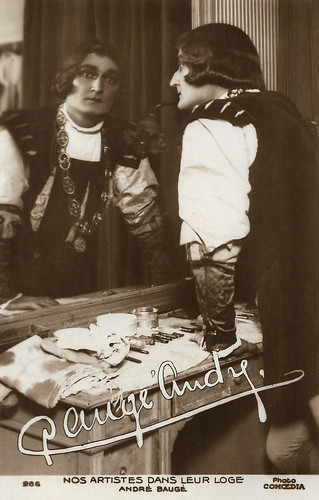
French postcard in the 'Nos artistes dans leur loge' series, no. 286. Photo: Comoedia, Paris.
André Baugé (1893-1966) was a French baritone, active in opera and operetta. He also appeared in films in the 1930s.
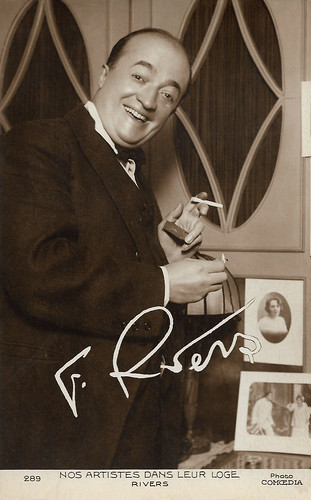
French postcard in the 'Nos artistes dans leur loge' series, no. 289. Photo: Comoedia, Paris.
Fernand Rivers (1879-1960) was a French actor, screenwriter, film producer, and director. In 1935, he produced and supervised the first two feature films directed by Sacha Guitry. Rivers pursued a career as a director until 1950.
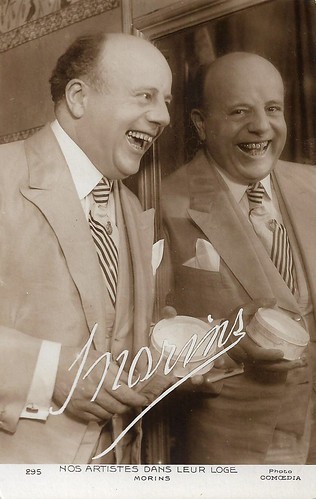
French postcard in the 'Nos artistes dans leur loge' series, no. 295. Photo: Comoedia, Paris.
Armand Morins aka Morins made his film debut in 1912 repeating his stage role of the clumsy and naive servant Joseph Turlot in the first film adaptation of the military comedy Tire-au-flanc. Morins incidentally returned to the film sets in both the silent as the sound eras.
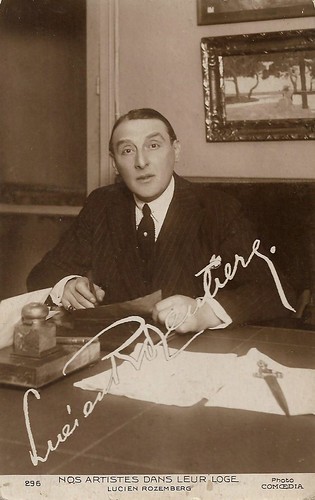
French postcard in the 'Nos artistes dans leur loge' series, no. 296. Photo: Comoedia, Paris.
Lucien Rozenberg was a French actor, screenwriter, director, and stage director. During the First World War, he began a series of humorous short films for Pathé Frères. Rozenberg played by himself, using simply his first name as character name: "Lucien". He was the star and often the director too, although Édouard-Émile Violet and Paul Garbagni also directed several Lucien farces. By mid-1919, Rozenberg put an end to his film career and returned to the theatre. After French sound cinema had set in, he returned to the film sets occasionally.
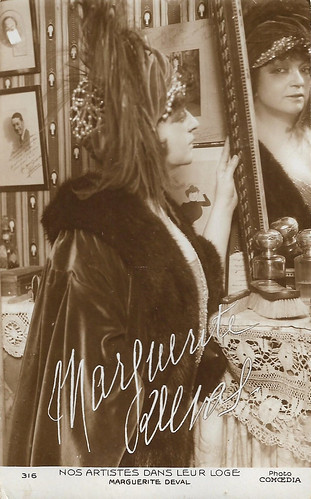
French postcard in the 'Nos artistes dans leur loge' series, no. 316. Photo: Comoedia, Paris.
Marguerite Deval (1866-1955) was a French stage and screen actress, and operetta singer. While she only acted in two silent films in the early 1910s, Deval had a rich career in French sound cinema of the 1930s and 1940s.
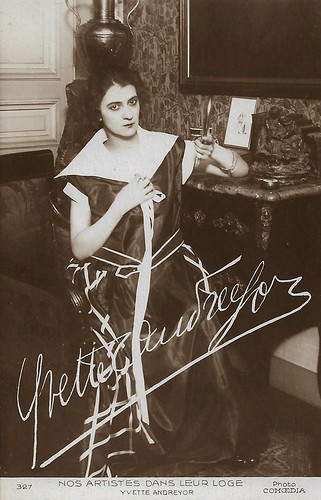
French postcard in the 'Nos artistes dans leur loge' series, no. 327. Photo: Comoedia, Paris.
Beautiful Yvette Andréyor (1891 –1962) was a French actress of the silent era. Her two most famous films were Louis Feuillades’ serials Fantômas (1913) and Judex (1916). She appeared in 108 films between 1910 and 1962.

French postcard in the 'Nos artistes dans leur loge' series, no. 2. Photo: Comoedia, Paris.
French actress and singer Mistinguett (1875-1956) captivated Paris with her risqué routines. She went on to become the most popular French entertainer of her time and the highest-paid female entertainer in the world. She appeared more than 60 times in the cinema.

French postcard in the 'Nos artistes dans leur loge' series, no. 54. Photo: Comoedia, Paris. Mistinguett .

French postcard in the 'Nos artistes dans leur loge' series, no. 58. Photo: Comoedia, Paris.
Félix Huguenet (1858-1926) only stayed two years with the Comédie Française (1906-1908) but had a rich stage career between the 1880s and the 1920s. He played in four films, including Mademoiselle de La Seiglière (André Antoine, 1921).

French postcard in the 'Nos artistes dans leur loge' series, no. 109. Photo: Comoedia, Paris.
Henri Vilbert (1870-1926) was a French stage actor and singer. Until the First World War, he was a popular singer at the Paris café-concerts, singing scabrous military songs which the working class liked, thus rivaling popular singers like Polin and Dranem. When the café-concert faded during the war he focused more on theatre and operetta. Vilbert is often confused with his nephew Henri Vilbert (1904-1997) who was a stage and film actor and played with Pagnol, Clouzot, Becker, and others.

French postcard in the Nos artistes dans leur loge series, no. 116. Photo: Comoedia, Paris.
Probably, this is Lucien Fugère (1848-1935), who was an opera singer, bass voice, associated in particular with the roles of the French repertoire and Mozart. He enjoyed an exceptionally long career and was still singing at 85. His younger brother Paul Fugère(1851-1920) already withdrew from the stage in 1911, so it is rather unlikely this is him. As far as known, none of both brothers acted in a film.

French postcard in the Nos artistes dans leur loge series, no. 134. Photo: Comoedia.
Georges Dorival (1871–1939) was a French stage and screen actor of Norman origin, a painter, and an art collector.

French postcard in the Nos artistes dans leur loge series, no. 139. Photo: Comoedia.
Georges Colin (1880-1945) was a French actor, who appeared in nearly 40 silent and sound films between 1909 and 1945.

French postcard in the 'Nos artistes dans leur loge' series, no. 149. Photo: Comoedia, Paris.
René Rocher (1890–1970) was a France stage actor and theater director. He was managing director of the Théâtre Antoine from 1928 to 1933, then the Théâtre du Vieux-Colombier from 1935 to 1943, and the Théâtre de l'Odéon from 1940 to 1944. In the 1910s he acted in four films, a.o. Le coupable (André Antoine, 1917) and Blessée au coeur (director unknown, 1917).

French postcard in the 'Nos artistes dans leur loge' series, no. 155. Photo: Comoedia, Paris.
French actor and director Jean-Étienne Pelisse aka Jean Debucourt (1894-1954) was a member of the Comédie-Française. He also acted in such silent classics as La Chute de la Maison Usher (1928) by Jean Epstein and such sound films as Mayerling (1936) by Anatole Litvak.

French postcard in the 'Nos artistes dans leur loge' series, no. 158. Photo: Comoedia, Paris.
Émile Dehelly (1871-1969) was a French stage and screen actor, who was a sociétaire of the Comédie française (1903-1928) and had a prolific career at Le Film d’Art between 1909 and 1913. He is the father of film actor Jean Dehelly.

French postcard in the 'Nos artistes dans leur loge' series, no. 175. Photo: Comoedia, Paris.
Aimée Tessandier (1851-1923) was a reputed French stage actress, who from 1908 till 1921 also had a career in French silent cinema.

French postcard in the 'Nos artistes dans leur loge' series, no. 176. Photo: Comoedia, Paris.
Pretty performer Jane Danjou is known for a few French silent films. She played small parts in the shorts L'auberge du tohu-bohu/The Inn of Tohu-Bohu (Georges Denola, 1912) and C'est pour les orphelins/For the Children (Louis Feuillade, 1916) with Musidora. She played Suzanne Grandais's friend in Midinettes/ (René Hervil, Louis Mercanton, 1917), and the tile role in Zon (Robert Boudrioz, 1920) opposite Jacques de Féraudy.

French postcard in the 'Nos artistes dans leur loge' series, no. 192. Photo: Comoedia, Paris.
Louise Silvain (1874-1930) entered the Comédie Française in 1901, became sociétaire in 1910 and sociétaire honoraire in 1925. She was married to Eugène Silvain, aka Sylvain. She acted in the films Une scène d'Andromaque à la Comédie Française (dir. unknown, 1909) and Molière, sa vie, son oeuvre (Jacques de Féraudy, 1922).

French postcard in the 'Nos artistes dans leur loge' series, no. 207. Photo: Comoedia, Paris.
French actress Thérèse Dorny (1891-1976) got great success with 'L'École des cocottes', which she performed three times in 1918, 1920, and 1923. At the start of sound cinema in France, she had a rich career in film acting, in particular in comedies such as Cognasse (Louis Mercanton, 1932).

French postcard in the 'Nos artistes dans leur loge' series, no. 231. Photo: Comoedia, Paris.
French actor Henry Mayer ( 1857-1941) was a member of the Comédie-Française. Mayer debuted at Pathé Frères as the cruel Roman emperor Caligula in L'Étoile du génie (Ferdinand Zecca, René Leprince, 1913) starring Gabriel Signoret as a composer and Stacia Napierkowska as his muse. Mayer then had the lead in two SCAGL/ Pathé productions by Georges Monca and several more films followed.

French postcard in the 'Nos artistes dans leur loge' series, no. 234. Photo: Comoedia, Paris. The outfit of Barjac may refer to one of her Racine plays on Antiquity, such as 'Iphigénie' (1920, 1924), 'Phèdre' (1920, 1925), or 'Andromaque' (1922, 1923).
Madeleine Barjac (1883-1974) was a French actress at the beginning of the 20th century. Between 1918 and 1938, she acted at the Comédie-Française, first often in plays by Racine, and from the early 1930s onward also in more modern dramas. Barjac's film career was modest. In 1910 she debuted at Pathé Frères and in the following years, she also played in silent shorts for Eclipse and Gaumont.

French postcard in the 'Nos artistes dans leur loge' series, no. 240. Photo: Comoedia, Paris.
Raphaël Duflos (1858-1946) was a French famous Comédie-Française stage actor, who also acted in a handful of French silent films.

French postcard in the 'Nos artistes dans leur loge' series, no. 245. Photo: Comoedia, Paris.
Béatrix Dussane (1888-1969) was a French stage actress of the Comédie-Française and a teacher at the Conservatoire d'Art dramatique de Paris. She only acted in one film: Le Franciscain de Bourges (Claude Autant-Lara, 1968) in which she had the female lead opposite Hardy Kruger in the title role. Dussane was 80 at the time.

French postcard in the Nos artistes dans leur loge series, no. 246. Photo: Comoedia, Paris.
Roseraie or Mademoiselle Roseraie (?-?) was an actress of the Comédie Française, where she was 'pensionnaire' between 1918 and 1925. There she was Elise in 'Esther' (1919), Zaïre in 'Bajazet' (1920), Europe in 'Vautrin' (1922), etc. On screen, she acted in Molière, sa vie, son oeuvre (Jacques de Féraudy, 1922), in which the whole troupe of the Comédie Française collaborated. Before that, she played a small, uncredited part as a condemned woman in Albert Capellani's period drama Le chevalier de Maison-Rouge (1914), an adaptation of Alexandre Dumas and evolving during the French Terror era. As "Mademoiselle Roseraie", she acted in the Spanish production Boy (Benito Perojo, 1926), playing a countess whose lavish lifestyle ruins the protagonist, played by Juan de Orduña. In the sound era, Roseraie had a minor part in Jacques Feyder's Pension Mimosas (1935), starring Françoise Rosay.

French postcard in the Nos artistes dans leur loge series, no. 264. Photo: Comoedia.
Marthe Chenal (1881-1947) was a French opera soprano active between 1905 and 1923. Although she sang with several opera companies in France and around the world, her career was mainly centered at the Palais Garnier and the Opéra-Comique in Paris. She particularly excelled in works by Jules Massenet and Camille Erlanger. Chenal was admired for her excellent singing but also for her spectacular dramatic prowess, some critics comparing her to the actress Sarah Bernhardt. A remarkable and attractive woman, Chenal was dubbed by the international press as "the most beautiful woman in Paris". She was noted for her interpretation of La Marseillaise. Her voice is preserved on a number of recordings made with Pathé in 1915. As far as known, she never acted in films.

French postcard in the Nos artistes dans leur loge series, no. 267. Photo: Comoedia.
French actor Marcel Vibert (1883-1959) worked primarily in the French film industry, e.g. in Les trois mousquetaires (1912-1913), Les opprimés (1923), Le bossu (1925), Nitchevo (1926), and the first French sound film Les trois masques (1929), but in the late 1920s he also appeared in several British silent films including Moulin Rouge (1928) and Champagne (1928), as well as in Rex Ingram's American film The Garden of Allah (1927).

French postcard in the 'Nos artistes dans leur loge' series, no. 279. Photo: Comoedia, Paris.
Roger Coutant (?-?) acted in only three films. In 1919 he played the male lead opposite Renée Sylvaire in L'heureuse vocation (Georges Laîné, 1919). Coutant acted in the early sound film Serments (Henri Fescourt, 1931). Coutant's last film role was a small part in Cartouche (Jacques Daroy, 1934).

French postcard in the 'Nos artistes dans leur loge' series, no. 283. Photo: Comoedia, Paris.
Henri Jullien (1879-1961) was a French stage and screen actor. In 1912, he started to act in a series of short films at Gaumont. While absent from the sets during the First World War, he acted in three films in the early 1920s, including Pour don Carlos (1920) starring Musidora.

French postcard in the 'Nos artistes dans leur loge' series, no. 286. Photo: Comoedia, Paris.
André Baugé (1893-1966) was a French baritone, active in opera and operetta. He also appeared in films in the 1930s.

French postcard in the 'Nos artistes dans leur loge' series, no. 289. Photo: Comoedia, Paris.
Fernand Rivers (1879-1960) was a French actor, screenwriter, film producer, and director. In 1935, he produced and supervised the first two feature films directed by Sacha Guitry. Rivers pursued a career as a director until 1950.

French postcard in the 'Nos artistes dans leur loge' series, no. 295. Photo: Comoedia, Paris.
Armand Morins aka Morins made his film debut in 1912 repeating his stage role of the clumsy and naive servant Joseph Turlot in the first film adaptation of the military comedy Tire-au-flanc. Morins incidentally returned to the film sets in both the silent as the sound eras.

French postcard in the 'Nos artistes dans leur loge' series, no. 296. Photo: Comoedia, Paris.
Lucien Rozenberg was a French actor, screenwriter, director, and stage director. During the First World War, he began a series of humorous short films for Pathé Frères. Rozenberg played by himself, using simply his first name as character name: "Lucien". He was the star and often the director too, although Édouard-Émile Violet and Paul Garbagni also directed several Lucien farces. By mid-1919, Rozenberg put an end to his film career and returned to the theatre. After French sound cinema had set in, he returned to the film sets occasionally.

French postcard in the 'Nos artistes dans leur loge' series, no. 316. Photo: Comoedia, Paris.
Marguerite Deval (1866-1955) was a French stage and screen actress, and operetta singer. While she only acted in two silent films in the early 1910s, Deval had a rich career in French sound cinema of the 1930s and 1940s.

French postcard in the 'Nos artistes dans leur loge' series, no. 327. Photo: Comoedia, Paris.
Beautiful Yvette Andréyor (1891 –1962) was a French actress of the silent era. Her two most famous films were Louis Feuillades’ serials Fantômas (1913) and Judex (1916). She appeared in 108 films between 1910 and 1962.
Published on July 16, 2021 22:00
July 15, 2021
Natalie Wood
American actress Natalie Wood (1938-1981) was one of Hollywood's most valuable and wanted actresses in the early 1960s. At 4, she started out as a child actress and at 16, she became a star, when she co-starred with James Dean in Rebel Without a Cause (1955). For this role, she was nominated for an Oscar for Best Supporting Actress. In 1961, she played Maria in the hit musical West Side Story. She was nominated twice for an Academy Award for Best Actress in a Leading Role, for Splendor in the Grass (1961) and Love with the Proper Stranger (1963). Only 43, Wood drowned during a boating trip with husband Robert Wagner and Brainstorm (1983) co-star Christopher Walken.
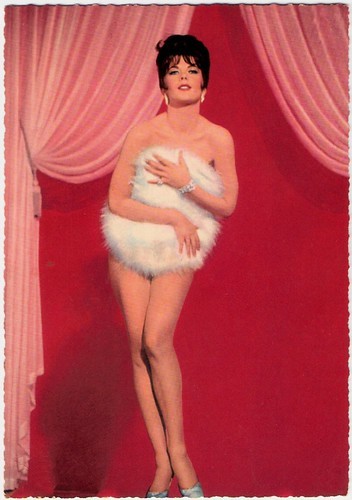
German postcard by Krüger, no. 902/247. Publicity still for Gypsy (Mervyn LeRoy, 1962).
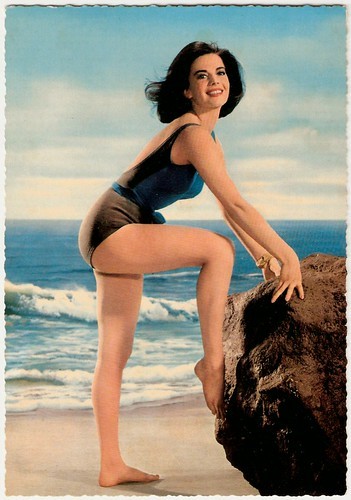
German postcard by Krüger, no. 902/258.
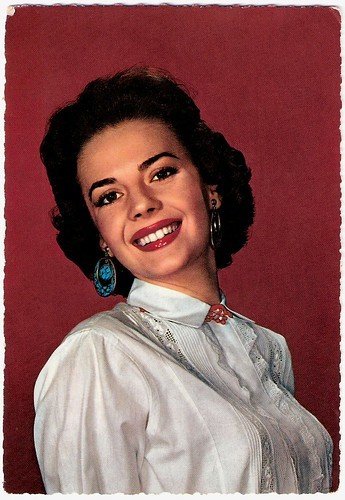
German postcard by Krüger, no. 902/31.
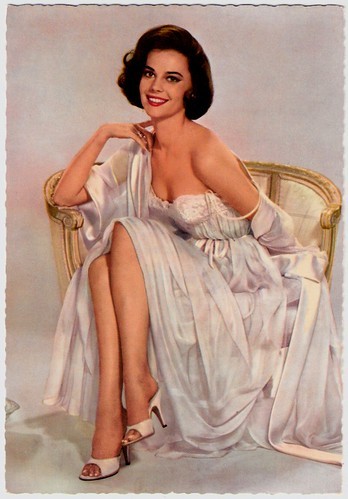
German postcard by ISV, Sort. V/6.
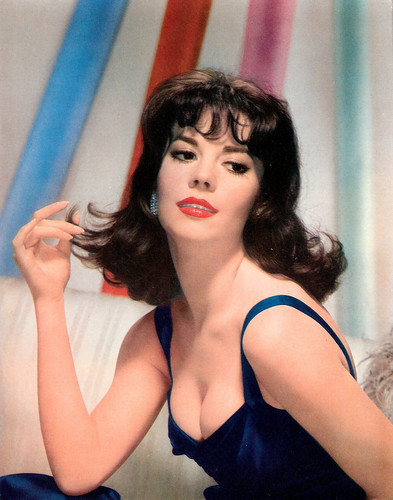
Big German card by ISV, HX 98.
A little girl who drops ice cream cone
Natalie Wood was born Natalia Nikolaevna Zakharenko in San Francisco, USA, in 1938. Her parents were Russian immigrants. Her father Nikolai Stepanovich Zakharenko was a day laborer and carpenter and her mother Maria Zudilova was a housewife. Wood's parents had to migrate due to the Russian Civil War (1917-1923).
Maria had unfulfilled ambitions of becoming an actress or ballet dancer. She wanted her daughters to pursue an acting career, and live out her dream. Maria frequently took a young Wood with her to the cinema, where Maria could study the films of Hollywood child stars. The impoverished family could not afford any other acting training to Wood.
The Zakharenko family eventually moved to Santa Rosa, where young Wood was noticed by members of a crew during a film shoot. The family moved to Los Angeles to help seek out roles for her. RKO Radio Pictures' executives William Goetz and David Lewis chose the stage name Natalie Wood for her. The first name was based on her childhood nickname Natalia, and the last name was in reference to director Sam Wood.
Natalia's younger sister Svetlana Gurdin (1946) would eventually follow an acting career as well, under the stage name Lana Wood. Natalie made her film debut in the drama Happy Land (Irving Pichel, 1943) starring Don Ameche, set in the home front of World War II. She was only 5-years-old, and her scene as the 'Little Girl Who Drops Ice Cream Cone' lasted 15 seconds.
Wood somehow attracted the interest of film director Irving Pichel who remained in contact with her family over the next few years. Wood had few job offers over the following two years, but Pichel helped her get a screen test for a more substantial role opposite Orson Welles as Wood's guardian and Claudette Colbert in the romance film Tomorrow Is Forever (Irving Pichel, 1946). Wood passed through an audition and won the role of Margaret Ludwig, a post-World War II German orphan.
At the time, Wood was "unable to cry on cue" for a key scene. So her mother tore a butterfly to pieces in front of her, giving her a reason to cry for the scene. Wood started appearing regularly in films following this role and soon received a contract with the film studio 20th Century Fox.
Her first major role was that of Susan Walker in the Christmas film Miracle on 34th Street (George Seaton, 1947), starring Edmund Gwenn and Maureen O'Hara . The film was a commercial and critical hit and Wood was counted among the top child stars in Hollywood. She received many more to play in films.
She typically appeared in family films, cast as the daughter or sister of such protagonists as Fred MacMurray, Margaret Sullavan, James Stewart, Joan Blondell , and Bette Davis . Wood appeared in over twenty films as a child actress. The California laws of the era required that until reaching adulthood, child actors had to spend at least three hours per day in the classroom, Wood received her primary education on the studio lots, receiving three hours of school lessons whenever she was working on a film. After school hours ended, Wood would hurry to the set to film her scenes.
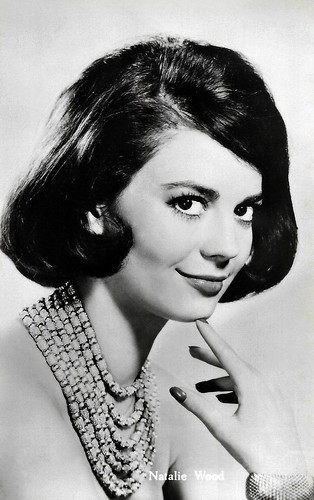
Dutch postcard by Int. Filmpers, Amsterdam, no. 363 / 817.
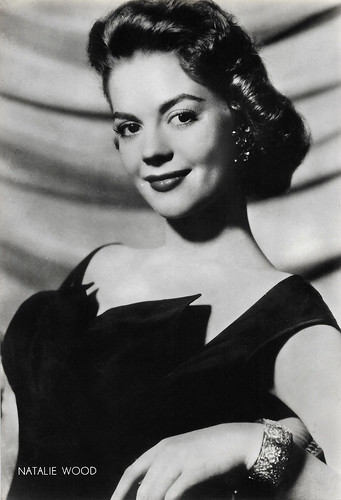
Italian postcard, no. 402.
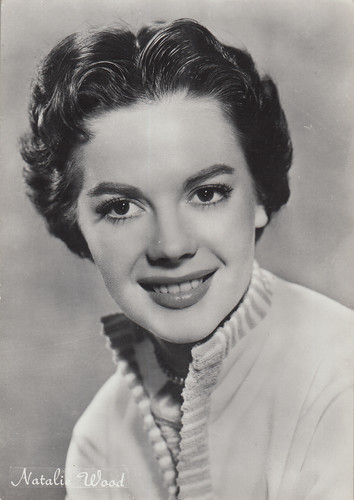
Italian postcard by Rotalfoto, no. 748. Collection: Marlene Pilaete.
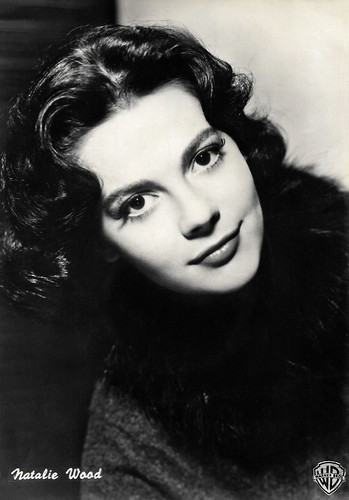
Italian postcard by Bromofoto, Milano, no. 1411. Photo: Warner Bros. Natalie Wood in Marjorie Morningstar (Irving Rapper, 1958).
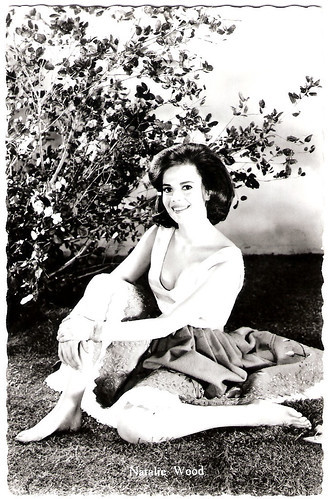
Dutch postcard. Sent by mail in the Netherlands in 1962. Publicity still for Splendor in the Grass (Elia Kazan, 1961). Collection: Geoffrey Donaldson Institute.
The transition from child star to ingenue
Natalie Wood gained her first major television role in the short-lived sitcom The Pride of the Family (1953-1954). At the age of 16, she found more success with the role of Judy in Rebel Without a Cause (Nicholas Ray, 1955) opposite James Dean and Sal Mineo . She played the role of a teenage girl who dresses up in racy clothes to attract the attention of a father (William Hopper) who typically ignores her. The film's success helped Wood make the transition from child star to ingenue. She was nominated for the Academy Award for Best Actress in a Supporting Role, but the award was instead won by Jo Van Fleet
Her next significant film was the Western The Searchers (John Ford, 1956), playing the role of abduction victim Debbie Edwards, niece of the protagonist Ethan Edwards ( John Wayne ). The film was a commercial and critical hit and has since been regarded as a masterpiece. Also in 1956, Wood graduated from Van Nuys High School, with her graduation serving as the end of her school years.
She signed a contract with Warner Brothers, where she was kept busy with several new films. To her disappointment, she was typically cast as the girlfriend of the protagonist and received roles of little depth. For a while, the studio had her paired up with teenage heartthrob Tab Hunter as a duo. The studio was hoping that the pairing would serve as a box-office draw, but this did not work out.
One of Wood's only serious roles from this period is the role of the eponymous protagonist in the melodrama Marjorie Morningstar (Irving Rapper, 1958) with Gene Kelly, playing a young Jewish girl whose efforts to create her own identity and career path clash with the expectations of her family. Wikipedia : "The central conflict in the film revolves around the traditional models of social behavior and religious behavior expected by New York Jewish families in the 1950s, and Marjorie's desire to follow an unconventional path." The film was a critical success, and fit well with other films exploring the restlessness of youth in the 1950s.
Wood's first major box office flop was the biographical film All the Fine Young Cannibals (Michael Anderson, 1960), examining the rags to riches story of jazz musician Chet Baker (played by Robert Wagner) without actually using his name. The film's box office earnings barely covered the production costs, and film studio Metro-Goldwyn-Mayer recorded a loss of 1,108,000 dollars. For the first time. Wood's appeal to the audience was in doubt.
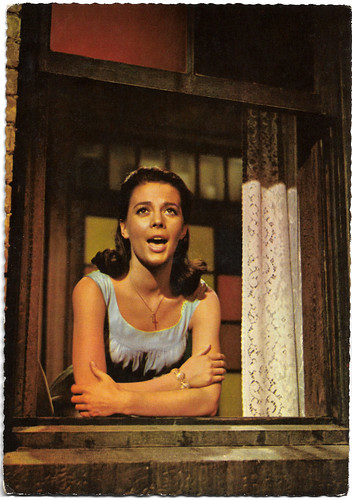
Dutch postcard by Gebr. Spanjersberg N.V., Rotterdam. Publicity still for West Side Story (Robert Wise, 1961).
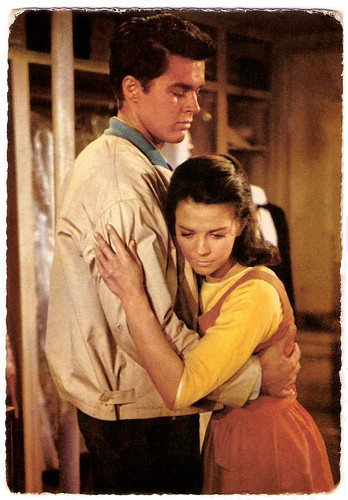
Dutch postcard by Gebr. Spanjersberg N.V., Rotterdam. Richard Beymer and Natalie Wood in West Side Story (Robert Wise, 1961).
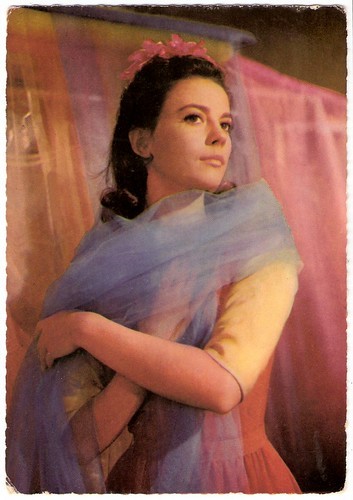
Dutch postcard by Gebr. Spanjersberg N.V., Rotterdam. Publicity still for West Side Story (Robert Wise, 1961).
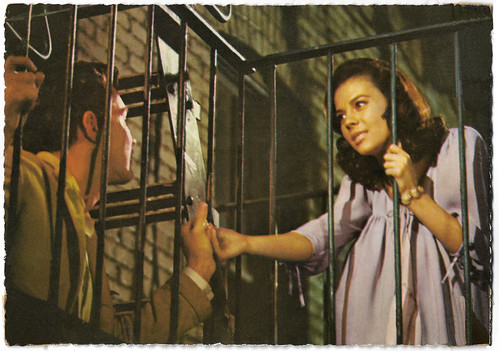
Dutch postcard by Gebr. Spanjersberg N.V., Rotterdam. Richard Beymer and Natalie Wood in West Side Story (Robert Wise, 1961).
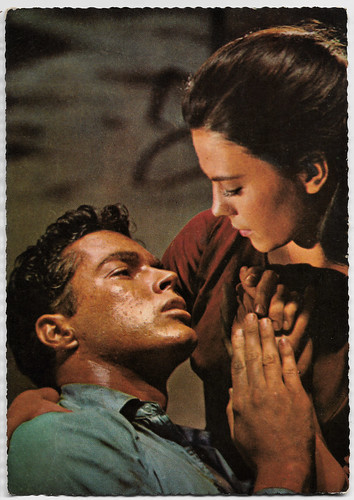
Dutch postcard by Gebr. Spanjersberg N.V., Rotterdam. Richard Beymer and Natalie Wood in West Side Story (Robert Wise, 1961).
A restless Puerto Rican girl named Maria
With her career in decline following this failure, Natalie Wood was seen as "washed up" by many in the film community. But director Elia Kazan gave her the chance to audition for the role of the sexually-repressed Wilma Dean Loomis in Splendor in the Grass (Elia Kazan, 1961) with Warren Beatty. The film was a critical success and Wood was for the first time nominated for the Academy Award for Best Actress in a Leading Role. The award was instead won by rival actress Sophia Loren .
Wood's next important film was West Side Story (Jerome Robbins, Robert Wise, 1961), where she played Maria, a restless Puerto Rican girl. Wood was once again called to represent the restlessness of youth in a film, this time in a story involving youth gangs and juvenile delinquents. The film was a great commercial success with about 44 million dollars in gross, the highest-grossing film of 1961. It was also critically acclaimed and is still regarded among the best films of Wood's career. However, Wood was disappointed that her singing voice was not used in the film. She was dubbed by Marni Nixon, who also dubbed Audrey Hepburn in My Fair Lady (George Cukor, 1964), and Deborah Kerr in The King and I (Walter Lang, 1956).
Wood's next leading role was as the burlesque entertainer and stripper Gypsy Rose Lee in the Biopic Gypsy (Mervyn LeRoy, 1962) alongside Rosalind Russell. Some film historians credit the part as an even better role for Wood than that of Maria, with witty dialogue, a greater emotional range, and complex characterisation. The film was the highest-grossing film of 1962 and well-received critically.
Wood's next significant role was that of Macy's salesclerk Angie Rossini in the comedy-drama Love with the Proper Stranger (Robert Mulligan, 1963). In the film, Angie has a one-night-stand with musician Rocky Papasano (Steve McQueen), finds herself pregnant, and desperately seeks an abortion. The film underperformed at the box office but was critically well-received. The 25-year-old Wood received her second nomination for the Oscar for Best Actress in a Leading Role, but it was won by Patricia Neal.
Wood continued her successful film career and made two comedies with Tony Curtis: Sex and the Single Girl (Richard Quine, 1964) and The Great Race (Blake Edwards, 1965), the latter also with Jack Lemmon and Peter Falk. For Inside Daisy Clover (Sydney Pollack, 1965) and This Property Is Condemned (Sydney Pollack, 1966), both of which co-starred Robert Redford , Wood received Golden Globe nominations for Best Actress.
However, her health status was not as successful. She was suffering emotionally and had sought professional therapy. She paid Warner Bros. 175,000 dollars to cancel her contract and was able to retire for a while. She also fired her entire support team: agents, managers, publicist, accountant, and attorneys. She took a three-year hiatus from acting.

British postcard in the Greetings series. Photo: Warner Bros. Collection: Marlene Pilaete.
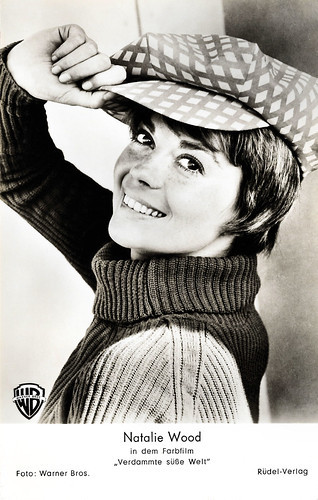
German postcard by Rüdel-Verlag, Hamburg, no. 4547. Photo: Warner Bros. Natalie Wood in Inside Daisy Clover (Robert Mulligan, 1965).
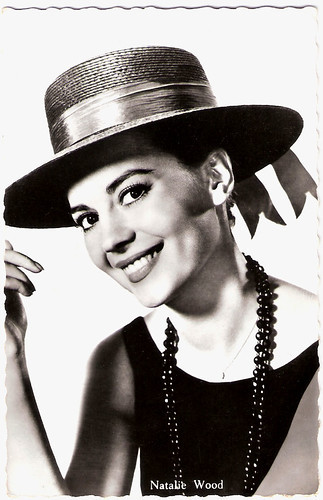
Dutch postcard, no. 812.
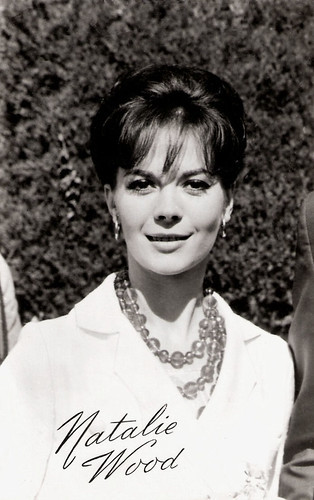
Dutch postcard.
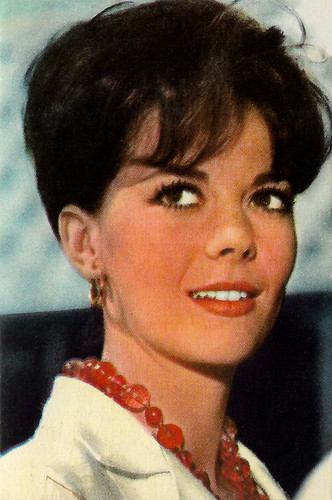
Small Belgian collectors card, no. 148.
Drowning and other undetermined factors
Natalie Wood made her comeback in the comedy-drama Bob & Carol & Ted & Alice (Paul Mazursky, 1969), with the themes of sexual liberation and wife swapping. It was a box office hit. Wood decided to gamble her 750,000 dollars fee on a percentage of the gross, earning a million dollars over the course of three years.
Wood was pregnant with her first child, Natasha Gregson (1970). She chose to go into semi-retirement to raise the child, appearing in only four more theatrical films before her death. These films were the mystery-comedy Peeper (Peter Hyams, 1975) starring Michael Caine , the Science-Fiction film Meteor (Ronald Neame, 1979) with Sean Connery, the sex comedy The Last Married Couple in America (Gilbert Cates, 1980) with George Segal and Valerie Harper, and the posthumously-released Science-Fiction film Brainstorm (Douglas Trumbull, 1983).
In the late 1970s, Wood found success in television roles. Laurence Olivier asked her to co-star with him in Cat on a Hot Tin Roof (Robert Moore, 1976). After that, she appeared in several television films and the mini-series From Here to Eternity (Buzz Kulik, 1979), with William Devane and Kim Basinger . For From Here to Eternity, she received a Golden Globe Award and high ratings.
She had plans to make her theatrical debut in a 1982 production of 'Anastasia'. On 28 November 1981, during a holiday break from the production of Brainstorm (1983), Natalie Wood joined her husband Robert Wagner, their friend Christopher Walken, and captain Dennis Davern on a weekend boat trip to Catalina Island. The four of them were on board Wagner's yacht Splendour.
On the morning of 29 November 1981, Wood's corpse was recovered 1 mile (1.6 kilometers) away from the boat. The autopsy revealed that she had drowned. Wikipedia : "The events surrounding her death have been the subject of conflicting witness statements, prompting the Los Angeles County Sheriff's Department, under the instruction of the coroner's office, to list her cause of death as 'drowning and other undetermined factors' in 2012. In 2018, Wagner was named as a person of interest in the ongoing investigation into Wood's death."
Natalie Wood was buried in Westwood Village Memorial Park Cemetery in Los Angeles. Her would-be comeback film Brainstorm (Douglas Trumbull, 1983) was incomplete at the time of her death. It was ultimately finished and released, but Wood's character had to be written out of three scenes while a stand-in and changing camera angles were used for crucial shots.
Natalie Wood was married three times. Her second husband was the British film producer and screenwriter Richard Gregson (1969-1972). She was twice married to actor Robert Wagner, from 1957 till 1962 and from 1972 till her death in 1981. She had two daughters, Natasha Gregson Wagner (1970) with Richard Gregson, and Courtney Wagner (1974) with Robert Wagner. The 2004 TV film The Mystery of Natalie Wood chronicles Wood's life and career. It was partly based on the biographies 'Natasha: the Biography of Natalie Wood' by Suzanne Finstad and 'Natalie & R.J.' by Warren G. Harris. Justine Waddell portrayed Wood.
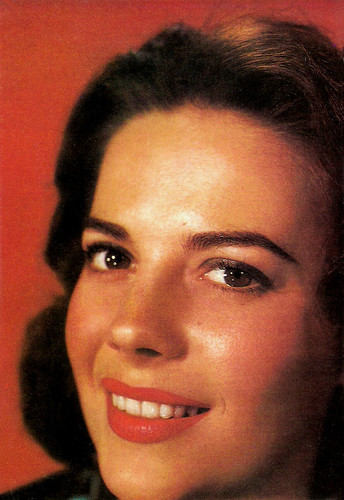
Spanish postcard by Postal Oscarcolor, Hospitalet (Barcelona), no. 31.
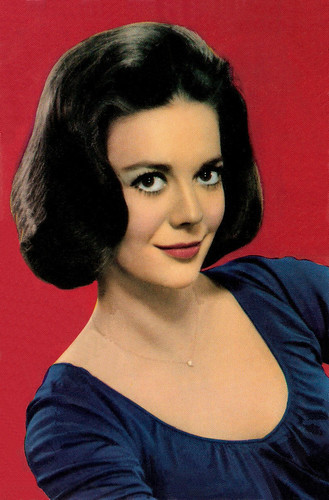
Spanish postcard by Raker, no. 1098, 1964.
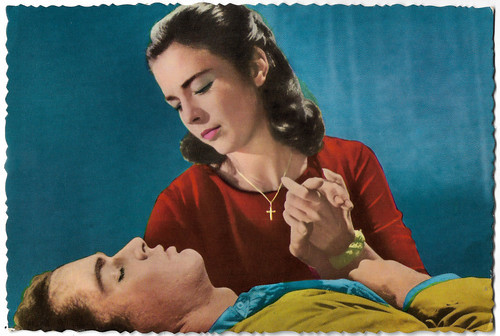
Spanish postcard by Archivo Bermejo, no. 146 C, 1964. Photo: United Artists. Richard Beymer and Natalie Wood in West Side Story (Robert Wise, Jerome Robbins, 1961).
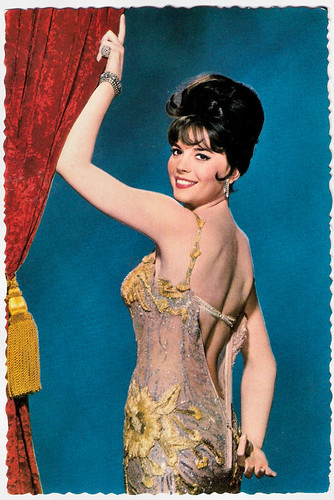
Spanish postcard by Archivo Bermejo no. C-72, 1963. Photo: Warner Bros. Publicity still for Gypsy (Mervyn LeRoy, 1962).
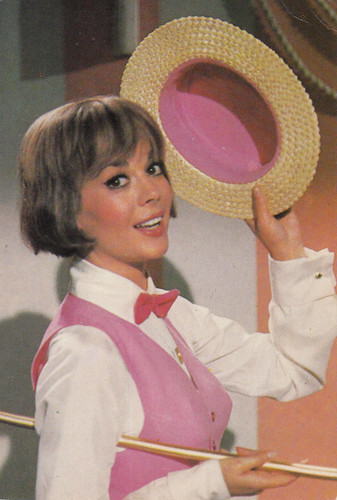
Spanish postcard by Oscar Color S.A., Hospitalet (Barcelona), no. 634d. Collection: Marlene Pilaete.
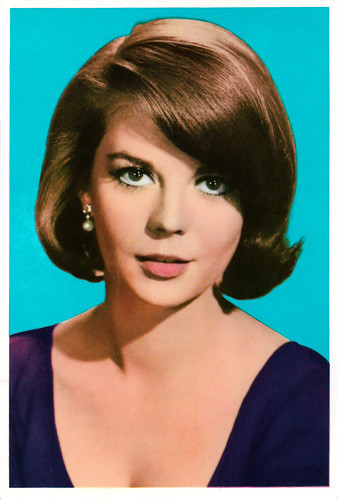
Spanish postcard, no. 342.
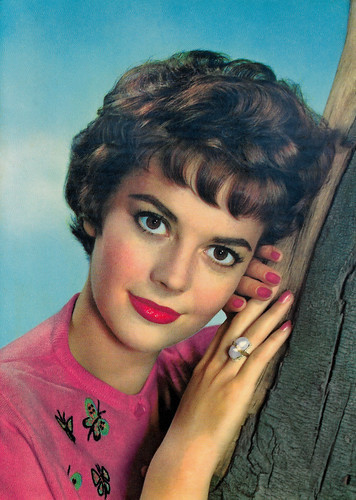
Italian postcard by Rotalfoto, Milano, no. N. 41.
Sources: (IMDb), Wikipedia, and .

German postcard by Krüger, no. 902/247. Publicity still for Gypsy (Mervyn LeRoy, 1962).

German postcard by Krüger, no. 902/258.

German postcard by Krüger, no. 902/31.

German postcard by ISV, Sort. V/6.

Big German card by ISV, HX 98.
A little girl who drops ice cream cone
Natalie Wood was born Natalia Nikolaevna Zakharenko in San Francisco, USA, in 1938. Her parents were Russian immigrants. Her father Nikolai Stepanovich Zakharenko was a day laborer and carpenter and her mother Maria Zudilova was a housewife. Wood's parents had to migrate due to the Russian Civil War (1917-1923).
Maria had unfulfilled ambitions of becoming an actress or ballet dancer. She wanted her daughters to pursue an acting career, and live out her dream. Maria frequently took a young Wood with her to the cinema, where Maria could study the films of Hollywood child stars. The impoverished family could not afford any other acting training to Wood.
The Zakharenko family eventually moved to Santa Rosa, where young Wood was noticed by members of a crew during a film shoot. The family moved to Los Angeles to help seek out roles for her. RKO Radio Pictures' executives William Goetz and David Lewis chose the stage name Natalie Wood for her. The first name was based on her childhood nickname Natalia, and the last name was in reference to director Sam Wood.
Natalia's younger sister Svetlana Gurdin (1946) would eventually follow an acting career as well, under the stage name Lana Wood. Natalie made her film debut in the drama Happy Land (Irving Pichel, 1943) starring Don Ameche, set in the home front of World War II. She was only 5-years-old, and her scene as the 'Little Girl Who Drops Ice Cream Cone' lasted 15 seconds.
Wood somehow attracted the interest of film director Irving Pichel who remained in contact with her family over the next few years. Wood had few job offers over the following two years, but Pichel helped her get a screen test for a more substantial role opposite Orson Welles as Wood's guardian and Claudette Colbert in the romance film Tomorrow Is Forever (Irving Pichel, 1946). Wood passed through an audition and won the role of Margaret Ludwig, a post-World War II German orphan.
At the time, Wood was "unable to cry on cue" for a key scene. So her mother tore a butterfly to pieces in front of her, giving her a reason to cry for the scene. Wood started appearing regularly in films following this role and soon received a contract with the film studio 20th Century Fox.
Her first major role was that of Susan Walker in the Christmas film Miracle on 34th Street (George Seaton, 1947), starring Edmund Gwenn and Maureen O'Hara . The film was a commercial and critical hit and Wood was counted among the top child stars in Hollywood. She received many more to play in films.
She typically appeared in family films, cast as the daughter or sister of such protagonists as Fred MacMurray, Margaret Sullavan, James Stewart, Joan Blondell , and Bette Davis . Wood appeared in over twenty films as a child actress. The California laws of the era required that until reaching adulthood, child actors had to spend at least three hours per day in the classroom, Wood received her primary education on the studio lots, receiving three hours of school lessons whenever she was working on a film. After school hours ended, Wood would hurry to the set to film her scenes.

Dutch postcard by Int. Filmpers, Amsterdam, no. 363 / 817.

Italian postcard, no. 402.

Italian postcard by Rotalfoto, no. 748. Collection: Marlene Pilaete.

Italian postcard by Bromofoto, Milano, no. 1411. Photo: Warner Bros. Natalie Wood in Marjorie Morningstar (Irving Rapper, 1958).

Dutch postcard. Sent by mail in the Netherlands in 1962. Publicity still for Splendor in the Grass (Elia Kazan, 1961). Collection: Geoffrey Donaldson Institute.
The transition from child star to ingenue
Natalie Wood gained her first major television role in the short-lived sitcom The Pride of the Family (1953-1954). At the age of 16, she found more success with the role of Judy in Rebel Without a Cause (Nicholas Ray, 1955) opposite James Dean and Sal Mineo . She played the role of a teenage girl who dresses up in racy clothes to attract the attention of a father (William Hopper) who typically ignores her. The film's success helped Wood make the transition from child star to ingenue. She was nominated for the Academy Award for Best Actress in a Supporting Role, but the award was instead won by Jo Van Fleet
Her next significant film was the Western The Searchers (John Ford, 1956), playing the role of abduction victim Debbie Edwards, niece of the protagonist Ethan Edwards ( John Wayne ). The film was a commercial and critical hit and has since been regarded as a masterpiece. Also in 1956, Wood graduated from Van Nuys High School, with her graduation serving as the end of her school years.
She signed a contract with Warner Brothers, where she was kept busy with several new films. To her disappointment, she was typically cast as the girlfriend of the protagonist and received roles of little depth. For a while, the studio had her paired up with teenage heartthrob Tab Hunter as a duo. The studio was hoping that the pairing would serve as a box-office draw, but this did not work out.
One of Wood's only serious roles from this period is the role of the eponymous protagonist in the melodrama Marjorie Morningstar (Irving Rapper, 1958) with Gene Kelly, playing a young Jewish girl whose efforts to create her own identity and career path clash with the expectations of her family. Wikipedia : "The central conflict in the film revolves around the traditional models of social behavior and religious behavior expected by New York Jewish families in the 1950s, and Marjorie's desire to follow an unconventional path." The film was a critical success, and fit well with other films exploring the restlessness of youth in the 1950s.
Wood's first major box office flop was the biographical film All the Fine Young Cannibals (Michael Anderson, 1960), examining the rags to riches story of jazz musician Chet Baker (played by Robert Wagner) without actually using his name. The film's box office earnings barely covered the production costs, and film studio Metro-Goldwyn-Mayer recorded a loss of 1,108,000 dollars. For the first time. Wood's appeal to the audience was in doubt.

Dutch postcard by Gebr. Spanjersberg N.V., Rotterdam. Publicity still for West Side Story (Robert Wise, 1961).

Dutch postcard by Gebr. Spanjersberg N.V., Rotterdam. Richard Beymer and Natalie Wood in West Side Story (Robert Wise, 1961).

Dutch postcard by Gebr. Spanjersberg N.V., Rotterdam. Publicity still for West Side Story (Robert Wise, 1961).

Dutch postcard by Gebr. Spanjersberg N.V., Rotterdam. Richard Beymer and Natalie Wood in West Side Story (Robert Wise, 1961).

Dutch postcard by Gebr. Spanjersberg N.V., Rotterdam. Richard Beymer and Natalie Wood in West Side Story (Robert Wise, 1961).
A restless Puerto Rican girl named Maria
With her career in decline following this failure, Natalie Wood was seen as "washed up" by many in the film community. But director Elia Kazan gave her the chance to audition for the role of the sexually-repressed Wilma Dean Loomis in Splendor in the Grass (Elia Kazan, 1961) with Warren Beatty. The film was a critical success and Wood was for the first time nominated for the Academy Award for Best Actress in a Leading Role. The award was instead won by rival actress Sophia Loren .
Wood's next important film was West Side Story (Jerome Robbins, Robert Wise, 1961), where she played Maria, a restless Puerto Rican girl. Wood was once again called to represent the restlessness of youth in a film, this time in a story involving youth gangs and juvenile delinquents. The film was a great commercial success with about 44 million dollars in gross, the highest-grossing film of 1961. It was also critically acclaimed and is still regarded among the best films of Wood's career. However, Wood was disappointed that her singing voice was not used in the film. She was dubbed by Marni Nixon, who also dubbed Audrey Hepburn in My Fair Lady (George Cukor, 1964), and Deborah Kerr in The King and I (Walter Lang, 1956).
Wood's next leading role was as the burlesque entertainer and stripper Gypsy Rose Lee in the Biopic Gypsy (Mervyn LeRoy, 1962) alongside Rosalind Russell. Some film historians credit the part as an even better role for Wood than that of Maria, with witty dialogue, a greater emotional range, and complex characterisation. The film was the highest-grossing film of 1962 and well-received critically.
Wood's next significant role was that of Macy's salesclerk Angie Rossini in the comedy-drama Love with the Proper Stranger (Robert Mulligan, 1963). In the film, Angie has a one-night-stand with musician Rocky Papasano (Steve McQueen), finds herself pregnant, and desperately seeks an abortion. The film underperformed at the box office but was critically well-received. The 25-year-old Wood received her second nomination for the Oscar for Best Actress in a Leading Role, but it was won by Patricia Neal.
Wood continued her successful film career and made two comedies with Tony Curtis: Sex and the Single Girl (Richard Quine, 1964) and The Great Race (Blake Edwards, 1965), the latter also with Jack Lemmon and Peter Falk. For Inside Daisy Clover (Sydney Pollack, 1965) and This Property Is Condemned (Sydney Pollack, 1966), both of which co-starred Robert Redford , Wood received Golden Globe nominations for Best Actress.
However, her health status was not as successful. She was suffering emotionally and had sought professional therapy. She paid Warner Bros. 175,000 dollars to cancel her contract and was able to retire for a while. She also fired her entire support team: agents, managers, publicist, accountant, and attorneys. She took a three-year hiatus from acting.

British postcard in the Greetings series. Photo: Warner Bros. Collection: Marlene Pilaete.

German postcard by Rüdel-Verlag, Hamburg, no. 4547. Photo: Warner Bros. Natalie Wood in Inside Daisy Clover (Robert Mulligan, 1965).

Dutch postcard, no. 812.

Dutch postcard.

Small Belgian collectors card, no. 148.
Drowning and other undetermined factors
Natalie Wood made her comeback in the comedy-drama Bob & Carol & Ted & Alice (Paul Mazursky, 1969), with the themes of sexual liberation and wife swapping. It was a box office hit. Wood decided to gamble her 750,000 dollars fee on a percentage of the gross, earning a million dollars over the course of three years.
Wood was pregnant with her first child, Natasha Gregson (1970). She chose to go into semi-retirement to raise the child, appearing in only four more theatrical films before her death. These films were the mystery-comedy Peeper (Peter Hyams, 1975) starring Michael Caine , the Science-Fiction film Meteor (Ronald Neame, 1979) with Sean Connery, the sex comedy The Last Married Couple in America (Gilbert Cates, 1980) with George Segal and Valerie Harper, and the posthumously-released Science-Fiction film Brainstorm (Douglas Trumbull, 1983).
In the late 1970s, Wood found success in television roles. Laurence Olivier asked her to co-star with him in Cat on a Hot Tin Roof (Robert Moore, 1976). After that, she appeared in several television films and the mini-series From Here to Eternity (Buzz Kulik, 1979), with William Devane and Kim Basinger . For From Here to Eternity, she received a Golden Globe Award and high ratings.
She had plans to make her theatrical debut in a 1982 production of 'Anastasia'. On 28 November 1981, during a holiday break from the production of Brainstorm (1983), Natalie Wood joined her husband Robert Wagner, their friend Christopher Walken, and captain Dennis Davern on a weekend boat trip to Catalina Island. The four of them were on board Wagner's yacht Splendour.
On the morning of 29 November 1981, Wood's corpse was recovered 1 mile (1.6 kilometers) away from the boat. The autopsy revealed that she had drowned. Wikipedia : "The events surrounding her death have been the subject of conflicting witness statements, prompting the Los Angeles County Sheriff's Department, under the instruction of the coroner's office, to list her cause of death as 'drowning and other undetermined factors' in 2012. In 2018, Wagner was named as a person of interest in the ongoing investigation into Wood's death."
Natalie Wood was buried in Westwood Village Memorial Park Cemetery in Los Angeles. Her would-be comeback film Brainstorm (Douglas Trumbull, 1983) was incomplete at the time of her death. It was ultimately finished and released, but Wood's character had to be written out of three scenes while a stand-in and changing camera angles were used for crucial shots.
Natalie Wood was married three times. Her second husband was the British film producer and screenwriter Richard Gregson (1969-1972). She was twice married to actor Robert Wagner, from 1957 till 1962 and from 1972 till her death in 1981. She had two daughters, Natasha Gregson Wagner (1970) with Richard Gregson, and Courtney Wagner (1974) with Robert Wagner. The 2004 TV film The Mystery of Natalie Wood chronicles Wood's life and career. It was partly based on the biographies 'Natasha: the Biography of Natalie Wood' by Suzanne Finstad and 'Natalie & R.J.' by Warren G. Harris. Justine Waddell portrayed Wood.

Spanish postcard by Postal Oscarcolor, Hospitalet (Barcelona), no. 31.

Spanish postcard by Raker, no. 1098, 1964.

Spanish postcard by Archivo Bermejo, no. 146 C, 1964. Photo: United Artists. Richard Beymer and Natalie Wood in West Side Story (Robert Wise, Jerome Robbins, 1961).

Spanish postcard by Archivo Bermejo no. C-72, 1963. Photo: Warner Bros. Publicity still for Gypsy (Mervyn LeRoy, 1962).

Spanish postcard by Oscar Color S.A., Hospitalet (Barcelona), no. 634d. Collection: Marlene Pilaete.

Spanish postcard, no. 342.

Italian postcard by Rotalfoto, Milano, no. N. 41.
Sources: (IMDb), Wikipedia, and .
Published on July 15, 2021 22:00
July 14, 2021
Colette Brettel
Colette Brettel (1902-1973) was a British silent film actress who moved to Berlin in 1924. There she met her future husband, Ernst Winar, in whose films she often starred. She had a busy film career in German films until sound film drove her back to Britain.
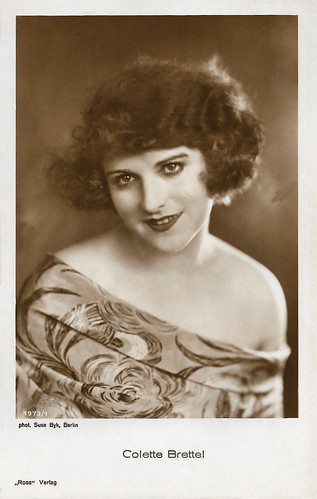
German postcard by Ross Verlag, Berlin, no. 1973/1, 1927-1928. Photo: Suse Byk, Berlin.
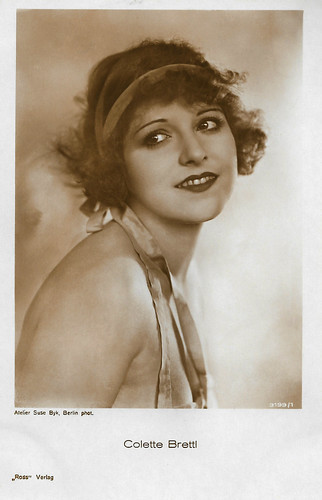
German postcard by Ross Verlag, Berlin, no. 3199/1, 1928-1929. Photo: Suse Byk, Berlin.
Wuthering Heights
Colette Brettel was born Dorothy Nicolette Pettigrew in London in 1902.
She made her screen debut as Cathy Earnshaw in Wuthering Heights (A.V. Bramble, 1920), the first screen adaptation of Emily Brontë's classic 1847 novel of destructive love. Milton Rosmer co-starred as Heathcliff and the film was primarily shot in and around Brontë's home village of Haworth. Sadly, this silent version is considered to be a lost film.
Brettel then appeared in several British films of the early 1920s including the British-Dutch crime film Blood Money/Bloedgeld (Fred Goodwins, 1921) with Adelqui Migliar and The Prodigal Son (A. E. Coleby, 1923), shot in Iceland and the Riviera, and starring Henry Victor and Stewart Rome .
The Prodigal Son's original release length was 18,454 feet (280 minutes) which made it the longest commercially made British film. It was shown in two consecutive parts. The film was not a commercial success on its release and was attacked by critics. It was perhaps the biggest failure of all the films released by Stoll Pictures, the largest British film company of the early 1920s. However, the film was re-released in 1929 with a greatly reduced running time.
The British film industry was losing out to heavy competition from Hollywood, which was helped by its much larger home market. The 'Slump' of 1924 caused many British film studios to close. When the number of British films released sharply declined, Colette Brettel moved to the European film capital at the time, Berlin.
On the set of her first German film, Wettlauf zum Glück/Race for luck (Bruno Ziener 1924), Brettel met her future husband, the Dutch actor and director Ernst Winar . Wettlauf zum Glück/Race for luck was set in Tibet, but filmed in Europe.
Next she appeared with Winar in Komödie des Herzens/Comedy of the heart (Rochus Gliese, 1924) starring Lil Dagover and Nigel Barrie. The film was co-scripted by the great director F.W. Murnau and was one of Ufa's major releases of the 1923-1925 boom period.
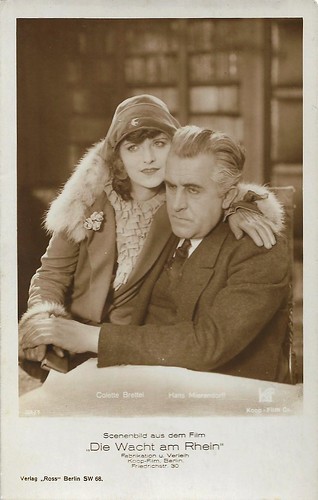
German postcard by Ross Verlag, Berlin, no. 51/1. Photo: Koop Film, Berlin. Hans Mierendorff as the industrialist Franz Großmann and Colette Brettel as his daughter in Die Wacht am Rhein/Aus des Rheinlands Schicksalstagen/Watch on the Rhine (Helene Lackner, 1926).
A fruitful career in Germany
Colette Brettel had a fruitful career in Germany and was known for her voluptuous figure, according to IMDb . She was directed by a wide range of directors such as Manfred Noa, Hans Steinhoff, and Fred Sauer. Steinhoff directed her in the silent operetta film Gräfin Mariza/Countess Maritza (Hans Steinhoff, 1925) with Vivian Gibson and Harry Liedtke . It is an adaptation of the operetta of the same title by Hungarian composer Emmerich Kálmán.
The young Marlene Dietrich played her daughter in the drama Der Juxbaron/The Imaginary Baron (Willi Wolff, 1927) starring Reinhold Schünzel as the title figure. Brettel had a supporting role in the romantic comedy Der moderne Casanova/A Modern Casanova (Max Obal, Rudolf Walther-Fein, 1928) starring Harry Liedtke , María Corda and Ernö Verebes .
She acted in several films of her husband Ernst Winar , including his first film as director, the controversial § 182 Minderjährig/Paragraph 182 (Ernst Winar, 1927). She also played in his Der Neffe aus Amerika/The nephew from America (Ernst Winar, 1927), Das Haus am Krögel/The house on the Krögel (Ernst Winar, 1927), and Der Hafenbaron/The Harbour Baron (Ernst Winar, 1928) with Hans Brausewetter .
Brettel did not master the German language and quitted cinema when the sound film set in. Her final German film was Die nicht heiraten dürfen/Who are not allowed to marry (Carl Heinz Rudolph, 1929) with André Mattoni .
Colette Brettel moved back to Britain, where she did not make films anymore. Ernst Winar returned to the Netherlands and he would direct several Dutch films and became the film coach for a young student director called Paul Verhoeven .
Colette Brettel died in Sheffield, Great Britain, in 1973. About how and when her marriage with Winar ended, we could not find any information online.
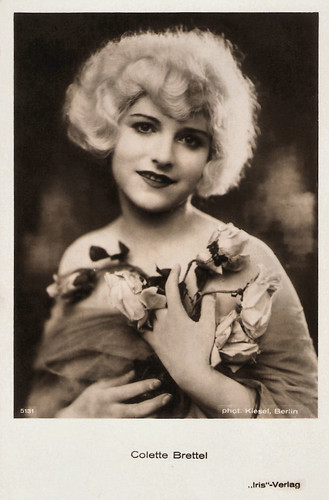
Austrian postcard by Iris-Verlag, no. 5131. Photo: Kiesel, Berlin.
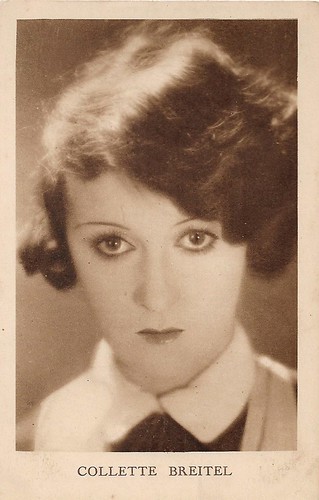
Belgian postcard by S.A. Cacao et Chocolat Kivou, Vilvoorde / N.V. Cacao en Chocolade Kivou, Vilvoorde. Photo: Artistes Associés (United Artists). Brettel's name is misspelled on this card.
Sources: Wikipedia and .

German postcard by Ross Verlag, Berlin, no. 1973/1, 1927-1928. Photo: Suse Byk, Berlin.

German postcard by Ross Verlag, Berlin, no. 3199/1, 1928-1929. Photo: Suse Byk, Berlin.
Wuthering Heights
Colette Brettel was born Dorothy Nicolette Pettigrew in London in 1902.
She made her screen debut as Cathy Earnshaw in Wuthering Heights (A.V. Bramble, 1920), the first screen adaptation of Emily Brontë's classic 1847 novel of destructive love. Milton Rosmer co-starred as Heathcliff and the film was primarily shot in and around Brontë's home village of Haworth. Sadly, this silent version is considered to be a lost film.
Brettel then appeared in several British films of the early 1920s including the British-Dutch crime film Blood Money/Bloedgeld (Fred Goodwins, 1921) with Adelqui Migliar and The Prodigal Son (A. E. Coleby, 1923), shot in Iceland and the Riviera, and starring Henry Victor and Stewart Rome .
The Prodigal Son's original release length was 18,454 feet (280 minutes) which made it the longest commercially made British film. It was shown in two consecutive parts. The film was not a commercial success on its release and was attacked by critics. It was perhaps the biggest failure of all the films released by Stoll Pictures, the largest British film company of the early 1920s. However, the film was re-released in 1929 with a greatly reduced running time.
The British film industry was losing out to heavy competition from Hollywood, which was helped by its much larger home market. The 'Slump' of 1924 caused many British film studios to close. When the number of British films released sharply declined, Colette Brettel moved to the European film capital at the time, Berlin.
On the set of her first German film, Wettlauf zum Glück/Race for luck (Bruno Ziener 1924), Brettel met her future husband, the Dutch actor and director Ernst Winar . Wettlauf zum Glück/Race for luck was set in Tibet, but filmed in Europe.
Next she appeared with Winar in Komödie des Herzens/Comedy of the heart (Rochus Gliese, 1924) starring Lil Dagover and Nigel Barrie. The film was co-scripted by the great director F.W. Murnau and was one of Ufa's major releases of the 1923-1925 boom period.

German postcard by Ross Verlag, Berlin, no. 51/1. Photo: Koop Film, Berlin. Hans Mierendorff as the industrialist Franz Großmann and Colette Brettel as his daughter in Die Wacht am Rhein/Aus des Rheinlands Schicksalstagen/Watch on the Rhine (Helene Lackner, 1926).
A fruitful career in Germany
Colette Brettel had a fruitful career in Germany and was known for her voluptuous figure, according to IMDb . She was directed by a wide range of directors such as Manfred Noa, Hans Steinhoff, and Fred Sauer. Steinhoff directed her in the silent operetta film Gräfin Mariza/Countess Maritza (Hans Steinhoff, 1925) with Vivian Gibson and Harry Liedtke . It is an adaptation of the operetta of the same title by Hungarian composer Emmerich Kálmán.
The young Marlene Dietrich played her daughter in the drama Der Juxbaron/The Imaginary Baron (Willi Wolff, 1927) starring Reinhold Schünzel as the title figure. Brettel had a supporting role in the romantic comedy Der moderne Casanova/A Modern Casanova (Max Obal, Rudolf Walther-Fein, 1928) starring Harry Liedtke , María Corda and Ernö Verebes .
She acted in several films of her husband Ernst Winar , including his first film as director, the controversial § 182 Minderjährig/Paragraph 182 (Ernst Winar, 1927). She also played in his Der Neffe aus Amerika/The nephew from America (Ernst Winar, 1927), Das Haus am Krögel/The house on the Krögel (Ernst Winar, 1927), and Der Hafenbaron/The Harbour Baron (Ernst Winar, 1928) with Hans Brausewetter .
Brettel did not master the German language and quitted cinema when the sound film set in. Her final German film was Die nicht heiraten dürfen/Who are not allowed to marry (Carl Heinz Rudolph, 1929) with André Mattoni .
Colette Brettel moved back to Britain, where she did not make films anymore. Ernst Winar returned to the Netherlands and he would direct several Dutch films and became the film coach for a young student director called Paul Verhoeven .
Colette Brettel died in Sheffield, Great Britain, in 1973. About how and when her marriage with Winar ended, we could not find any information online.

Austrian postcard by Iris-Verlag, no. 5131. Photo: Kiesel, Berlin.

Belgian postcard by S.A. Cacao et Chocolat Kivou, Vilvoorde / N.V. Cacao en Chocolade Kivou, Vilvoorde. Photo: Artistes Associés (United Artists). Brettel's name is misspelled on this card.
Sources: Wikipedia and .
Published on July 14, 2021 22:00
July 13, 2021
Delenda Carthago! (1914)
Next week, on 21 July 2021, a fragment of the lost film Delenda Carthago! (Tragedia dell'età antica)/The Destruction of Carthage (Luigi Maggi, 1914) will be presented at Il Cinema Ritrovato in Bologna. The fragment was found in the Komiya collection of the National Film Archive Japan. Delenda Carthago! was an Ambrosio production that premiered in Italy in April 1914 and starred Eugenia Tettono Fior as Miarka and François-Paul Donadio as Shabarim. Ivo Blom found a complete set of six small Spanish collectors cards made in the 1910s for this spectacular Italian silent film.
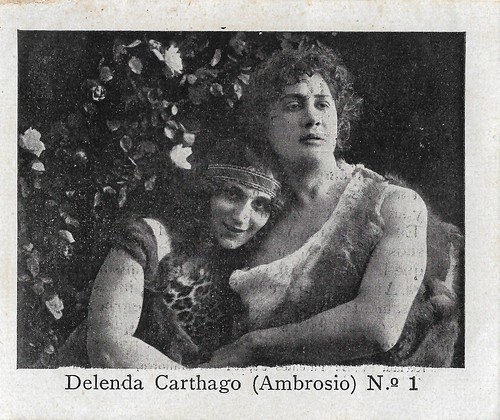
Spanish minicard, no. 1. Photo: Ambrosio. Eugenia Tettono Fior as Miarka and François-Paul Donadio as Shabarim in Delenda Carthago! (Tragedia dell'età antica) (Luigi Maggi, 1914).
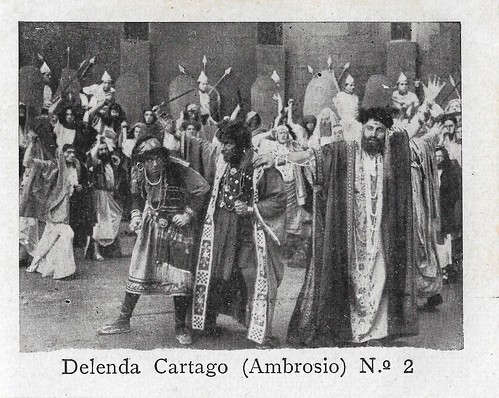
Spanish minicard, no. 2. Photo: Ambrosio. Scen from Delenda Carthago! (Tragedia dell'età antica) (Luigi Maggi, 1914).
François-Paul Donadio and Eugenia Tettoni
François-Paul Donadio was an Argentine [?] actor who played in Italian silent cinema between 1914 and 1921. In his first years, Donadio was a regular actor of the troupe at Ambrosio Film, acting in films such as Delenda Carthago! (Tragedia dell'età antica) (Luigi Maggi, 1914), and Romanticismo (Carlo Campogalliani, Arrigo Frusta, 1915) starring Tullio Carminati and Helena Makowska .
In 1916 followed Zvani (Gino Zaccaria 1916) starring Rita Jolivet , Monna Vanna (Mario Caserini, 1916) starring Madeleine Céliat , and Val d'olivi/Valley of the Olive Trees (1916) again starring Carminati and Makowska. In the late 1910s he acted with Helena Makowska in such films as Il principe Zilah (1919), and Folgore (1919) at Gladiator Film.
Donadio made his last films at Rodolfi Film, where he was often directed by Guido Brignone. He co-starred with Lola Visconti Brignone in Fiamma nera (1921), and with Mercedes Brignone in Il quadro di Osvaldo Mars (1921). He also acted in one of Carlo Aldini 's earliest films, Ajax (Raimondo Scotti, 1921). All in all, Donadio acted in a little over 30 films.
Eugenia Tettoni (1882-1969) was born in Turin. She started her career at Milano Films, together with her husband, actor Vittorio Tettoni, as Calypso (other sources say Penelope) in L'Odissea (Giuseppe De Liguoro, 1911). She acted in various Milano Film short productions in 1911-1912 and changed to the Ambrosio company in 1913, where she played in features, e.g. as Jone in Gli ultimi giorni di Pompei/The Last Days of Pompei (Eleuterio Rodolfi, 1913), the nun of Monza in I promessi sposi/The Betrothed (Eleuterio Rodolfi, 1913), and Josephine de Beauharnais in Epopea napoleonica (Edoardo Bencivenga, 1914).
Also memorable was her part of the adulterous Elena Loredano in Il fornaretto di Venezia (Luigi Maggi, 1914). Until 1921 Tettoni had a steady but not intense career in Italian silent film, mostly in supporting parts, at companies such as Savoia, Corona, Photo-Drama, Vay, and Audax. From 1922 she only acted on stage, with her by then ex-husband Vittorio Tettoni.
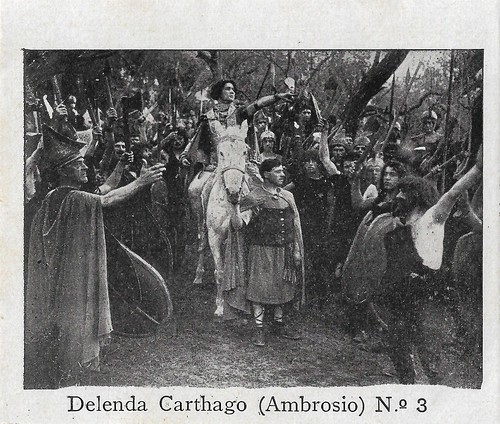
Spanish minicard, no. 3. Photo: Ambrosio. Eugenia Tettono Fior as Miarka and François-Paul Donadio as Shabarim in Delenda Carthago! (Tragedia dell'età antica) (Luigi Maggi, 1914).
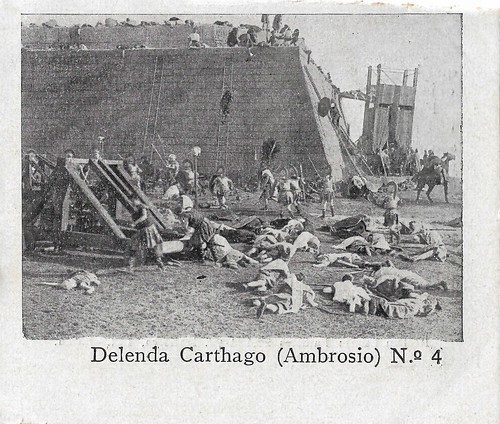
Spanish minicard, no. 4. Photo: Ambrosio. Scene from Delenda Carthago! (Tragedia dell'età antica) (Luigi Maggi, 1914).
Some historical and literary elements and much fantasy
The plot of Delenda Carthago!/The Destruction of Carthage (1914) has some historical and literary elements, e.g. Flaubert's 'Salammbô', but also contains much fantasy. In ancient times Rome looked upon Carthage as her greatest rival and determined to plan her downfall. Cato (Umberto Scalpellini), a Roman Senator, appeals to the Senate to conquer Carthage, and under a pretext that she had failed to keep the faith, the Romans begin a new war.
The Roman army led by Scipio (Marcel Fabre) embarks for Africa and lands near Carthage. This ends the prologue. When General Hasdrubal (Luigi Chiesa) sees from the city walls the retreat of the Carthaginian mercenaries led by Hanno (Annone), he conspires to cause the downfall of Hanno. He induces the city council to bar the mercenary troops from the town, fearing disorder and plundering. Messengers are dispatched to the warriors with this command, and they rebel, but Hanno calms them by promising to present their grievances. Hasdrubal denounces Hanno, and upon the latter's appearance in the Senate, he is assassinated.
Miarka (Eugenia Tettoni), daughter of Hasdrubal, is harassed when going to the Temple of Tanit, but Hanno's lieutenant Shabarim (François-Paul Donadio), defends her and escorts her to the city. The impatient warriors start an uproar outside the city, but Hasdrubal calms them, consenting to receive a deputation with their grievances. Shabarim heads the delegation and is received by Hasdrubal, who apparently yields to the soldiers' request. Upon beholding Shabarim, Miarka's stepmother and Hasdrubal's wife Zamah falls in love with him, but he rejects her, after which she condemns him to the galleys. Meanwhile, Scipio conquers Carthage. Hasdrubal deserts his followers and flees to his galleys with his daughter.
Zamah, however, refuses to desert the palace and is killed. death. The Roman fleet pursues Hasdrubal's galleys and defeats them, Hasdrubal being killed in the melee. Miarka discovers Shabarim chained in the ship's hold and succeeds in breaking the chain. He in turn rescues her from the raging flames and, throwing her overboard, jumps after her, leaving the galley to burn to the water's edge. Both lovers succeed in reaching the shore and are reunited once more while witnessing the burning of Carthage in the distance.
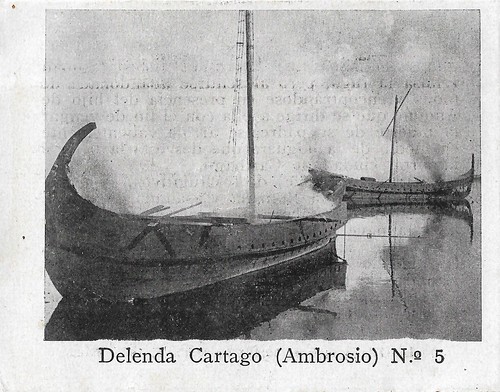
Spanish minicard, no. 5. Photo: Ambrosio. Scene from Delenda Carthago! (Tragedia dell'età antica) (Luigi Maggi, 1914).
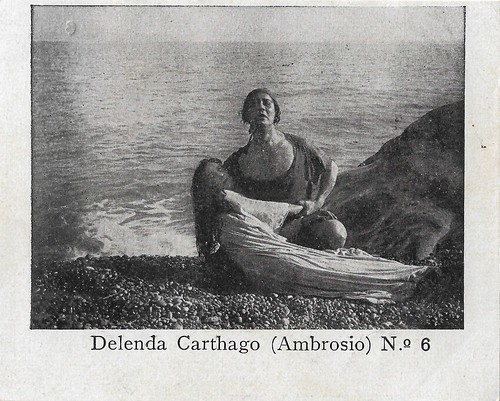
Spanish minicard, no. 6. Photo: Ambrosio. Eugenia Tettono Fior as Miarka in Delenda Carthago! (Tragedia dell'età antica) (Luigi Maggi, 1914).
Sources: Aldo Bernardini (Cinema muto italiano protagonisti), Vittorio Martinelli (Il cinema muto italiano, 1914, I), The Moving Picture World (via IMDb), and IMDb. NB. The Moving Picture World makes a hodgepodge of the Italian names of the characters.

Spanish minicard, no. 1. Photo: Ambrosio. Eugenia Tettono Fior as Miarka and François-Paul Donadio as Shabarim in Delenda Carthago! (Tragedia dell'età antica) (Luigi Maggi, 1914).

Spanish minicard, no. 2. Photo: Ambrosio. Scen from Delenda Carthago! (Tragedia dell'età antica) (Luigi Maggi, 1914).
François-Paul Donadio and Eugenia Tettoni
François-Paul Donadio was an Argentine [?] actor who played in Italian silent cinema between 1914 and 1921. In his first years, Donadio was a regular actor of the troupe at Ambrosio Film, acting in films such as Delenda Carthago! (Tragedia dell'età antica) (Luigi Maggi, 1914), and Romanticismo (Carlo Campogalliani, Arrigo Frusta, 1915) starring Tullio Carminati and Helena Makowska .
In 1916 followed Zvani (Gino Zaccaria 1916) starring Rita Jolivet , Monna Vanna (Mario Caserini, 1916) starring Madeleine Céliat , and Val d'olivi/Valley of the Olive Trees (1916) again starring Carminati and Makowska. In the late 1910s he acted with Helena Makowska in such films as Il principe Zilah (1919), and Folgore (1919) at Gladiator Film.
Donadio made his last films at Rodolfi Film, where he was often directed by Guido Brignone. He co-starred with Lola Visconti Brignone in Fiamma nera (1921), and with Mercedes Brignone in Il quadro di Osvaldo Mars (1921). He also acted in one of Carlo Aldini 's earliest films, Ajax (Raimondo Scotti, 1921). All in all, Donadio acted in a little over 30 films.
Eugenia Tettoni (1882-1969) was born in Turin. She started her career at Milano Films, together with her husband, actor Vittorio Tettoni, as Calypso (other sources say Penelope) in L'Odissea (Giuseppe De Liguoro, 1911). She acted in various Milano Film short productions in 1911-1912 and changed to the Ambrosio company in 1913, where she played in features, e.g. as Jone in Gli ultimi giorni di Pompei/The Last Days of Pompei (Eleuterio Rodolfi, 1913), the nun of Monza in I promessi sposi/The Betrothed (Eleuterio Rodolfi, 1913), and Josephine de Beauharnais in Epopea napoleonica (Edoardo Bencivenga, 1914).
Also memorable was her part of the adulterous Elena Loredano in Il fornaretto di Venezia (Luigi Maggi, 1914). Until 1921 Tettoni had a steady but not intense career in Italian silent film, mostly in supporting parts, at companies such as Savoia, Corona, Photo-Drama, Vay, and Audax. From 1922 she only acted on stage, with her by then ex-husband Vittorio Tettoni.

Spanish minicard, no. 3. Photo: Ambrosio. Eugenia Tettono Fior as Miarka and François-Paul Donadio as Shabarim in Delenda Carthago! (Tragedia dell'età antica) (Luigi Maggi, 1914).

Spanish minicard, no. 4. Photo: Ambrosio. Scene from Delenda Carthago! (Tragedia dell'età antica) (Luigi Maggi, 1914).
Some historical and literary elements and much fantasy
The plot of Delenda Carthago!/The Destruction of Carthage (1914) has some historical and literary elements, e.g. Flaubert's 'Salammbô', but also contains much fantasy. In ancient times Rome looked upon Carthage as her greatest rival and determined to plan her downfall. Cato (Umberto Scalpellini), a Roman Senator, appeals to the Senate to conquer Carthage, and under a pretext that she had failed to keep the faith, the Romans begin a new war.
The Roman army led by Scipio (Marcel Fabre) embarks for Africa and lands near Carthage. This ends the prologue. When General Hasdrubal (Luigi Chiesa) sees from the city walls the retreat of the Carthaginian mercenaries led by Hanno (Annone), he conspires to cause the downfall of Hanno. He induces the city council to bar the mercenary troops from the town, fearing disorder and plundering. Messengers are dispatched to the warriors with this command, and they rebel, but Hanno calms them by promising to present their grievances. Hasdrubal denounces Hanno, and upon the latter's appearance in the Senate, he is assassinated.
Miarka (Eugenia Tettoni), daughter of Hasdrubal, is harassed when going to the Temple of Tanit, but Hanno's lieutenant Shabarim (François-Paul Donadio), defends her and escorts her to the city. The impatient warriors start an uproar outside the city, but Hasdrubal calms them, consenting to receive a deputation with their grievances. Shabarim heads the delegation and is received by Hasdrubal, who apparently yields to the soldiers' request. Upon beholding Shabarim, Miarka's stepmother and Hasdrubal's wife Zamah falls in love with him, but he rejects her, after which she condemns him to the galleys. Meanwhile, Scipio conquers Carthage. Hasdrubal deserts his followers and flees to his galleys with his daughter.
Zamah, however, refuses to desert the palace and is killed. death. The Roman fleet pursues Hasdrubal's galleys and defeats them, Hasdrubal being killed in the melee. Miarka discovers Shabarim chained in the ship's hold and succeeds in breaking the chain. He in turn rescues her from the raging flames and, throwing her overboard, jumps after her, leaving the galley to burn to the water's edge. Both lovers succeed in reaching the shore and are reunited once more while witnessing the burning of Carthage in the distance.

Spanish minicard, no. 5. Photo: Ambrosio. Scene from Delenda Carthago! (Tragedia dell'età antica) (Luigi Maggi, 1914).

Spanish minicard, no. 6. Photo: Ambrosio. Eugenia Tettono Fior as Miarka in Delenda Carthago! (Tragedia dell'età antica) (Luigi Maggi, 1914).
Sources: Aldo Bernardini (Cinema muto italiano protagonisti), Vittorio Martinelli (Il cinema muto italiano, 1914, I), The Moving Picture World (via IMDb), and IMDb. NB. The Moving Picture World makes a hodgepodge of the Italian names of the characters.
Published on July 13, 2021 22:00
July 12, 2021
Betty Stockfeld
Betty Stockfeld (1904–1966), her name often misspelled as Stockfield, was an Australian film actress, who appeared mostly in British and French films.
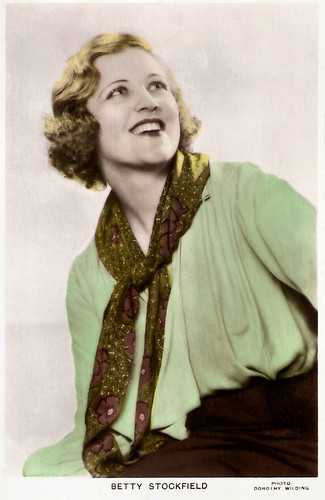
British postcard in the Colourgraph Series, London, no. C 130. Photo: Dorothy Wilding.
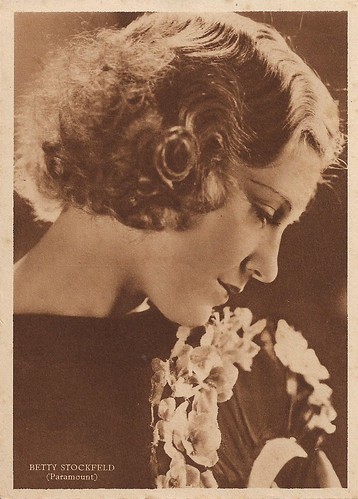
Italian postcard by Rizzoli & C., Milano, 1940. Photo: Paramount.
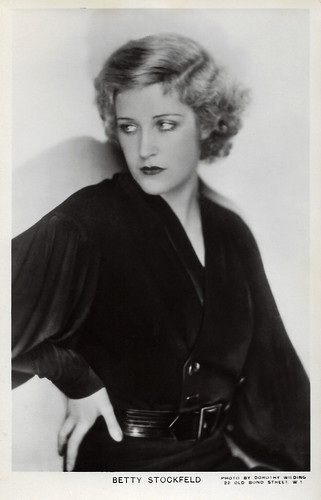
British postcard. Photo: Dorothy Wilding.
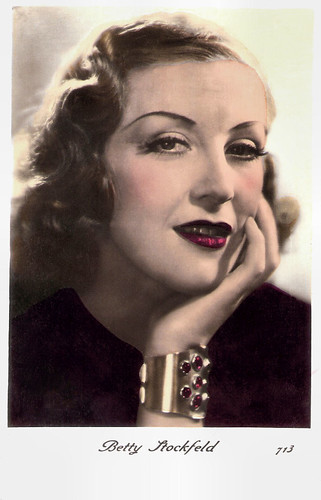
French postcard, no. 713.
Unable to return to Australia
Betty Stockfeld was born in 1904 in Australia. Betty was the daughter of Sydney businessman Harry Hooper Stockfeld and Susan Elizabeth Stockfeld, née Evans, and supposedly a niece of commander F. Pryce Evans of Shackleton's Nimrod expedition.
The family was in London at the outbreak of the First World War in 1914, so unable to return to Australia. Stockfeld was educated in France and did the London School of Dramatic Art, before debuting on stage.
In 1929 Betty Stockfeld debuted on the London stage in the Ben Levy comedy 'Art and Mrs. Bottle', starring Irene Vanbrugh.
In 1931 she had her breakthrough opposite Polish singer/actor Jan Kiepura in the film City of Song by Carmine Gallone, set in a.o. Naples and London. It was the British version of Gallone's German film Die singende Stadt in which Brigitte Helm played Stockfeld's part.
Betty played Claire Winter, a rich English woman who travels to Naples seeking distraction. She finds it in her Italian guide, who has such a voice for singing she decides to make him famous, taking him with her to London and offering help for an operatic career.
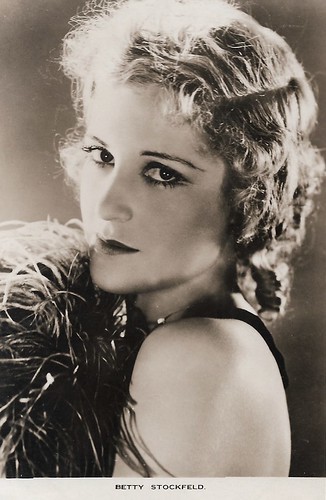
British postcard by Film Weekly, London.
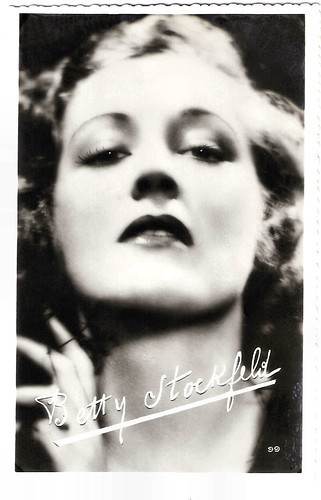
French postcard by Editions et Publications Cinématographiques (EPC), no. 99.
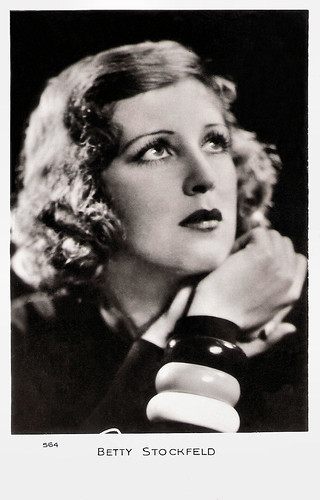
French postcard, no. 564.
Light entertainment films in Great Britain and France
Betty Stockfeld had a prolific career in British sound cinema. From 1932 she worked at the Ealing studios, BIP, and British & Dominion Film.
As she was also fluent in French, she worked in the French sound cinema too. First, she acted in Blanc comme neige/White like snow (Jean Choux et.al., 1931) with Bourvil , and from 1932 at the Paris Paramount studios.
Thanks to her bilingual training, she acted in both the French film Le roi des palaces (Carmine Gallone, 1932) with Jules Berry and the English version King of the Ritz (Carmine Gallonee, Herbert Smith, 1933) with Stanley Lupino, and also in Le vagabond bien-aimé/The Beloved Vagabond (both by Curtis Bernhardt, 1936) and both starring Maurice Chevalier .
All through the 1930s, Stockfeld was active in Britain and France in mostly light entertainment films, e.g. in French comedies with Lucien Baroux , Fernand Gravey , and Danielle Darrieux , and in Britain opposite e.g. Owen Nares , Tyrell Davis, and Gordon Harker .
In 1939, Betty Stockfeld acted in one Italian film: Frenesia/Frenzy (Mario Bonnard, 1939) starring the two old monstres sacré of the Italian stage, Dina Galli and Antonio Gandusio . In the same year she also acted in Les neuf célibataires/Nine Bachelors (Sacha Guitry, 1939), Son oncle de Normandie/His Uncle from Normandy (Jean Dréville, 1939), Derrière la façade/Behod the facade (Georges Lacombe, Yves Mirande, 1939), and Les gangsters du château d'If/The gangsters of Castle d'If (René Pujol, 1939).
In 1940 she still did three films in France before the war broke out. Yet, despite the indication on the Italian postcard above of Paramount, Stockfeld made no film for Paramount in 1939-1940, neither as a production company nor as a distribution company.
After 1942 she was away from the sets, but from 1950 she returned in 5 films and a few TV series between 1950 and 1961, including Jacques Becker's Edouard et Caroline/Edward and Caroline (1951) starring Daniel Gélin and Anne Vernon and Les amants du Tage/The Lovers of Lisbon (Henri Verneuil, 1954) with Daniel Gélin and Françoise Arnoul .
Betty Stockfeld died of leukemia in Tadworth, Surrey, in 1966.
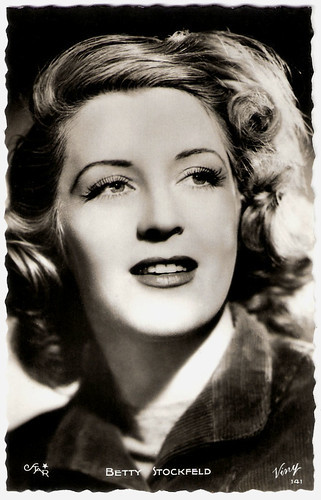
French postcard by Viny, no. 141. Photo: Star.
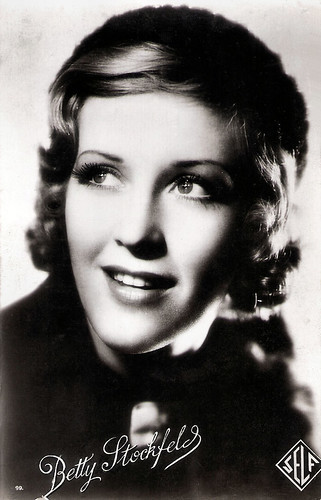
French postcard by Editions et Publications Cinematographiques (EPC), no. 99. Photo: Self.
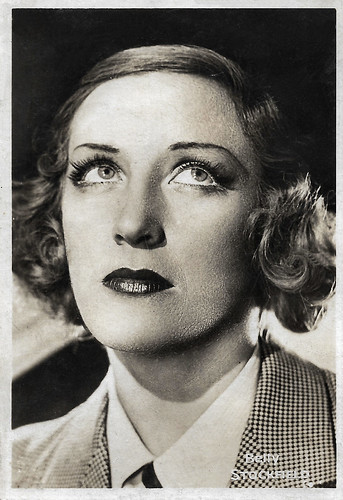
Vintage collectors card.
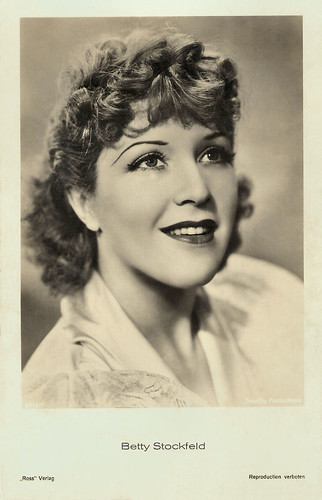
German postcard by Ross Verlag, no. 9512/1, 1935-1936. Photo: Toeplitz Productions. Betty Stockfeld in Le vagabond bien-aimé/The Beloved Vagabond (Curtis Bernhardt, 1936).
Sources: Seeking Betty, Wikipedia (French and English), and IMDb.

British postcard in the Colourgraph Series, London, no. C 130. Photo: Dorothy Wilding.

Italian postcard by Rizzoli & C., Milano, 1940. Photo: Paramount.

British postcard. Photo: Dorothy Wilding.

French postcard, no. 713.
Unable to return to Australia
Betty Stockfeld was born in 1904 in Australia. Betty was the daughter of Sydney businessman Harry Hooper Stockfeld and Susan Elizabeth Stockfeld, née Evans, and supposedly a niece of commander F. Pryce Evans of Shackleton's Nimrod expedition.
The family was in London at the outbreak of the First World War in 1914, so unable to return to Australia. Stockfeld was educated in France and did the London School of Dramatic Art, before debuting on stage.
In 1929 Betty Stockfeld debuted on the London stage in the Ben Levy comedy 'Art and Mrs. Bottle', starring Irene Vanbrugh.
In 1931 she had her breakthrough opposite Polish singer/actor Jan Kiepura in the film City of Song by Carmine Gallone, set in a.o. Naples and London. It was the British version of Gallone's German film Die singende Stadt in which Brigitte Helm played Stockfeld's part.
Betty played Claire Winter, a rich English woman who travels to Naples seeking distraction. She finds it in her Italian guide, who has such a voice for singing she decides to make him famous, taking him with her to London and offering help for an operatic career.

British postcard by Film Weekly, London.

French postcard by Editions et Publications Cinématographiques (EPC), no. 99.

French postcard, no. 564.
Light entertainment films in Great Britain and France
Betty Stockfeld had a prolific career in British sound cinema. From 1932 she worked at the Ealing studios, BIP, and British & Dominion Film.
As she was also fluent in French, she worked in the French sound cinema too. First, she acted in Blanc comme neige/White like snow (Jean Choux et.al., 1931) with Bourvil , and from 1932 at the Paris Paramount studios.
Thanks to her bilingual training, she acted in both the French film Le roi des palaces (Carmine Gallone, 1932) with Jules Berry and the English version King of the Ritz (Carmine Gallonee, Herbert Smith, 1933) with Stanley Lupino, and also in Le vagabond bien-aimé/The Beloved Vagabond (both by Curtis Bernhardt, 1936) and both starring Maurice Chevalier .
All through the 1930s, Stockfeld was active in Britain and France in mostly light entertainment films, e.g. in French comedies with Lucien Baroux , Fernand Gravey , and Danielle Darrieux , and in Britain opposite e.g. Owen Nares , Tyrell Davis, and Gordon Harker .
In 1939, Betty Stockfeld acted in one Italian film: Frenesia/Frenzy (Mario Bonnard, 1939) starring the two old monstres sacré of the Italian stage, Dina Galli and Antonio Gandusio . In the same year she also acted in Les neuf célibataires/Nine Bachelors (Sacha Guitry, 1939), Son oncle de Normandie/His Uncle from Normandy (Jean Dréville, 1939), Derrière la façade/Behod the facade (Georges Lacombe, Yves Mirande, 1939), and Les gangsters du château d'If/The gangsters of Castle d'If (René Pujol, 1939).
In 1940 she still did three films in France before the war broke out. Yet, despite the indication on the Italian postcard above of Paramount, Stockfeld made no film for Paramount in 1939-1940, neither as a production company nor as a distribution company.
After 1942 she was away from the sets, but from 1950 she returned in 5 films and a few TV series between 1950 and 1961, including Jacques Becker's Edouard et Caroline/Edward and Caroline (1951) starring Daniel Gélin and Anne Vernon and Les amants du Tage/The Lovers of Lisbon (Henri Verneuil, 1954) with Daniel Gélin and Françoise Arnoul .
Betty Stockfeld died of leukemia in Tadworth, Surrey, in 1966.

French postcard by Viny, no. 141. Photo: Star.

French postcard by Editions et Publications Cinematographiques (EPC), no. 99. Photo: Self.

Vintage collectors card.

German postcard by Ross Verlag, no. 9512/1, 1935-1936. Photo: Toeplitz Productions. Betty Stockfeld in Le vagabond bien-aimé/The Beloved Vagabond (Curtis Bernhardt, 1936).
Sources: Seeking Betty, Wikipedia (French and English), and IMDb.
Published on July 12, 2021 22:00
July 11, 2021
Douglas Fairbanks
Douglas Fairbanks (1883-1939) was an elegant, dashing, and athletic American actor who became legendary for his innovative swashbuckling roles in such silent classics as The Three Musketeers (1921), Robin Hood (1922), The Thief of Bagdad (1924), Don Q Son of Zorro (1925), The Black Pirate (1926) and The Iron Mask (1929). With his marriage to Mary Pickford in 1920, the couple became Hollywood royalty, and Fairbanks was referred to as ‘The King of Hollywood'. His career rapidly declined with the advent of the 'talkies’. He finished his film career in Europe, with the British production The Private Life of Don Juan (1934).
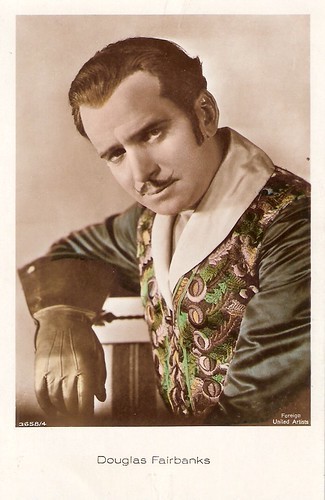
German postcard by Ross Verlag Foreign, no. 3658/4, 1928-1929. Photo: United Artists. Doug is wearing the outfit from Don Q, Son of Zorro (Donald Crisp, 1925).
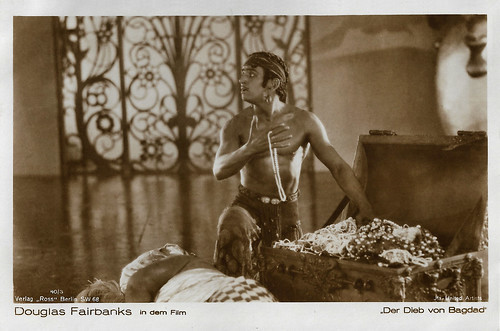
German postcard by Ross Verlag, Berlin, no. 40/3. Photo: IFA / United Artists. Douglas Fairbanks in The Thief of Bagdad (Raoul Walsh, 1924).
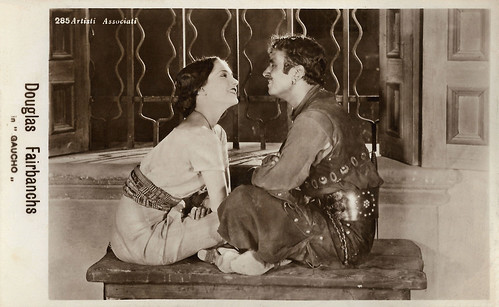
Italian postcard by G.B. Falci Editore, Milano, no. 285. Photo: United Artists. Douglas Fairbanks and Lupe Velez in The Gaucho (F. Richard Jones, 1927).
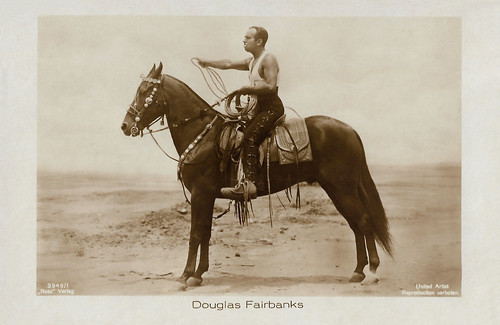
German postcard by Ross Verlag, no. 3949/1, 1928-1929. Photo: United Artists.
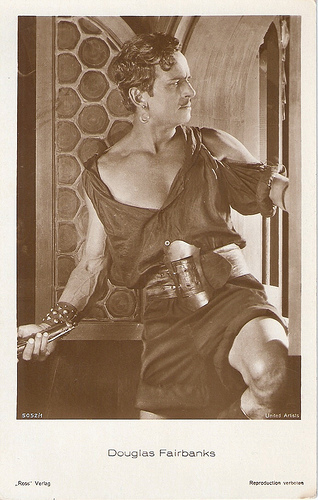
German postcard by Ross Verlag, no. 5052/1, 1930-1931. Photo: United Artists. Douglas Fairbanks in The Black Pirate (Albert Parker, 1926).
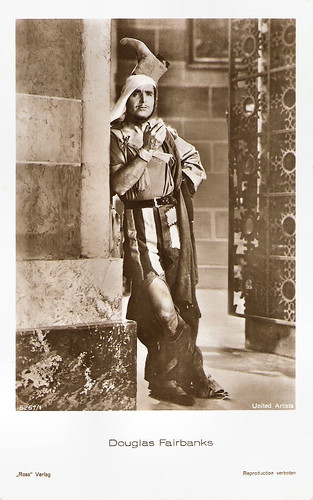
German postcard by Ross-Verlag, no. 5267/1, 1930-1931. Photo: K.O. Rahmn (Knut Olaf Rahmn) / United Artists. Douglas Fairbanks in The Taming of the Shrew (Sam Taylor, 1930).
Free-wheeling farces
Douglas Fairbanks was born Douglas Elton Thomas Ullman in 1883 in Denver, Colorado, the son of H. Charles Ullman, a prominent New York attorney, and ‘Southern belle’ Ella Adelaide Marsh. Ullman abandoned the family when Douglas was five years old and he and his older brother Robert were brought up by their mother, who gave them the family name Fairbanks, after her first husband.
Douglas Fairbanks began acting at an early age, in amateur theatre on the Denver stage, performing in summer stock, and becoming a sensation in the local theatre community. Fairbanks moved to New York to pursue an acting career. He joined the acting troupe of British actor Frederick Warde who had seen Fairbanks performing in Denver. In 1902, he made his Broadway debut as Florio in the Frederick Warde Company's production of The Duke's Jester.
In 1907, Fairbanks married Anna Beth Sully, the daughter of a wealthy industrialist. They had one son, Douglas Elton Fairbanks (1909), who later became known as the actor Douglas Fairbanks Jr. In 1915, the family moved to Los Angeles. The then 31-years old Fairbanks signed a contract with Triangle Pictures and began working under the supervision of D.W. Griffith .
His first film was titled The Lamb (W. Christy Cabanne, 1915), in which he debuted the athletic abilities that would gain him wide attention among theatre audiences. His athleticism was not appreciated by Griffith, however, and he was brought to the attention of Anita Loos and John Emerson, who wrote and directed many of his next films.
Fairbanks became the top moneymaker for Triangle, starring in an average of 10 pictures a year for a weekly salary of $2000. He specialised in comedies - not the slapstick variety, but free-wheeling farces in which he usually played a wealthy young man thirsting for adventure. In 1916, Fairbanks established his own company, the Douglas Fairbanks Film Corporation, and would soon get a job at Paramount. His films ranged from romances to wacky, madcap comedies, from social satires to Westerns.
At a party in 1916, Fairbanks met actress Mary Pickford , and the couple began an affair. In 1917, they joined Fairbanks's friend Charlie Chaplin selling war bonds by train across the U.S. Pickford and Chaplin were then the two highest-paid film stars in Hollywood. To curtail these stars' astronomical salaries, the large studios attempted to monopolise distributors and exhibitors. By 1918, Fairbanks was Hollywood's most popular actor, and within three years of his arrival, Fairbanks's popularity and business acumen raised him to the third-highest paid.
In late 1918, Sully was granted a divorce from Fairbanks, the judgment being finalised in early 1919. To avoid being controlled by the studios and to protect their independence, Fairbanks, Pickford, Chaplin, and D. W. Griffith formed United Artists in 1919, which created their own distributorship and gave them complete artistic control over their films and the profits generated. The company was kept solvent in the years immediately after its formation largely by the success of Fairbanks's films.
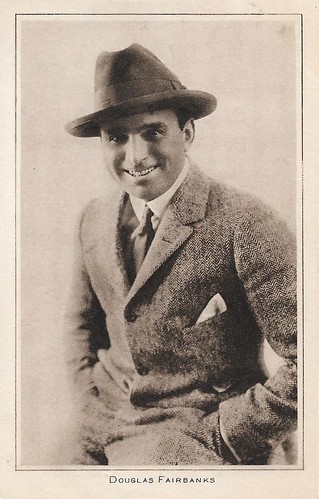
British postcard by "Pictures" Portrait Gallery, London, no. 107.
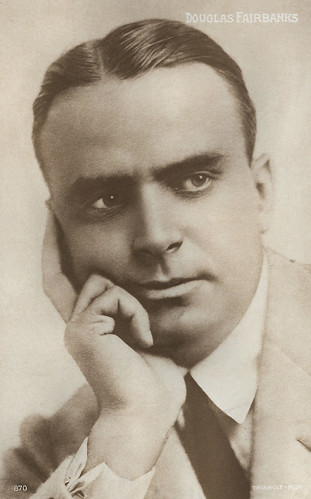
Swedish postcard by Förlag Nordisk Konst, Stockholm, no. 870. Photo: Triangle Film.
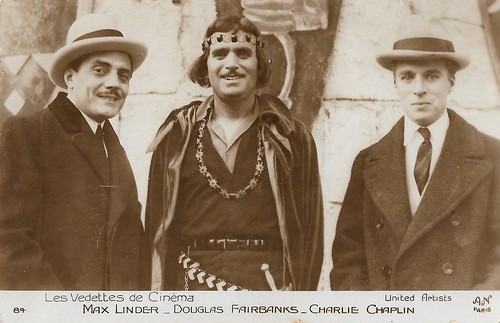
French postcard in the Les Vedettes de Cinéma series by A.N., Paris, no. 84. Photo: United Artists. Douglas Fairbanks on the set of Robin Hood (1922), with Charles Chaplin and Max Linder .
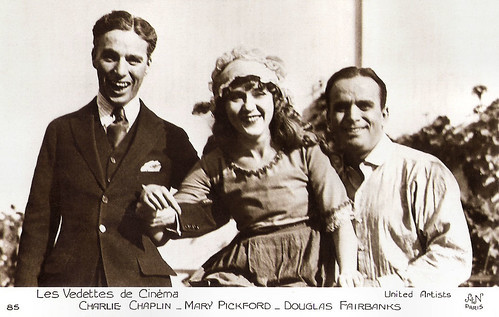
French postcard in the Les Vedettes de Cinéma series by A.N., Paris, no. 85. Photo: United Artists. Charles Chaplin , Mary Pickford , and Douglas Fairbanks.
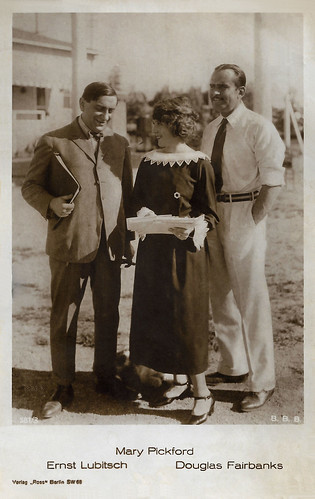
Charlie Chaplin , Ernst Lubitsch , Mary Pickford and Douglas Fairbanks. German postcard by Ross Verlag, no. 581/3, 1919-1924. Photo: B.B.B.
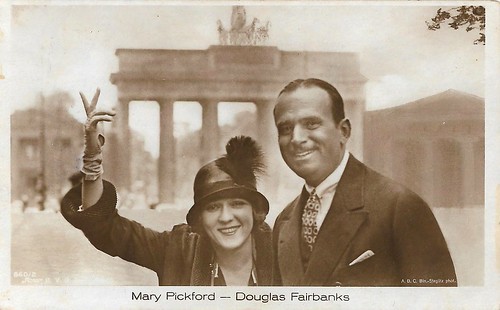
German postcard by Ross Verlag, no. 860/2, 1925-1926. Photo: A.B.C. Berlin-Steglitz. Douglas Fairbanks and Mary Pickford in Berlin. In 1926, Pickford and Fairbanks visited Berlin and stayed at the Hotel Adlon near the Brandenburg Gate, which is in the background of this picture.
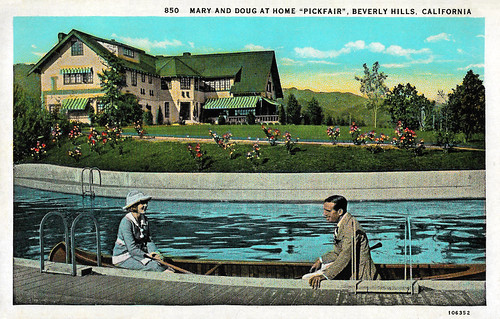
American postcard by the Western Publishing & Novelty Co., Los Angeles, Calif., no. 850. Caption: Mary and Doug at home 'Pickfair', Beverly Hills, California.
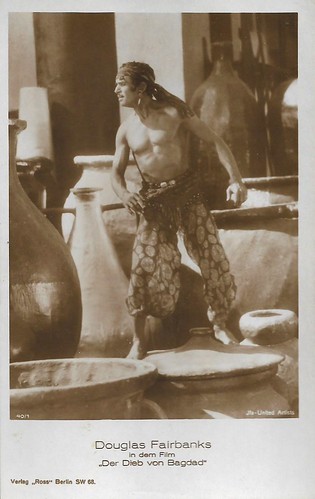
German postcard by Ross Verlag, Berlin, no. 40/1. Photo: IFA / United Artists. Douglas Fairbanks in The Thief of Bagdad (Raoul Walsh, 1924).
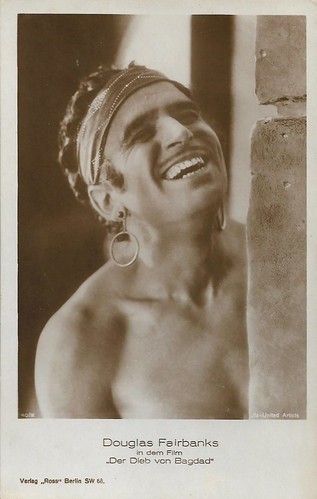
German postcard by Ross Verlag, Berlin, no. 40/2. Photo: IFA / United Artists. Douglas Fairbanks in The Thief of Bagdad (Raoul Walsh, 1924).
‘Everybody's Hero’ and ‘America's Sweetheart
Douglas Fairbanks was determined to have Mary Pickford become his wife, but she was still married to actor Owen Moore. He finally gave her an ultimatum. She then obtained a fast divorce in the small Nevada town of Minden and the couple married in 1920. The public went wild over the idea of ‘Everybody's Hero’ marrying ‘America's Sweetheart’. They were greeted by large crowds in London, Amsterdam, and Paris during their European honeymoon, becoming Hollywood's first celebrity couple. Fairbanks and Pickford were regarded as ‘Hollywood Royalty’, famous for entertaining at their 42-room mansion in Beverly Hills, Pickfair.
By 1920, Fairbanks had completed twenty-nine films (twenty-eight features and one two-reel short), which showcased his ebullient screen persona and athletic ability. Fairbanks had been a comic in his previous films, but by 1920, he had the inspiration of staging a new type of adventure-costume picture, a genre that was then out of favour with the public.
In The Mark of Zorro (Fred Niblo, 1920), Fairbanks combined his appealing screen persona with the new adventurous costume element. This genre-defining Swashbuckler adventure was the first film version of 'The Mark of Zorro'. It was a smashing success and parlayed the actor into the rank of superstar.
For the remainder of his career in silent films, Fairbanks continued to produce and star in ever more elaborate, impressive costume films, such as The Three Musketeers (Fred Niblo, 1921), Robin Hood (Allan Dwan, 1922), The Thief of Bagdad (Raoul Walsh, 1924), The Black Pirate (Albert Parker, 1926, the first full-length Technicolor film), and The Gaucho (F. Richard Jones, 1927) with Lupe Velez .
Fairbanks spared no expense and effort in these films, which established the standard for all future swashbuckling films. In 1921, he, Mary Pickford , Charles Chaplin , and others, helped to organise the Motion Picture Fund to assist those in the industry who could not work, or were unable to meet their bills. During the first ceremony of its type, in 1927, Fairbanks and Pickford placed their hand and footprints in wet cement at the newly opened Grauman's Chinese Theatre in Hollywood. Fairbanks was elected first President of the Motion Picture Academy of Arts and Sciences that same year, and he presented the first Academy Awards at the Roosevelt Hotel. Today, Fairbanks also has a star on the Hollywood Walk of Fame at 7020 Hollywood Boulevard.
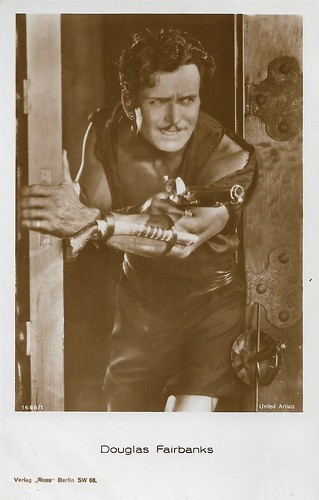
German postcard by Ross Verlag, no. 1686/1, 1927-1928. Photo: United Artists. Douglas Fairbanks in The Black Pirate (Albert Parker, 1926).
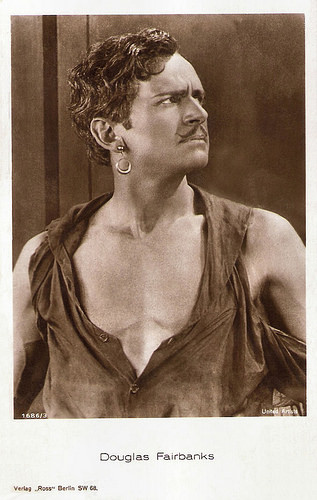
German postcard by Ross-Verlag, no. 1686/3, 1927-1928. Photo: United Artists. Douglas Fairbanks in The Black Pirate (Albert Parker, 1926).
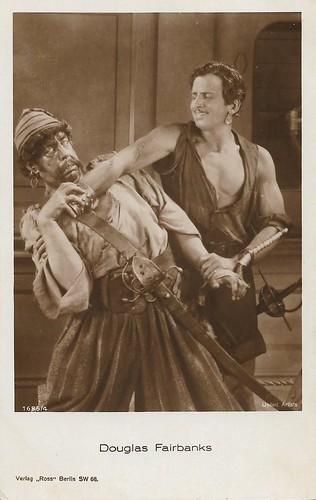
German postcard by Ross Verlag, no. 1686/4, 1927-1928. Photo: United Artists. Douglas Fairbanks in The Black Pirate (Albert Parker, 1926).
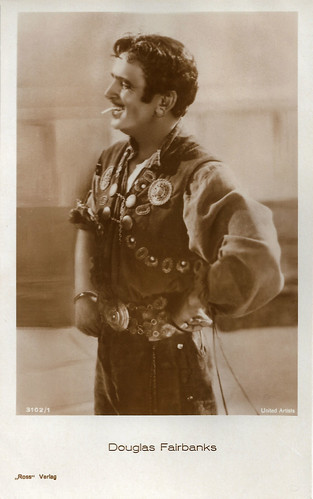
German postcard by Ross Verlag, no. 3102/1, 1928-1929. Photo: United Artists. Douglas Fairbanks in The Gaucho (F. Richard Jones, 1927).
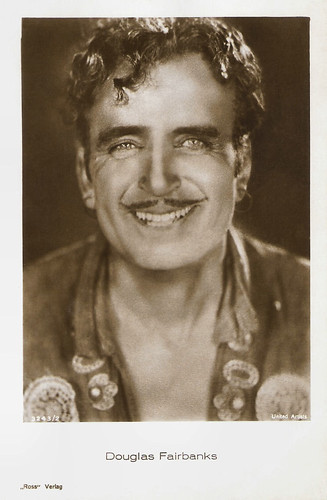
German postcard by Ross Verlag, no. 3243/2, 1928-1929. Photo: United Artists. Douglas Fairbanks in The Gaucho (F. Richard Jones, 1927).
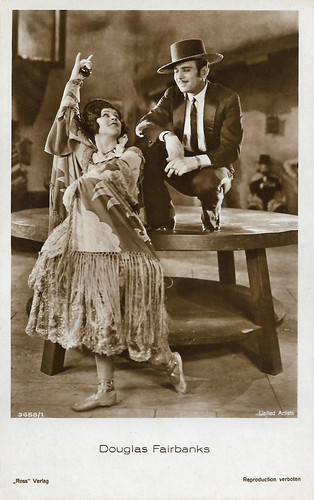
German postcard by Ross Verlag, no. 3658/1, 1928-1929. Photo: United Artists. Douglas Fairbanks and Juliette Belanger in Don Q Son of Zorro (Donald Crisp, 1925).
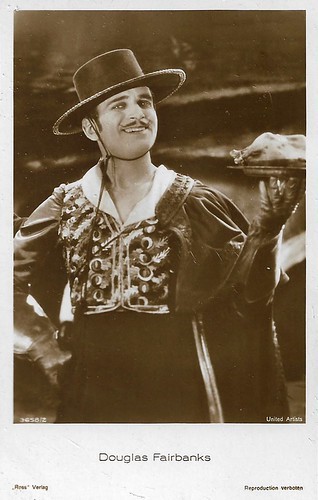
German postcard by Ross Verlag, no. 3658/2, 1928-1929. Photo: United Artists. Douglas Fairbanks in Don Q, Son of Zorro (Donald Crisp, 1925).
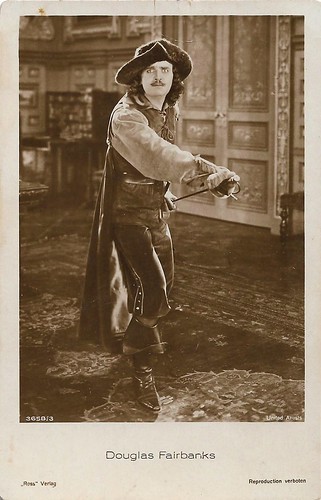
German postcard by Ross Verlag, no. 3658/3, 1928-1929. Photo: United Artists. The card depicts a moment in The Three Musketeers (Fred Niblo, 1921), but stems from the time when Fairbanks made the sequel to The Three Musketeers: The Iron Mask (Allan Dwan, 1929).
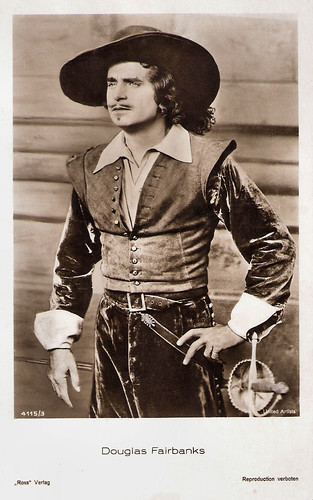
German postcard by Ross Verlag, no. 4115/3, 1929-1930. Photo: United Artists. Douglas Fairbanks in The Iron Mask (Allan Dwan, 1929).
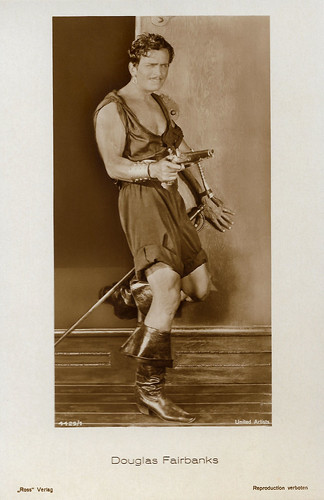
German postcard by Ross Verlag, no. 4429/1, 1929-1930. Photo: United Artists. Douglas Fairbanks in The Black Pirate (Albert Parker, 1926).
Colossal Disaster
While Douglas Fairbanks had flourished in the silent genre, the restrictions of early sound films dulled his enthusiasm for film-making. He was 44 years old, and could no longer look the part of the youthful swashbuckler or romantic lead, nor could he safely perform the dangerous stunts his audiences expected of him.
In 1929, at Pickford's bungalow, United Artists brought together Pickford, Fairbanks, Charles Chaplin , Norma Talmadge , Gloria Swanson , John Barrymore, D.W. Griffith , and Dolores del Rio to speak on the radio show 'The Dodge Brothers Hour' to prove Fairbanks could meet the challenge of talking movies.
Fairbanks's last silent film was the lavish The Iron Mask (Allan Dwan, 1929), a sequel to The Three Musketeers (Fred Niblo, 1921). The Iron Mask included an introductory prologue spoken by Fairbanks. He and Pickford chose to make their first talkie as a joint venture, playing Petruchio and Kate in William Shakespeare's The Taming of the Shrew (Sam Taylor, 1929). The film was a colossal disaster, and the pair fought constantly during its making. When it flopped at the box office, Doug and Mary blamed each other.
Doug’s subsequent sound films were also poorly received by Depression-era audiences. The last film in which he acted, was the British production The Private Life of Don Juan (Alexander Korda, 1934), with Merle Oberon . The film is a revealing look at the life of the aging Don Juan, whose reputation has outrun him. The film, based on the 1920 play 'L'homme à la Rose' by Henry Bataille, was made by Alexander Korda's London Film Productions at Elstree Studios and distributed by United Artists under an agreement Korda had recently signed with them.
Fairbanks and Pickford separated in 1933 after he began an affair with Sylvia, Lady Ashley. They divorced in 1936, with Pickford keeping the Pickfair estate. Within months Fairbanks and Ashley were married in Paris. He continued to be marginally involved in the film industry and was disturbed by the new direction of his own company, United Artists, now under the iron fist of Samuel Goldwyn. His health continued to decline, and in his final years, he lived in Santa Monica, California, although much of his time was spent traveling abroad with Sylvia. At the end of 1939, Fairbanks had a mild heart attack. He died later that day at his home in Santa Monica. He was 56. Fairbanks's famous last words were "I've never felt better".
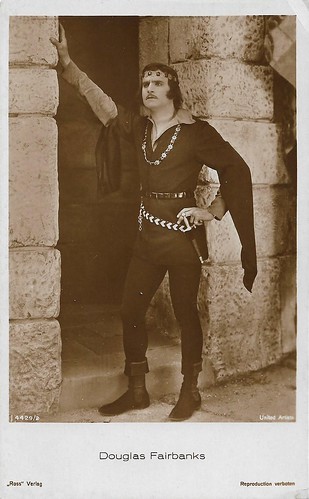
German postcard by Ross Verlag, no. 4429/2, 1929-1930. Photo: United Artists. Douglas Fairbanks in Robin Hood (1922).
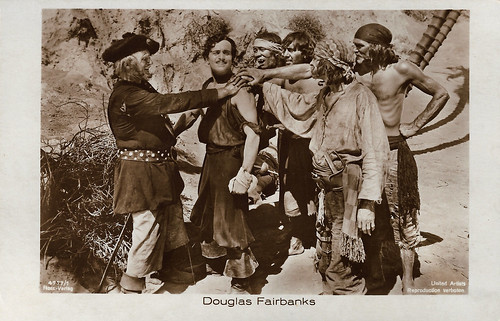
German postcard by Ross Verlag, no. 4777/1, 1929-1930. Photo: United Artists. Douglas Fairbanks in The Black Pirate (Albert Parker, 1926).
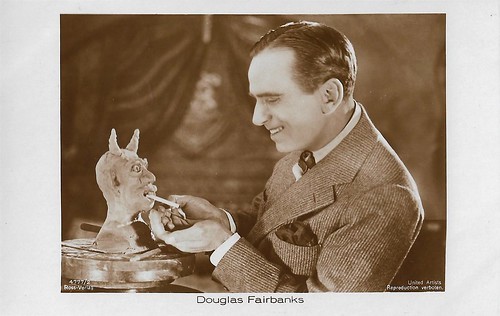
German postcard by Ross Verlag, no. 4777/2, 1929-1930. Photo: United Artists.
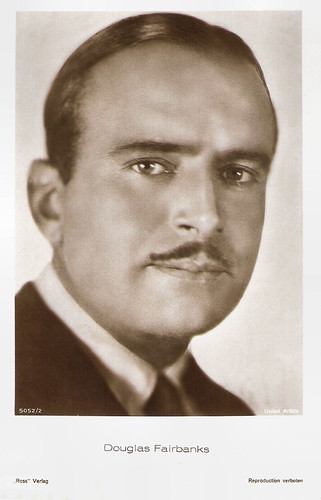
German postcard by Ross-Verlag, no. 5052/2, 1930-1931. Photo: United Artists.
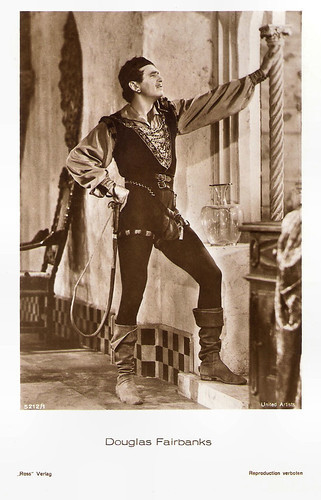
German postcard by Ross-Verlag, no. 5212/1, 1930-1931. Photo: K.O. Rahmn (Knut Olaf Rahmn) / United Artists. Douglas Fairbanks in The Taming of the Shrew (Sam Taylor, 1930).
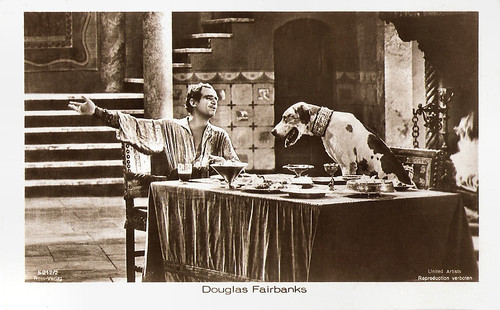
German postcard by Ross-Verlag, no. 5212/2, 1930-1931. Photo: K.O. Rahmn (Knut Olaf Rahmn) / United Artists. Douglas Fairbanks in The Taming of the Shrew (Sam Taylor, 1930).
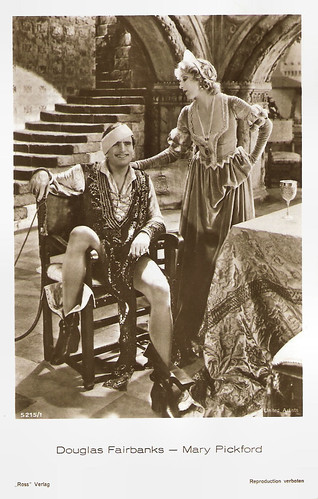
German postcard by Ross-Verlag, no. 5215/1 1930-1931. Photo: K.O. Rahmn (Knut Olaf Rahmn) / United Artists. Douglas Fairbanks and Mary Pickford in The Taming of the Shrew (Sam Taylor, 1930).
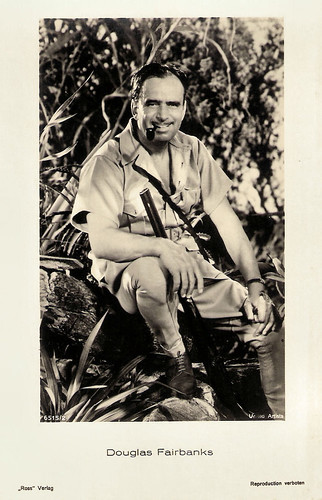
German postcard by Ross-Verlag, no. 6515/2, 1931-1932. Photo: United Artists. Douglas Fairbanks in Mr. Robinson Crusoe (Edward Sutherland, 1932).
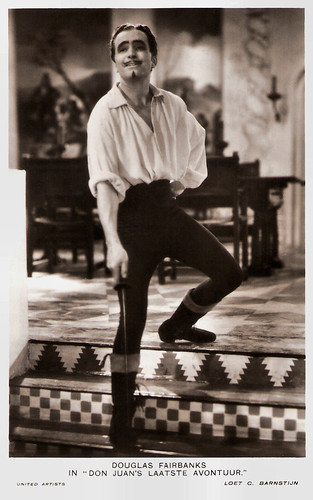
Dutch postcard. Photo: Loet C. Barnstijn / United Artists. Douglas Fairbanks in The Private Life of Don Juan (Alexander Korda, 1934).
Sources: Hal Erickson (AllMovie), (IMDb), The Douglas Fairbanks Museum, Wikipedia, and

German postcard by Ross Verlag Foreign, no. 3658/4, 1928-1929. Photo: United Artists. Doug is wearing the outfit from Don Q, Son of Zorro (Donald Crisp, 1925).

German postcard by Ross Verlag, Berlin, no. 40/3. Photo: IFA / United Artists. Douglas Fairbanks in The Thief of Bagdad (Raoul Walsh, 1924).

Italian postcard by G.B. Falci Editore, Milano, no. 285. Photo: United Artists. Douglas Fairbanks and Lupe Velez in The Gaucho (F. Richard Jones, 1927).

German postcard by Ross Verlag, no. 3949/1, 1928-1929. Photo: United Artists.

German postcard by Ross Verlag, no. 5052/1, 1930-1931. Photo: United Artists. Douglas Fairbanks in The Black Pirate (Albert Parker, 1926).

German postcard by Ross-Verlag, no. 5267/1, 1930-1931. Photo: K.O. Rahmn (Knut Olaf Rahmn) / United Artists. Douglas Fairbanks in The Taming of the Shrew (Sam Taylor, 1930).
Free-wheeling farces
Douglas Fairbanks was born Douglas Elton Thomas Ullman in 1883 in Denver, Colorado, the son of H. Charles Ullman, a prominent New York attorney, and ‘Southern belle’ Ella Adelaide Marsh. Ullman abandoned the family when Douglas was five years old and he and his older brother Robert were brought up by their mother, who gave them the family name Fairbanks, after her first husband.
Douglas Fairbanks began acting at an early age, in amateur theatre on the Denver stage, performing in summer stock, and becoming a sensation in the local theatre community. Fairbanks moved to New York to pursue an acting career. He joined the acting troupe of British actor Frederick Warde who had seen Fairbanks performing in Denver. In 1902, he made his Broadway debut as Florio in the Frederick Warde Company's production of The Duke's Jester.
In 1907, Fairbanks married Anna Beth Sully, the daughter of a wealthy industrialist. They had one son, Douglas Elton Fairbanks (1909), who later became known as the actor Douglas Fairbanks Jr. In 1915, the family moved to Los Angeles. The then 31-years old Fairbanks signed a contract with Triangle Pictures and began working under the supervision of D.W. Griffith .
His first film was titled The Lamb (W. Christy Cabanne, 1915), in which he debuted the athletic abilities that would gain him wide attention among theatre audiences. His athleticism was not appreciated by Griffith, however, and he was brought to the attention of Anita Loos and John Emerson, who wrote and directed many of his next films.
Fairbanks became the top moneymaker for Triangle, starring in an average of 10 pictures a year for a weekly salary of $2000. He specialised in comedies - not the slapstick variety, but free-wheeling farces in which he usually played a wealthy young man thirsting for adventure. In 1916, Fairbanks established his own company, the Douglas Fairbanks Film Corporation, and would soon get a job at Paramount. His films ranged from romances to wacky, madcap comedies, from social satires to Westerns.
At a party in 1916, Fairbanks met actress Mary Pickford , and the couple began an affair. In 1917, they joined Fairbanks's friend Charlie Chaplin selling war bonds by train across the U.S. Pickford and Chaplin were then the two highest-paid film stars in Hollywood. To curtail these stars' astronomical salaries, the large studios attempted to monopolise distributors and exhibitors. By 1918, Fairbanks was Hollywood's most popular actor, and within three years of his arrival, Fairbanks's popularity and business acumen raised him to the third-highest paid.
In late 1918, Sully was granted a divorce from Fairbanks, the judgment being finalised in early 1919. To avoid being controlled by the studios and to protect their independence, Fairbanks, Pickford, Chaplin, and D. W. Griffith formed United Artists in 1919, which created their own distributorship and gave them complete artistic control over their films and the profits generated. The company was kept solvent in the years immediately after its formation largely by the success of Fairbanks's films.

British postcard by "Pictures" Portrait Gallery, London, no. 107.

Swedish postcard by Förlag Nordisk Konst, Stockholm, no. 870. Photo: Triangle Film.

French postcard in the Les Vedettes de Cinéma series by A.N., Paris, no. 84. Photo: United Artists. Douglas Fairbanks on the set of Robin Hood (1922), with Charles Chaplin and Max Linder .

French postcard in the Les Vedettes de Cinéma series by A.N., Paris, no. 85. Photo: United Artists. Charles Chaplin , Mary Pickford , and Douglas Fairbanks.

Charlie Chaplin , Ernst Lubitsch , Mary Pickford and Douglas Fairbanks. German postcard by Ross Verlag, no. 581/3, 1919-1924. Photo: B.B.B.

German postcard by Ross Verlag, no. 860/2, 1925-1926. Photo: A.B.C. Berlin-Steglitz. Douglas Fairbanks and Mary Pickford in Berlin. In 1926, Pickford and Fairbanks visited Berlin and stayed at the Hotel Adlon near the Brandenburg Gate, which is in the background of this picture.

American postcard by the Western Publishing & Novelty Co., Los Angeles, Calif., no. 850. Caption: Mary and Doug at home 'Pickfair', Beverly Hills, California.

German postcard by Ross Verlag, Berlin, no. 40/1. Photo: IFA / United Artists. Douglas Fairbanks in The Thief of Bagdad (Raoul Walsh, 1924).

German postcard by Ross Verlag, Berlin, no. 40/2. Photo: IFA / United Artists. Douglas Fairbanks in The Thief of Bagdad (Raoul Walsh, 1924).
‘Everybody's Hero’ and ‘America's Sweetheart
Douglas Fairbanks was determined to have Mary Pickford become his wife, but she was still married to actor Owen Moore. He finally gave her an ultimatum. She then obtained a fast divorce in the small Nevada town of Minden and the couple married in 1920. The public went wild over the idea of ‘Everybody's Hero’ marrying ‘America's Sweetheart’. They were greeted by large crowds in London, Amsterdam, and Paris during their European honeymoon, becoming Hollywood's first celebrity couple. Fairbanks and Pickford were regarded as ‘Hollywood Royalty’, famous for entertaining at their 42-room mansion in Beverly Hills, Pickfair.
By 1920, Fairbanks had completed twenty-nine films (twenty-eight features and one two-reel short), which showcased his ebullient screen persona and athletic ability. Fairbanks had been a comic in his previous films, but by 1920, he had the inspiration of staging a new type of adventure-costume picture, a genre that was then out of favour with the public.
In The Mark of Zorro (Fred Niblo, 1920), Fairbanks combined his appealing screen persona with the new adventurous costume element. This genre-defining Swashbuckler adventure was the first film version of 'The Mark of Zorro'. It was a smashing success and parlayed the actor into the rank of superstar.
For the remainder of his career in silent films, Fairbanks continued to produce and star in ever more elaborate, impressive costume films, such as The Three Musketeers (Fred Niblo, 1921), Robin Hood (Allan Dwan, 1922), The Thief of Bagdad (Raoul Walsh, 1924), The Black Pirate (Albert Parker, 1926, the first full-length Technicolor film), and The Gaucho (F. Richard Jones, 1927) with Lupe Velez .
Fairbanks spared no expense and effort in these films, which established the standard for all future swashbuckling films. In 1921, he, Mary Pickford , Charles Chaplin , and others, helped to organise the Motion Picture Fund to assist those in the industry who could not work, or were unable to meet their bills. During the first ceremony of its type, in 1927, Fairbanks and Pickford placed their hand and footprints in wet cement at the newly opened Grauman's Chinese Theatre in Hollywood. Fairbanks was elected first President of the Motion Picture Academy of Arts and Sciences that same year, and he presented the first Academy Awards at the Roosevelt Hotel. Today, Fairbanks also has a star on the Hollywood Walk of Fame at 7020 Hollywood Boulevard.

German postcard by Ross Verlag, no. 1686/1, 1927-1928. Photo: United Artists. Douglas Fairbanks in The Black Pirate (Albert Parker, 1926).

German postcard by Ross-Verlag, no. 1686/3, 1927-1928. Photo: United Artists. Douglas Fairbanks in The Black Pirate (Albert Parker, 1926).

German postcard by Ross Verlag, no. 1686/4, 1927-1928. Photo: United Artists. Douglas Fairbanks in The Black Pirate (Albert Parker, 1926).

German postcard by Ross Verlag, no. 3102/1, 1928-1929. Photo: United Artists. Douglas Fairbanks in The Gaucho (F. Richard Jones, 1927).

German postcard by Ross Verlag, no. 3243/2, 1928-1929. Photo: United Artists. Douglas Fairbanks in The Gaucho (F. Richard Jones, 1927).

German postcard by Ross Verlag, no. 3658/1, 1928-1929. Photo: United Artists. Douglas Fairbanks and Juliette Belanger in Don Q Son of Zorro (Donald Crisp, 1925).

German postcard by Ross Verlag, no. 3658/2, 1928-1929. Photo: United Artists. Douglas Fairbanks in Don Q, Son of Zorro (Donald Crisp, 1925).

German postcard by Ross Verlag, no. 3658/3, 1928-1929. Photo: United Artists. The card depicts a moment in The Three Musketeers (Fred Niblo, 1921), but stems from the time when Fairbanks made the sequel to The Three Musketeers: The Iron Mask (Allan Dwan, 1929).

German postcard by Ross Verlag, no. 4115/3, 1929-1930. Photo: United Artists. Douglas Fairbanks in The Iron Mask (Allan Dwan, 1929).

German postcard by Ross Verlag, no. 4429/1, 1929-1930. Photo: United Artists. Douglas Fairbanks in The Black Pirate (Albert Parker, 1926).
Colossal Disaster
While Douglas Fairbanks had flourished in the silent genre, the restrictions of early sound films dulled his enthusiasm for film-making. He was 44 years old, and could no longer look the part of the youthful swashbuckler or romantic lead, nor could he safely perform the dangerous stunts his audiences expected of him.
In 1929, at Pickford's bungalow, United Artists brought together Pickford, Fairbanks, Charles Chaplin , Norma Talmadge , Gloria Swanson , John Barrymore, D.W. Griffith , and Dolores del Rio to speak on the radio show 'The Dodge Brothers Hour' to prove Fairbanks could meet the challenge of talking movies.
Fairbanks's last silent film was the lavish The Iron Mask (Allan Dwan, 1929), a sequel to The Three Musketeers (Fred Niblo, 1921). The Iron Mask included an introductory prologue spoken by Fairbanks. He and Pickford chose to make their first talkie as a joint venture, playing Petruchio and Kate in William Shakespeare's The Taming of the Shrew (Sam Taylor, 1929). The film was a colossal disaster, and the pair fought constantly during its making. When it flopped at the box office, Doug and Mary blamed each other.
Doug’s subsequent sound films were also poorly received by Depression-era audiences. The last film in which he acted, was the British production The Private Life of Don Juan (Alexander Korda, 1934), with Merle Oberon . The film is a revealing look at the life of the aging Don Juan, whose reputation has outrun him. The film, based on the 1920 play 'L'homme à la Rose' by Henry Bataille, was made by Alexander Korda's London Film Productions at Elstree Studios and distributed by United Artists under an agreement Korda had recently signed with them.
Fairbanks and Pickford separated in 1933 after he began an affair with Sylvia, Lady Ashley. They divorced in 1936, with Pickford keeping the Pickfair estate. Within months Fairbanks and Ashley were married in Paris. He continued to be marginally involved in the film industry and was disturbed by the new direction of his own company, United Artists, now under the iron fist of Samuel Goldwyn. His health continued to decline, and in his final years, he lived in Santa Monica, California, although much of his time was spent traveling abroad with Sylvia. At the end of 1939, Fairbanks had a mild heart attack. He died later that day at his home in Santa Monica. He was 56. Fairbanks's famous last words were "I've never felt better".

German postcard by Ross Verlag, no. 4429/2, 1929-1930. Photo: United Artists. Douglas Fairbanks in Robin Hood (1922).

German postcard by Ross Verlag, no. 4777/1, 1929-1930. Photo: United Artists. Douglas Fairbanks in The Black Pirate (Albert Parker, 1926).

German postcard by Ross Verlag, no. 4777/2, 1929-1930. Photo: United Artists.

German postcard by Ross-Verlag, no. 5052/2, 1930-1931. Photo: United Artists.

German postcard by Ross-Verlag, no. 5212/1, 1930-1931. Photo: K.O. Rahmn (Knut Olaf Rahmn) / United Artists. Douglas Fairbanks in The Taming of the Shrew (Sam Taylor, 1930).

German postcard by Ross-Verlag, no. 5212/2, 1930-1931. Photo: K.O. Rahmn (Knut Olaf Rahmn) / United Artists. Douglas Fairbanks in The Taming of the Shrew (Sam Taylor, 1930).

German postcard by Ross-Verlag, no. 5215/1 1930-1931. Photo: K.O. Rahmn (Knut Olaf Rahmn) / United Artists. Douglas Fairbanks and Mary Pickford in The Taming of the Shrew (Sam Taylor, 1930).

German postcard by Ross-Verlag, no. 6515/2, 1931-1932. Photo: United Artists. Douglas Fairbanks in Mr. Robinson Crusoe (Edward Sutherland, 1932).

Dutch postcard. Photo: Loet C. Barnstijn / United Artists. Douglas Fairbanks in The Private Life of Don Juan (Alexander Korda, 1934).
Sources: Hal Erickson (AllMovie), (IMDb), The Douglas Fairbanks Museum, Wikipedia, and
Published on July 11, 2021 22:00
July 10, 2021
Les misérables
Before 'Les Misérables' became "the world's most popular musical", there were several other stage and film adaptations of the famous novel by Victor Hugo. In this post, we will give you an overview of the many versions. Next week we will present a post on - in our opinion - the best film version of Hugo's masterpiece.

French postcard by Croissant, Paris, no. 3664. Photo: Film Pathé. Publicity still for Le chemineau/The Tramp (Albert Capellani, 1905), based on the first part of 'Les misérables' in which Jean Valjean, who was granted lodging by the parish priest of a village, stole several silver candlesticks and escapes the arrest thanks to the false testimony of the priest. Unclear is who the actors are, but the sets were by Hugues Laurent. The film appeared in the 'Scènes dramatiques et réalistes (8ème Série)' by Pathé.

French postcard by Croissant, Paris, no. 3664. Photo: Film Pathé. Publicity still for Le chemineau/The Tramp (Albert Capellani, 1905), based on the first part of 'Les misérables'.
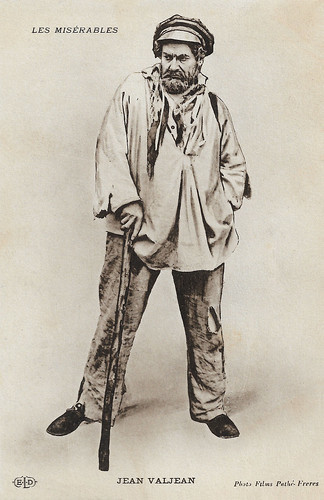
French postcard by ELD. Photo: Films Pathé-Frères. Henry Krauss as Jean Valjean in Les Misérables (Albert Capellani, 1913). Sent by mail in 1916. In this two-part silent film version, Henri Étiévant played Javert and Mistinguett appeared as Éponine Thénardier.
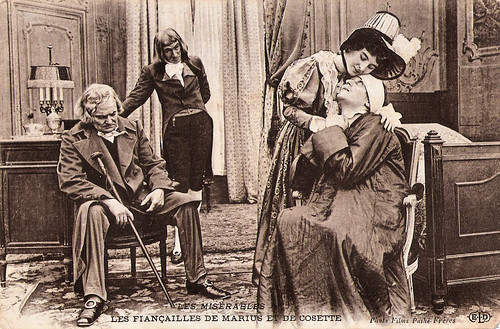
French postcard by E.L.D. Photo: Films Pathé Frères. Publicity still for Les Miserables (Albert Capellani, 1913), with Henry Krauss (left) as Jean Valjean, Léon Lérand as Gillesnormand, Marialise as Cosette, and Gabriel de Gravone as Marius. Caption: Les fiançailles de Marius et de Cosette (The betrothal of Marius and Cosette).
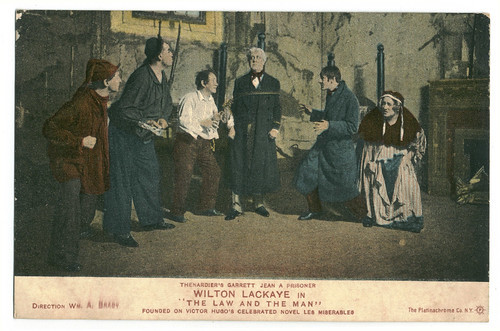
American postcard by the Platinachrome Company, New York. Wilton Lackaye in the stage production 'The Law and the Man' (1906-1907), directed by Wilton Lackaye and produced by William A. Brady. Collection: Manuel Palomino Arjona @ Flickr. The play was written by Lackaye, "founded on Victor Hugo's celebrated novel 'Les Misérables'". 'The Law and the Man' was presented at the Manhattan Theatre in New York from 20 December till February 1905 and counted 54 performances.
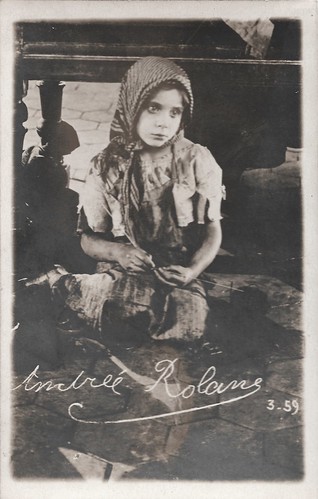
French postcard, no. 3.59. Andrée Rolane as Cosette in Les Misérables (Henri Fescourt, 1925). In this French silent film version Gabriel Gabrio starred as Jean Valjean.

French postcard by A.N., Paris, no. 927. Photo Pathé Natan. Harry Baur as Jean Valjean in the 4½-hour French version Les Misérables (Raymond Bernard, 1934).

French postcard by A.N., Paris, no. 931. Photo Pathé Natan. Emile Génevois as Gavroche in Les Misérables (Raymond Bernard, 1934).
A force for good in the world that cannot escape his criminal past
'Les Misérables' began as a French historical novel by Victor Hugo, first published in 1862. Hugo's 'Les Misérables' is one of the greatest novels of the 19th century. Beginning in 1815 and culminating in the 1832 June Rebellion in Paris, the novel follows the lives and interactions of several characters, particularly the struggles of ex-convict Jean Valjean and his experience of redemption.
Hugo wrote towards the end in his novel that 'Les Misérables' is "a progress from evil to good, from injustice to justice, from falsehood to truth, from night to day, from appetite to conscience, from corruption to life; from bestiality to duty, from hell to heaven, from nothingness to God." Jean Valjean becomes a force for good in the world but cannot escape his criminal past. The novel as a whole is one of the longest ever written, with 655,478 words in the original French version. Hugo divided 'Les Misérables' into five volumes, each volume divided into several books, and subdivided into chapters, for a total of 48 books and 365 chapters. Each chapter is relatively short, commonly no longer than a few pages.
The appearance of the novel was a highly anticipated event as Victor Hugo was considered one of France's foremost poets in the middle of the nineteenth century. Critical reactions were wide-ranging and often negative. Some critics found the subject matter immoral, others complained of its excessive sentimentality, and others were disquieted by its apparent sympathy with the revolutionaries. The work was a commercial success and has been a popular book ever since it was published. Translated the same year it appeared in several foreign languages, it proved popular not only in France but around the world.
Since its original publication, 'Les Misérables' has been the subject of a large number of adaptations in numerous types of media, such as books, films, musicals, plays, and even games. Notable examples of these adaptations include the 1937 radio adaptation by Orson Welles , the 1980 stage musical, and the 2007 TV anime adaptation, by Studio Nippon Animation. The original French musical by Claude-Michel Schönberg (music), Alain Boublil and Jean-Marc Natel (original French lyrics), and Herbert Kretzmer (English lyrics) premiered in Paris in 1980 under the direction of Robert Hossein . Its English-language adaptation by producer Cameron Mackintosh has been running in London since October 1985, making it the longest-running musical in the West End.
And of course, there were many film and television adaptations, including the 1978 television film adaptation, starring Richard Jordan and Anthony Perkins, the 1982 film adaptation, directed by Robert Hossein , starring Lino Ventura and Michel Bouquet, the 1995 film, by Claude Lelouch, starring Jean-Paul Belmondo, the 1998 film, starring Liam Neeson and Geoffrey Rush, the 2000 TV miniseries, starring Gérard Depardieu and John Malkovich, and a 2018 British TV series by Andrew Davies, starring Dominic West, David Oyelowo and Lily Collins.
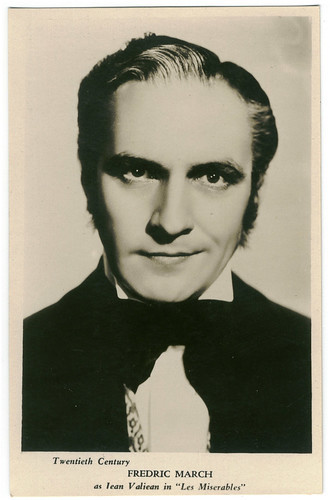
British postcard by Film weekly. Photo: Twentieth Century. Fredric March as Jean Valjean / Champmathieu in Les Misérables (Richard Boleslawski, 1935). Collection: Manuel Palomino Arjona @ Flickr. The film was nominated for Best Picture, Best Film Editing, and Best Assistant Director at the 8th Academy Awards.
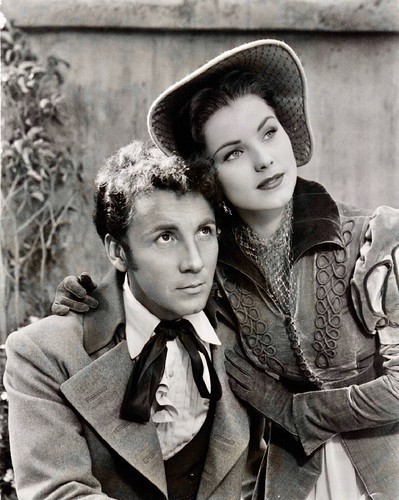
Cameron Mitchell as Marius and Debra Paget as Cosette in Les Miserables (Lewis Milestone, 1952). Collection: Tommy A. @ Flickr.
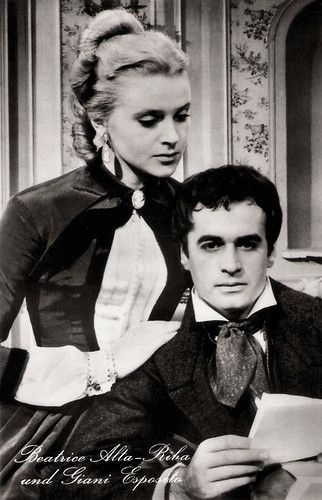
East-German postcard by VEB Progress Film-Vertrieb, no. 951, 1958. Photo: DEFA. Béatrice Altariba as Cosette and Giani Esposito as Marius in Les misérables (Jean-Paul Le Chanois, 1958). The film was a co-production of DEFA (East-Germany), P.A.C. (France), Serena (Italy) and Société Nouvelle Pathé Cinéma (France). This version had an international cast starring Jean Gabin, Bernard Blier, and Bourvil. Called "the most memorable film version", it was filmed in East Germany and was overtly political.
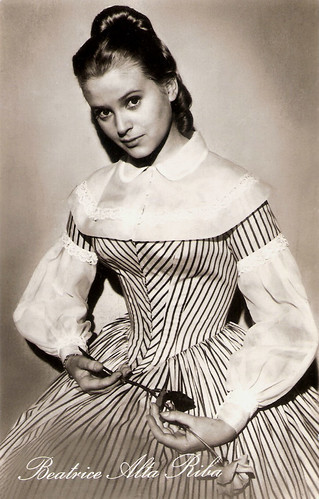
East-German postcard by VEB Progress Film-Vertrieb, no. 141/576, 1959. Photo: DEFA / Corbeau. Béatrice Altariba as Cosette in Les misérables (Jean-Paul Le Chanois, 1958).
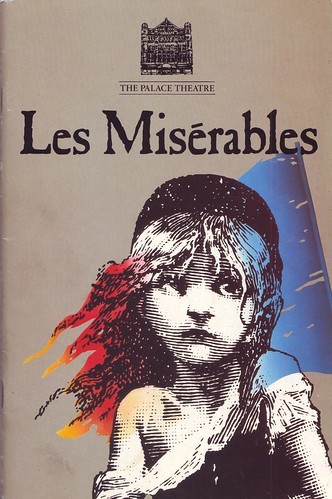
Stage musical 'Les Misérables', directed by Trevor Nunn & John Caird at The Palace Theatre, London, in 1985. Collection: Manuel Palomino Arjona @ Flickr.
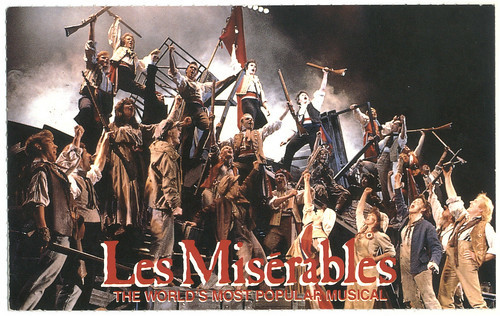
Stage musical 'Les Misérables' at the Kallang Theatre in Singapore in 1994. Caption: "Les Misérables. The world's most popular musical." Collection: Manuel Palomino Arjona @ Flickr.
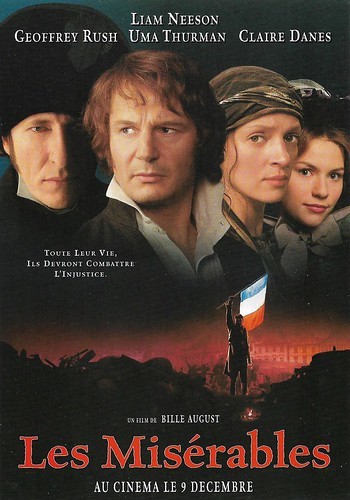
French postcard for the film Les Misérables (Bille August, 1998), starring Liam Neeson as Jean Valjean, Geoffrey Rush as Javert, Uma Thurman as Fantine, and Claire Danes as Cosette. The film was a British-American-German coproduction.
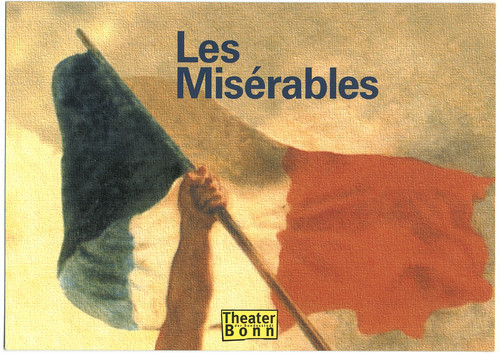
'Les Misérables' by Claude-Michel Schönberg & Alain Boublil in Theater (der Bundesstadt) Bonn (2003). Collection: Manuel Palomino Arjona @ Flickr.
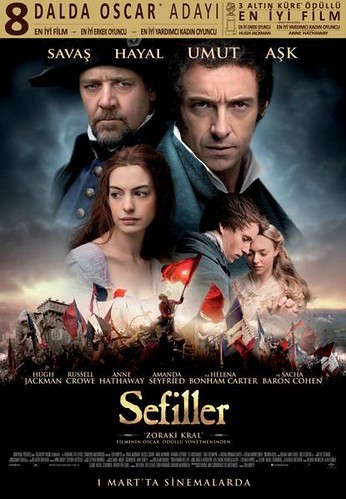
Turkish poster for Les Misérables (Tom Hooper, 2012), starring Hugh Jackson as Jean Valjean and Russell Crowe as Javert. The film was based on the original stage musical 'Les Misérables' by Claude-Michel Schönberg & Alain Boublil. Collection: Sinema Tutkusu @ Flickr.
Sources: Wikipedia, IBDB, and IMDb.

French postcard by Croissant, Paris, no. 3664. Photo: Film Pathé. Publicity still for Le chemineau/The Tramp (Albert Capellani, 1905), based on the first part of 'Les misérables' in which Jean Valjean, who was granted lodging by the parish priest of a village, stole several silver candlesticks and escapes the arrest thanks to the false testimony of the priest. Unclear is who the actors are, but the sets were by Hugues Laurent. The film appeared in the 'Scènes dramatiques et réalistes (8ème Série)' by Pathé.

French postcard by Croissant, Paris, no. 3664. Photo: Film Pathé. Publicity still for Le chemineau/The Tramp (Albert Capellani, 1905), based on the first part of 'Les misérables'.

French postcard by ELD. Photo: Films Pathé-Frères. Henry Krauss as Jean Valjean in Les Misérables (Albert Capellani, 1913). Sent by mail in 1916. In this two-part silent film version, Henri Étiévant played Javert and Mistinguett appeared as Éponine Thénardier.

French postcard by E.L.D. Photo: Films Pathé Frères. Publicity still for Les Miserables (Albert Capellani, 1913), with Henry Krauss (left) as Jean Valjean, Léon Lérand as Gillesnormand, Marialise as Cosette, and Gabriel de Gravone as Marius. Caption: Les fiançailles de Marius et de Cosette (The betrothal of Marius and Cosette).

American postcard by the Platinachrome Company, New York. Wilton Lackaye in the stage production 'The Law and the Man' (1906-1907), directed by Wilton Lackaye and produced by William A. Brady. Collection: Manuel Palomino Arjona @ Flickr. The play was written by Lackaye, "founded on Victor Hugo's celebrated novel 'Les Misérables'". 'The Law and the Man' was presented at the Manhattan Theatre in New York from 20 December till February 1905 and counted 54 performances.

French postcard, no. 3.59. Andrée Rolane as Cosette in Les Misérables (Henri Fescourt, 1925). In this French silent film version Gabriel Gabrio starred as Jean Valjean.

French postcard by A.N., Paris, no. 927. Photo Pathé Natan. Harry Baur as Jean Valjean in the 4½-hour French version Les Misérables (Raymond Bernard, 1934).

French postcard by A.N., Paris, no. 931. Photo Pathé Natan. Emile Génevois as Gavroche in Les Misérables (Raymond Bernard, 1934).
A force for good in the world that cannot escape his criminal past
'Les Misérables' began as a French historical novel by Victor Hugo, first published in 1862. Hugo's 'Les Misérables' is one of the greatest novels of the 19th century. Beginning in 1815 and culminating in the 1832 June Rebellion in Paris, the novel follows the lives and interactions of several characters, particularly the struggles of ex-convict Jean Valjean and his experience of redemption.
Hugo wrote towards the end in his novel that 'Les Misérables' is "a progress from evil to good, from injustice to justice, from falsehood to truth, from night to day, from appetite to conscience, from corruption to life; from bestiality to duty, from hell to heaven, from nothingness to God." Jean Valjean becomes a force for good in the world but cannot escape his criminal past. The novel as a whole is one of the longest ever written, with 655,478 words in the original French version. Hugo divided 'Les Misérables' into five volumes, each volume divided into several books, and subdivided into chapters, for a total of 48 books and 365 chapters. Each chapter is relatively short, commonly no longer than a few pages.
The appearance of the novel was a highly anticipated event as Victor Hugo was considered one of France's foremost poets in the middle of the nineteenth century. Critical reactions were wide-ranging and often negative. Some critics found the subject matter immoral, others complained of its excessive sentimentality, and others were disquieted by its apparent sympathy with the revolutionaries. The work was a commercial success and has been a popular book ever since it was published. Translated the same year it appeared in several foreign languages, it proved popular not only in France but around the world.
Since its original publication, 'Les Misérables' has been the subject of a large number of adaptations in numerous types of media, such as books, films, musicals, plays, and even games. Notable examples of these adaptations include the 1937 radio adaptation by Orson Welles , the 1980 stage musical, and the 2007 TV anime adaptation, by Studio Nippon Animation. The original French musical by Claude-Michel Schönberg (music), Alain Boublil and Jean-Marc Natel (original French lyrics), and Herbert Kretzmer (English lyrics) premiered in Paris in 1980 under the direction of Robert Hossein . Its English-language adaptation by producer Cameron Mackintosh has been running in London since October 1985, making it the longest-running musical in the West End.
And of course, there were many film and television adaptations, including the 1978 television film adaptation, starring Richard Jordan and Anthony Perkins, the 1982 film adaptation, directed by Robert Hossein , starring Lino Ventura and Michel Bouquet, the 1995 film, by Claude Lelouch, starring Jean-Paul Belmondo, the 1998 film, starring Liam Neeson and Geoffrey Rush, the 2000 TV miniseries, starring Gérard Depardieu and John Malkovich, and a 2018 British TV series by Andrew Davies, starring Dominic West, David Oyelowo and Lily Collins.

British postcard by Film weekly. Photo: Twentieth Century. Fredric March as Jean Valjean / Champmathieu in Les Misérables (Richard Boleslawski, 1935). Collection: Manuel Palomino Arjona @ Flickr. The film was nominated for Best Picture, Best Film Editing, and Best Assistant Director at the 8th Academy Awards.

Cameron Mitchell as Marius and Debra Paget as Cosette in Les Miserables (Lewis Milestone, 1952). Collection: Tommy A. @ Flickr.

East-German postcard by VEB Progress Film-Vertrieb, no. 951, 1958. Photo: DEFA. Béatrice Altariba as Cosette and Giani Esposito as Marius in Les misérables (Jean-Paul Le Chanois, 1958). The film was a co-production of DEFA (East-Germany), P.A.C. (France), Serena (Italy) and Société Nouvelle Pathé Cinéma (France). This version had an international cast starring Jean Gabin, Bernard Blier, and Bourvil. Called "the most memorable film version", it was filmed in East Germany and was overtly political.

East-German postcard by VEB Progress Film-Vertrieb, no. 141/576, 1959. Photo: DEFA / Corbeau. Béatrice Altariba as Cosette in Les misérables (Jean-Paul Le Chanois, 1958).

Stage musical 'Les Misérables', directed by Trevor Nunn & John Caird at The Palace Theatre, London, in 1985. Collection: Manuel Palomino Arjona @ Flickr.

Stage musical 'Les Misérables' at the Kallang Theatre in Singapore in 1994. Caption: "Les Misérables. The world's most popular musical." Collection: Manuel Palomino Arjona @ Flickr.

French postcard for the film Les Misérables (Bille August, 1998), starring Liam Neeson as Jean Valjean, Geoffrey Rush as Javert, Uma Thurman as Fantine, and Claire Danes as Cosette. The film was a British-American-German coproduction.

'Les Misérables' by Claude-Michel Schönberg & Alain Boublil in Theater (der Bundesstadt) Bonn (2003). Collection: Manuel Palomino Arjona @ Flickr.

Turkish poster for Les Misérables (Tom Hooper, 2012), starring Hugh Jackson as Jean Valjean and Russell Crowe as Javert. The film was based on the original stage musical 'Les Misérables' by Claude-Michel Schönberg & Alain Boublil. Collection: Sinema Tutkusu @ Flickr.
Sources: Wikipedia, IBDB, and IMDb.
Published on July 10, 2021 22:00
Paul van Yperen's Blog
- Paul van Yperen's profile
- 13 followers
Paul van Yperen isn't a Goodreads Author
(yet),
but they
do have a blog,
so here are some recent posts imported from
their feed.



